

SeaFair Mega Yacht
Miami’s most exclusive and glamorous vessel, the $40m internationally acclaimed seafair mega yacht..

Venue Description
The 222-ft, $40M SeaFair Mega Yacht is the largest commercial operation ship in the Intercoastal waterway. This uber lux mega yacht offers the ultimate excursion experience; where sea and sky converge with iconic Miami’s unique glamour.
Designed by the internationally acclaimed yacht designer Luis De Basto, the SeaFair Yacht’s multi faceted event spaces make it one of the most sought-after event venues available. So when is the best time to come aboard this mega yacht? That’s a no brainer! The July 4th Party Cruise, Halloween, and New Year’s Eve Fireworks Cruise are all action packed and, moreover, never a disappointment. And if you still have questions; head to our Contact Info to connect with us. We have highly trained Miami Nightlife pros standing by and ready to help you, 24/7. We’d love to hear from you!
When you choose VIP Nightlife to plan a night out; you don’t have to know anything about the SeaFair Miami MEGA Yacht to have the time of your life. With years of experience, our team can take your ideas from an inspiration to a fully executed, once-in-a-lifetime occasion. We will create an event experience for your every need and can service groups of all sizes; up to 1000 or more. So if you are looking to put a nautical spin on your next day or night out in Miami; then let us show you the way! And be sure to Like Us on Facebook so you can keep up with our Upcoming Events and Deals.
Quick Facts
• Panoramic Views of Miami Skyline. • Two-level nightclub and dance floor with Top 40 hits. • Indoor-Outdoor Reception Area with Private Wet Bar and Private Restroom. Set with white lounge furniture and a built-in bar; the ultimate area for entertaining up to 180 guests. • Ultra Plush Captain’s Lounge on Main Deck with Private Bar and 80” Flat-screen, Entire Lounge LED Lit. Accommodates up to 155 persons. • Beautiful private outdoor LUXE lounge with bar and cocktail Area. Largest indoor area offers indoor Zen-inspired garden, accented with live green walls and bamboo. • Bamboo Ballroom with Access to Luxe Lounge and elevator, 1 Video Screen, Entire Room Led Lit. Accommodates up to 220 persons. • Garden Ballroom Reception area for large Groups w/ 2 Video screens, Entire Room LED Lit. Accommodates up to 240 persons. • Elegant glass-walled ballroom with 360° water views, a built-in bar with a LED backdrop, white accent walls with LED curtains and private elevator access.
Click To View Current Weather in Miami. Still have questions? Head to our Contact Info to connect.
• Open Air Sea-View Deck with Private Bar. Spectacular views of Biscayne Bay and Downtown Miami that will WOW guests with an unforgettable experience. • Sky Deck: 4th Deck with 5,300 sq feet. Dance under the stars with 300 people while enjoying best views Miami has to offer. • Forward Sky Deck: Accommodates up to 200 persons. Open Air Sea/Bow View Deck with LED Lit Bar. Cocktail Reception Area. • 3rd Deck Reception Floor: Artistically designed “grand” reception area with video screen and bow access.
Parking Info
The SeaFair Miami is docked at the Bayfront Park South Dock at Chopin Plaza in downtown Miami adjacent to the InterContinental Hotel. Convenient self parking is available along Chopin Plaza, Biscayne Boulevard, and in multiple parking garages. Downtown Metromover is within walking distance.
Related events

Saturday Miami Pool Party | Hyde Beach
Join us for Swim Club Saturdays, an unparalleled pool party experience for dayclub enthusiasts at…

Be prepared to have the time of your life. Check out Amazing Party at Zouk…

Be prepared to have the time of your life. Check out Amazing Party at Hakkasan…

Lil Jon (DJ Set)
Be prepared to have the time of your life. Check out Amazing Party at OMNIA…

Marquee Nightclub Saturday
Be prepared to have the time of your life. Check out Amazing Party at Marquee…

ADVERTISE HERE WITH US
Get Your Venue + Events Noticed
PIER PRESSURE PARTY YACHTS COMPLETE EVENTS GUIDE
SEARCH EVENTS
JOIN PIER PRESSURE TEAM
View list of availiable positions
FIND OUT MORE

Join our VIP List
Get the best deals & free tickets to events in your area!
Atlanta Austin Baltimore Baton Rouge Boston Charlotte Chicago Dallas Hoboken Houston Las Vegas Los Angeles Miami Montreal Nashville New York Orange County Philadelphia Phoenix Portland Raleigh San Diego San Francisco Seattle St. Louis Tampa Bay Toronto Vancouver Washington DC
SeaFair Mega Yacht Upcoming events
Bummer! There aren't any events
Check back another time
Image credit for Dr. Dre: © Kevin Mazur / Getty Images Entertainment / Getty Images
Image credit for Rihanna: © Samir Hussein / WireImage / Getty Images
Image credit for Owenn: © Francesco Prandoni / Getty Images Entertainment / Getty Images

New Year's Eve 2022 Miami Fireworks Party Cruise - Seafair Mega Yacht

VIP Nightlife & Miami Nightlife
present...
The Ultimate Miami NYE 2022
Gatsby's yacht, midnight fireworks viewing party.
New Year's Eve on the Bay!
Miami’s most exclusive and glamorous New Year’s event is aboard the internationally acclaimed SeaFair. The best view of the midnight Miami Orange rise and spectacular fireworks awaits on the Seafair SkyDeck.
Why settle for an average party boat, when you can live it up on a luxury mega yacht? After all, it's New Year's Eve; and you deserve only the best!
Celebrate 2022 in style aboard the SeaFair Miami ; a 222-foot, $40M uber lux mega yacht designed by the internationally acclaimed yacht designer Luis De Basto.
Times are subject to change pending Miami Curfews. Please make sure Eventbrite is marked as safe sender, you'll only be contacted via email.
Current Schedule & Perks are as follows:
- Early Check-in: 8:45 PM
- Platinum Admiral VIP Boarding: 9:00PM
- Golden GA Boarding: 9:15 PM
- Gate Closes at 10:15 PM (Do Not Be Late - No Refunds)
- Cruise: 10:30 PM - 2:00 AM
- Bayfront Fireworks Show at Midnight
- Disembark: 1:45 AM - 2:00 AM
Premium Open Bar
- Premium Brands for ALL
- Top Shelf Cocktails for VIPs
- Multiple Elegant Bars on Every Deck
- Welcome Bubbles and New Years Toast
LIMITED RESERVED VIP TABLES
- INCLUDE EXCLUSIVE AREAS WITH RESERVED SEATING
- WITH 3 BOTTLES OF DOM PERIGNON TO TOAST AT MIDNIGHT
- PRIVATE SERVERS & SECURITY
Delicious Gourmet Food
- Festive hors d'oeuvres
- Raw seafood bar
- A culinary array of global cuisine
Dazzling Entertainment
- Live DJ entertainment on multiple levels
- Spectacular Skydeck fireworks

Some Info to Know
Dress Code: Strict dress code enforced. Upscale, semi-formal, cocktail attire required for entrance. Men will not be allowed to wear ball caps, plain t-shirts, hi-tops or tennis shoes. If you do not meet the dress code, you may NOT be allowed to board and no refund will be given.
Parking: The SeaFair Miami is docked at Bayfront Park South Dock at Chopin Plaza in downtown Miami adjacent to the InterContinental Hotel. Convenient self parking is available along Chopin Plaza, Biscayne Boulevard, and in multiple parking garages. Downtown Metromover is within walking distance.
Please Note: This party cruise is expected to follow CDC Guidelines with social distancing and masks if & when necessary. All our staff will have necessary PPE for excellent clean service. If this event is canceled due to Covid-19, you will be refunded.
Fireworks may be canceled as well. There will be no refunds if fireworks are not held due to Covid-19. Times may change as well. You'll be notified if the cruise is earlier and no refunds will be granted unless event is canceled.
Disclaimer: If there are incremental weather conditions that cause the ship to not be able to sail safely, the party will still be held on the indoor levels dockside and the event will not be canceled. There will be no refunds unless event is canceled entirely.
Please let me know: https://www.seafairmiami.com/terms-of-service/
Questions? Please email: [email protected]. We look forward to celebrating with you responsibly.

VIP Nightlife New Year's Eve Menu
TRAY PASSED HORS D’OEUVRES
• Vegetable Spring Roll
• Broccoli Quiche
• Chicken Sate
• Beef Churrasco
• Scallops in Bacon
• Coconut Shrimp
GA & VIP APP STATIONS
CHEESE DISPLAY
International Artisanal Cheese Display:
Triple Crème French Brie, Herbed Boursin, Porter Cheese, Spanish Manchego, Maytag Blue, Humboldt Fog
Fresh and Dried Fruits, House made Chutney
Served w/ Assortment of Breads
BRUSCHETTA BAR
Prosciutto, Pear and Asiago Salad, Herb Crostini Tuna Tartare, Mustard, Caper and Lemon Maine Lobster, Citrus Tarragon Mayonnaise, Fennel Pollen
THE TASTE OF ASIA DIM SUM BAR
Beef and Shitake Shumai, Shanghai Pot sticker and Chicken Dumpling, Shrimp Hargow, Fresh Vietnamese Vegetable Spring Roll Accompaniments: Chili Sauce, Soy Vinaigrette
VIP-ONLY APP STATIONS (Placement / 3rd Deck ONLY)
SERRANO FERMIN DE BELLOTA
Alberca, Salamanca, Spain |Using Corta Fiambre from ITALY
Olive Oil Roasted garlic, Marinated smear ripe tomato
Sea Salt, Spiced Olives, Shaved Manchego Cheese Rustic Breads, Crisp Baguette, Grissini. include Antipasti Display Olive Oil, Roasted Peppers, Citrus Artichokes, Spiced Olives, Grilled Asparagus Boursin, Manchego, Drunken Goat Cheeses Parma Ham, Cured Chorizo Sopressata, Duck Prosciutto Rustic Breads, Crisp Baguette, Grissini, Olive Rolls
GRAND LUXE RAW BAR
Chilled Jumbo Prawns, Jack Daniels Cocktail Sauce
Crab Claws, Cold Water Oysters, Tuna tartar with seaweed salad martini and ceviche (Mustard Sauce Mignonette, cocktail sauce, lemon garnish)
GA & VIP CARVING STATIONS W/ ATTENDANTS
Will be duplicated on multiple levels for all guests.
DELUXE BREAD & SALAD STATION
Champagne vinaigrette
Farm Greens Salad, Honey-Caraway Root vegetables, almond truffle Dressing
Artisan Market Bread Station
CARVING OF ROASTED NY STRIPLOIN
Marinated in Garlic & Herbs
Red Wine Demi-Glace & Creole Mustard
SOUTH EAST STYLE ROASTED WHOLE CHICKEN
Mojo Whole Chicken marinade, Stuffed w/ lemon grass, cumin, onion & fresh garlic
BANANA LEAF WRAPPED SALMON
Cream of Coconut scented lemon grass, kafir lime leaves and Cilantro, Mango salsa
VEGETABLE NAPOLEON MEDLEY
Yellow squash, Zucchini, Roasted carrot, Piquillo peppers, eggplant, fresh herbs & olive oil
MUSHROOM RAVIOLI
Truffle Scented mushroom stuffed ravioli w/ cream sauce
GOURMET DESSERTS
Parisian Macaroons
classical French tradition, sandwiching two petite cookies together with a flavored filling
Exotic Assorted Pastries Bites
Key lime Tart, Mango Opera, Passion Flan, Carrot Spice Cake, Vanilla Bean Cheesecake, Red Berry Opera, Pistachio Cremux Tart & Coconut Tart
PURCHASE POLICY
NO REFUNDS OR EXCHANGES. ALL SALES FINAL: There are NO REFUNDS, NO CANCELLATIONS, no credits, no exchanges, and no transfers after the order has been made.
Credit Card & ID:
You must present the original credit card used to purchase the ticket and a valid Government Issued Photo Identification (along with your e-tickets that have been emailed to you via Eventbrite when your order was placed): the name on both the credit card and ID match the name on your purchased tickets, in order to gain entry to the event. If the name on the Credit Card and/or ID does not match the tickets, or if you do not have both the credit card used to make the purchase and government issued identification, you will be denied entry to event without a refund.
If you encounter a problem at the event, you must file a complaint with Promoter within 5 calendar days following the date of the event; failure to contact Promoter within the 5-day period will be a complete waiver of your right to request compensation whether monetary or otherwise. If you need customer support, Promoter’s email is [email protected].
Purchase Policy:
By placing an order, you are confirming that you received this policy and are agreeing to abide by the clauses within. This Purchase Policy is a binding contract between you and event Promoter.
Event Booking:
By purchasing a ticket, package or reservation you're entitled to entry to event you're purchasing it for. At the time of your order, Eventbrite will place an order for your ticket(s) in the Promoter’s ticketing system, reducing the number of tickets available for the chosen event. Before purchasing your ticket(s) we urge you to confirm the title, time and location of the event(s) you wish to attend, as there are no refunds. Each event has a definitive date, start time and end time. If you do not show up to the event, you understand that you are forfeiting your ticket(s) and therefore your ticketing fee (the entirety of what you paid) will not be returned to you. If you do not attend your event, you're still 100% financially liable for your purchase. If you cannot attend event, you will not receive refund.
Alcohol, Seating, Food:
There is no seating or food; unless otherwise stated in event listing. If food is provided; then it is a ‘first come, first served basis,’ unless the event listing or ticket description clearly states that it is available for a specific time period or for entire event duration. If the event description states there is food for any period during the event, and there is no food available when you choose to eat, please know that the venue is replenishing the food. If you have waited for an extended period of time and the food has not been replenished, please contact venue management at the event for an estimated time that the food will be ready for you. If there are periods of time when food is not available for you due to the venue replenishing said food, no matter how long the wait(s), such is not grounds for a refund. Please contact us with any questions.
Event Cancellations:
If the event is canceled you will receive a refund for the face value of the ticket.
No Refunds:
Unforeseen circumstances beyond promoter’s control will not be grounds for a refund, including but not limited to the following: local or national weather conditions, natural disasters, waiting in lines, extended waits in lines, family emergencies, medical emergencies, employment issues including layoffs, traffic, parking, public or private transportation issues, etc. If you purchased for the incorrect date, location, event, etc, promoter is not obligated to provide a refund, credit, exchange or transfer. If cancellation or transfer request is approved, promoter reserves the right to charge a $10 administrative fee for its time, in addition to charging a $10 restocking fee per ticket if tickets are placed back on sale. Promoters, Venue Owners, Venue Management, Security, Event Staff, and other agents of the event, have the right to refuse entry to any ticket-holder, without a refund, for any reason at their discretion , including but not limited to: disorderly behavior, failing to comply with the rules of the venue, incorrect attire, intoxication, venue capacity, breach of security, and other restrictions. Ticket-holder is aware that the Venue and Talent are subject to change without notice, which are not grounds for a refund. Ticket-holder is aware that amenities promised by Promoter are not guaranteed, and are not grounds for a refund, including but not limited to: VIP amenities, drink specials, drink tickets, gifts, express entry, special areas, celebrity guests, etc. Dissatisfaction with any aspect of the event is not grounds for a refund, including but not limited to: music, DJ(s), decorations or lack thereof, party favors or lack thereof, beverages or lack thereof, alcohol selection, bar staff, food availability and selection, fellow patrons/attendees, venue staff, event staff, security, performances, ambiance, amenities, venue, check-in process, seating or lack of seating, wait in lines, emergency closures of event, emergency return of boats or yachts, delayed commencing of events, early ending of events, public amenities such as fireworks or public performances or the lack thereof, line of sight of public amenities such as fireworks or public performances being blocked by trees, buildings, boats, people, and/or other things, etc.
Release of Liability:
By purchasing the tickets through Eventbrite, you hereby release and forever discharge Promoter from any liability or claims for damages that may arise as a result of your attendance at, and voluntary participation in, the event(s), including claims for personal injury, or damage to personal property, or any other claims for negligence on the part of the event’s Promoter. By purchasing the tickets through Eventbrite for this event, you hereby release and forever discharge event Promoter, and their officers and agents, from any liability or claims for damages that may arise as a result of your attendance and participation at the event(s). It is hereby understood that the purchase of tickets by you and your participation in the events shall not be construed as an assumption on the part of Promoter of responsibility, liability, or control of the events.
By Purchasing tickets for this event, ticket purchaser agrees to indemnify and hold harmless event Promoter, said entities officers, owners, employees, and agents, from and against all claims, damages, losses and expenses, including reasonable attorney’s fees arising out of or by reason of complying with this Indemnity Clause. Ticket purchaser, their heirs, executors, administrators, successors and assigns, hereby release, remise, and forever discharge event Promoter and its entities owners, officers, employees and agents, from all manner of actions, causes of actions, suits, debts, judgments, executions, claims, demands whatsoever, known or unknown, in law or equity, which ticket-holder has ever had, now have, may have, or claim against event Promoter.
Collections & Legal Action Against Debt:
Once you make a purchase, if those funds are removed from the Promoter's account and given back to you, you owe the Promoter that money back, plus applicable fees as outlined below. If you owe money to Promoter, Promoter reserves the right to take legal action against you and/or send you to collections for the recovery of said debt. If you are sent to collection or there is legal action taken against you, you are fiscally responsible for any and all legal costs and fees, directly associated and/or indirectly associated, with recovering the debt owed by you. Promoter's collection’s agencies reserve the right to negatively affect your personal credit score until your debt is paid. Once an account has been placed in collections, the only way to get yourself out of Collections is to pay the debt owed by you to the collections agency.
Arbitration Agreement:
In the event there are any legal disputes against Promoter, by agreeing to this Purchase Policy, you agree that such disputes will be arbitrated. You further agree that the location of arbitration will be set in Los Angeles County, California.
Severability:
If any clause, aspect, part or provisions of this Purchase Policy is found to be null, void, illegal or otherwise unenforceable, the rest of this Purchase Policy remains in full binding effect, and the unenforceable provision(s) shall be deemed modified to the limited extent required to permit the enforcement of said clause that required modification and of the agreement as a whole.
Thank you for your purchase!
Related events

Miami New Years Eve Party 2025 | Bayfront Park Fireworks Cruise
Cruise in Luxury along Bay Front Park & the Miami Skyline this New Year's Eve…

Miami Labor Day Weekend Pool Party | Hyde Beach
Swim Club Saturdays heats up this Labor Day Weekend with a patriotic pool party bash…

Haunted W Miami Rooftop Halloween Party
Join us on the W Miami Rooftop for Downtown's ultimate Halloween Costume Party with 2…

Miami Under the Fireworks Yacht Party New Year's Eve 2025
Cruise into the New Year on one of Florida's largest party yachts, the South Beach…

Miami Fireworks New Year's Eve 2025 | Pier Pressure® Yacht Party
What better way to celebrate 2025 in Miami than a party on the water. The…

Speakeasy Fort Lauderdale New Year's Eve Party Cruise 2025
The best New Year's Eve Cruise will be on the Caprice Yacht with Roaring 20s…

Advertise HERE With US
Get Your Venue + Events Noticed
VIP nightlife complete party guide
Search events
Join our vip nightlife team
View list of availiable positions
find out more

Join our VIP List
Get the best deals & free tickets to events in your area!
Atlanta Austin Baltimore Baton Rouge Boston Charlotte Chicago Dallas Hoboken Houston Las Vegas Los Angeles Miami Montreal Nashville New York Orange County Philadelphia Phoenix Portland Raleigh San Diego San Francisco Seattle St. Louis Tampa Bay Toronto Vancouver Washington DC

The Seafair
The seafair the only bespoke event mega yacht venue in miami.
Designed by internationally acclaimed designer Luiz de Basto, the $40M, first-of-its-kind event vessel is one of the largest private yachts in America at 222 feet long.
Overall Length 222′ feet
Capacity 30-600
Seating 450+ Guests
Location Miami & Ft Lauderdale
AS FEATURED ON
CORPORATE CLIENTS

ONE OF A KIND YACHT VENUE IN MIAMI
Extraordinary ambiance.

SKY DECK Open air on the top deck Seated Capacity: 200 Reception Capacity: 400
LUXE LOUNGE Outdoor with water views Seated Capacity: 24 Reception Capacity: 40
PLATINUM LOUNGE Seated Capacity: 90 Reception Capacity: 125
DINING ROOM Glass walled with water views Seated Capacity: 130 Reception Capacity: 175
AFT DECK RECEPTION Covered outdoor water views Seated Capacity: 24 Reception Capacity: 30
GARDEN BALLROOMS Two ballrooms Seated Capacity: 220 & 170 Reception Capacity: 275 & 200
CAPTAIN’S LOUNGE Seated Capacity: 80 Reception Capacity: 125
GALLERY LOUNGE Seated Capacity: 80 Reception Capacity: 125
SOME OF OUR CORPORATE CLIENTS
All inclusive rates below include:.
- Yacht Venue
- 4 Hours Charter
- Red Carpet Entrance
- DJ Service & Equipment
- 6 Passed Appetizers
- 4-Course Dinner/Lunch
- Premium Open Bar
- Crew Salary
- Front of the house staff
- Modern Decor
- Gratuity & Taxes
Up to 100 guests
$750 per person
Up to 200 guests
$700 per person
Up to 300 guests
$650 per person
Up to 450 guests
$600 per person
Up to 600 guests
$550 per person
OUR MOST POPULAR EVENTS
· Corporate Meetings · Employee Recognition · Event Award Ceremonies · Monthly Training Sessions · Company Anniversaries · Client Loyalty Program · Employee Retention Events · Corporate Lunch · Executive Retreats · Birthday Celebrations · Company Outings · Product Launch · Weddings · Holiday Party · Gala Dinners
GET A QUOTE
First name *
Last name *
Company name
Type of Event Corporate Event Gala Dinner Event Award Ceremony Team Training Sessions Client Loyalty Program Employee Recognition Corporate Lunch Executive Meeting Birthday Celebration Company Anniversary Product Launch Wedding Holiday Party Other
Event Details
YACHT VENUE
Experience enhancers.

DJ MUSIC

LIVE BANDS

LIVE SAXOPHONIST

CASINO TABLES

FIREWORKS

CIGAR ROLLER

VIDEO & PHOTOGRAPHY

AUDIO VISUALS

TRANSPORTATION
CORPORATE COLLABORATIONS
Why celebrate with us, turn-key event service.
With city-center boarding facilities in Miami, Fort Lauderdale, West Palm Beach, and Boca Raton, the ship hosts elegant and exciting single-user charters not possible aboard other vessels. Our turn-key event services include everything needed for a spectacular event: gourmet catering, staffing, event planning, chic furniture, sophisticated sound and lighting systems, and entertainment.

Gourmet Catering
From a luxurious four-course gourmet meal to delectable passed hors d’oeuvres, our internationally-trained culinary team will create the perfect menus for your event.
SeaFair provides a variety of marine and hospitality staff, from Captain to Hospitality Director to Chef. Our internationally-trained crew will attend to the client’s every need.
Event Planning
Using our years of event service experience we can help take your event from idea to fully executed once-in-a-lifetime experience.

OUR PROMISE TO EXCELLENCE
What clients say.
- Experiences
- Become a Partner
Contact Us:
Copyright © 2023 Prime Experience | Privacy Policy | Disclaimer
- Add ons & Packages
- Miami Yacht Tour
- Cartagena Yacht Options
- Client Reviews
- Bachelorette
- Family Trip
- Funday at Sea
- Caribbean Trips
- Cartagena Experience
- Cruise to Wellness Experience
- Miami Yacht Hotel Experience
- The Prime Brunch Experience
- Corporate Venue Events
- Social Venue Events
- Wedding Venue Events
- Get a Quote
- JOIN & GET $100 OFF
- Customer Service
- 305-892-3573

SeaFair Mega Yacht
Miami’s most exclusive and glamorous vessel, the $40m internationally acclaimed seafair mega yacht..

Venue Description
The 222-ft, $40M SeaFair Mega Yacht is the largest commercial operation ship in the Intercoastal waterway. This uber lux mega yacht offers the ultimate excursion experience; where sea and sky converge with iconic Miami’s unique glamour.
Designed by the internationally acclaimed yacht designer Luis De Basto, the SeaFair Yacht’s multi faceted event spaces make it one of the most sought-after event venues available. So when is the best time to come aboard this mega yacht? That’s a no brainer! The July 4th Party Cruise, Halloween, and New Year’s Eve Fireworks Cruise are all action packed and, moreover, never a disappointment. And if you still have questions; head to our Contact Info to connect with us. We have highly trained Miami Nightlife pros standing by and ready to help you, 24/7. We’d love to hear from you!
When you choose VIP Nightlife to plan a night out; you don’t have to know anything about the SeaFair Miami MEGA Yacht to have the time of your life. With years of experience, our team can take your ideas from an inspiration to a fully executed, once-in-a-lifetime occasion. We will create an event experience for your every need and can service groups of all sizes; up to 1000 or more. So if you are looking to put a nautical spin on your next day or night out in Miami; then let us show you the way! And be sure to Like Us on Facebook so you can keep up with our Upcoming Events and Deals.
Quick Facts
• Panoramic Views of Miami Skyline. • Two-level nightclub and dance floor with Top 40 hits. • Indoor-Outdoor Reception Area with Private Wet Bar and Private Restroom. Set with white lounge furniture and a built-in bar; the ultimate area for entertaining up to 180 guests. • Ultra Plush Captain’s Lounge on Main Deck with Private Bar and 80” Flat-screen, Entire Lounge LED Lit. Accommodates up to 155 persons. • Beautiful private outdoor LUXE lounge with bar and cocktail Area. Largest indoor area offers indoor Zen-inspired garden, accented with live green walls and bamboo. • Bamboo Ballroom with Access to Luxe Lounge and elevator, 1 Video Screen, Entire Room Led Lit. Accommodates up to 220 persons. • Garden Ballroom Reception area for large Groups w/ 2 Video screens, Entire Room LED Lit. Accommodates up to 240 persons. • Elegant glass-walled ballroom with 360° water views, a built-in bar with a LED backdrop, white accent walls with LED curtains and private elevator access.
Click To View Current Weather in Miami. Still have questions? Head to our Contact Info to connect.
• Open Air Sea-View Deck with Private Bar. Spectacular views of Biscayne Bay and Downtown Miami that will WOW guests with an unforgettable experience. • Sky Deck: 4th Deck with 5,300 sq feet. Dance under the stars with 300 people while enjoying best views Miami has to offer. • Forward Sky Deck: Accommodates up to 200 persons. Open Air Sea/Bow View Deck with LED Lit Bar. Cocktail Reception Area. • 3rd Deck Reception Floor: Artistically designed “grand” reception area with video screen and bow access.
Parking Info
The SeaFair Miami is docked at the Bayfront Park South Dock at Chopin Plaza in downtown Miami adjacent to the InterContinental Hotel. Convenient self parking is available along Chopin Plaza, Biscayne Boulevard, and in multiple parking garages. Downtown Metromover is within walking distance.
Related events

Saturday Miami Pool Party | Hyde Beach
Join us for Swim Club Saturdays, an unparalleled pool party experience for dayclub enthusiasts at…

Be prepared to have the time of your life. Check out Amazing Party at Zouk…

Be prepared to have the time of your life. Check out Amazing Party at Hakkasan…

Lil Jon (DJ Set)
Be prepared to have the time of your life. Check out Amazing Party at OMNIA…

Marquee Nightclub Saturday
Be prepared to have the time of your life. Check out Amazing Party at Marquee…

Advertise HERE With US
Get Your Venue + Events Noticed
VIP nightlife complete party guide
Search events
Join our vip nightlife team
View list of availiable positions
find out more

Join our VIP List
Get the best deals & free tickets to events in your area!
Atlanta Austin Baltimore Baton Rouge Boston Charlotte Chicago Dallas Hoboken Houston Las Vegas Los Angeles Miami Montreal Nashville New York Orange County Philadelphia Phoenix Portland Raleigh San Diego San Francisco Seattle St. Louis Tampa Bay Toronto Vancouver Washington DC
- Saved items

Photo by Frank Steiger.
- Copy article link
Photos by Don Manley
Photos by Val Simon |
Christine Joo, Business Development Manager-Hospitality Director for the Seafair Miami Mega Yacht.
Photos by Val Simon | Andrei Gatea, bosun for the SeaFair Miami Mega Yacht.
Seductively sleek and stylish from stem to stern, the SeaFair is remarkable in all ways sumptuous, and richly deserving of being described in the most laudatory of terms. See the full article here.
Exceptional SeaFair From Stem to Stern
- Oct 8, 2020
Seductively sleek and stylish from stem to stern, the SeaFair is remarkable in all ways sumptuous, and richly deserving of being described in the most laudatory of terms. It’s also eye-catching, as is the case with any 228-foot long, 50-foot high, 2,800 ton, 22,000 square-foot vessel found in the waters of Marco.
The imposing, $40 million, “mega-yacht” captured a lot of attention during its recent five-day stay on the island. While here, it provided a glimpse into the services that will be available in Collier County when the vision of its owners becomes a reality in just a few years.
Based in downtown Miami, SeaFair is unique in the rarified world of “mega-yachts;” loosely defined as privately owned, luxurious vessels at least 200 feet in length. No mere pleasure craft for the ultra-well-to-do, SeaFair instead serves as a venue for corporate events, weddings, holiday parties and other posh gatherings of up to 600 people.
The owners, David and Lee Ann Lester of Naples, intend to bring that same ultra-upscale, mega-yacht experience to this area. The setting will be a similarly sized, glass vessel they’re having built that’s projected to begin serving the high-end hotels of Naples and Marco in July of 2022. A home berth in Collier County has not been decided.
“I think this will be an asset for the community because the hotels here have to bid against the Miami hotels for groups (group business), and other cities,” he explained. “In Miami, if they want to have an opportunity for an off-property night, they have a lot of choices. Here and in Naples, if you have a group of 400-to-600, where can you go? That’s a problem. So, the ability to give them a spectacular night on the water helps attract groups to a hotel and bring more business to the city.”
He offered those comments at an evening cocktail party he and his wife held on SeaFair, during its recent stay at Rose Marina, where it naturally dwarfed all nearby vessels. The guest list of 89 included wedding-event planners and hospitality industry leaders from throughout Southwest Florida. Aside from hors d’oeuvres, there was a buffet, a short cruise on local waterways and the opportunity to tour the opulent craft.
“We’re here for a site visit with the Marriott and some of the local hotels,” said David Lester. “We also did a site visit for a client who’ll be coming to the Marriott in 2023 that will need both ships.”
The yacht’s three decks are served by multiple elevators providing access to two ballrooms, a glass-walled dining room among the multiple dining settings, an indoor Zen-inspired garden and multiple lounges, all crowned by an expansive open-air sky deck.
Customers can avail themselves of SeaFair’s one-stop-shop to event services which include gourmet catering, staffing, entertainment, top-notch sound and lighting, and even event planning.
This was SeaFair’s second visit to Marco, the first was a two-night stay in 2018 to thrill members of the Verizon Corporation’s President’s Club, as part of the company’s conference at the JW Marriott Marco Island Beach Resort.
Springing from the imagination of internationally acclaimed yacht designer Luiz De Basto, the craft was built 12 years ago as a venue for art fairs. The Lesters are the founders of International Fine Art Expositions and such events as Art Miami, the American International Fine Art Fair, Art Palm Beach, and the Naples International Art and Antique Fair and Art Naples.
Unforeseen events forced the couple to alter their plans for the vessel.
“The yard that was building it went bankrupt, so it came out 2 years late,” said David Lester. “We started business as an art fair the day Lehman Brothers—the investment bank—went down. So, our timing was not the best for selling multi-million-dollar paintings. So, we reconfigured it for corporate use and it’s been a home run. It’s been absolutely terrific.”
Pamela Player, the owner of Honey I Doula of Tampa, was joined by her life partner and coworker James Hogan, in enjoying the cocktail party. Her company provides wedding, pregnancy and end-of-life doula—a professional provider of support and assistance to individuals or families—planning services.
She was thoroughly impressed by SeaFair and its offerings.
“I only refer companies that I consider to be exceptional,” remarked Player. “We came down this afternoon and toured the ship. We’re here for the cocktail hour to see what the food and service are like so that when couples and families have large events, I can refer them to this ship. It’s really beautiful, and the service is impeccable. I’m impressed.”
For more information about SeaFair, visit www.SeaFairmiami.com .
- Andrei Gatea
- Christine Joo
- Coastal Breeze News
- Collier County
- Collier County News
- David Ann Lester
- Frank Steiger
- Lee Ann Lester
- Marco Island
Post a comment as Guest
- [whistling]
- [tongue_smile]
- [thumbdown]
- [happybirthday]
Your comment has been submitted.
There was a problem reporting this.
Watch this discussion. Stop watching this discussion.
(0) comments, welcome to the discussion..
Keep it Clean. Please avoid obscene, vulgar, lewd, racist or sexually-oriented language. PLEASE TURN OFF YOUR CAPS LOCK. Don't Threaten. Threats of harming another person will not be tolerated. Be Truthful. Don't knowingly lie about anyone or anything. Be Nice. No racism, sexism or any sort of -ism that is degrading to another person. Be Proactive. Use the 'Report' link on each comment to let us know of abusive posts. Share with Us. We'd love to hear eyewitness accounts, the history behind an article.
Where Sea & Sky emerge
Destinations
Types of Events
Public Events
EVENTS ON THE MEGAYACHT
December 25, 2024
Christmas celebration aboard seafair, the only 5-star megayacht in miami, view the performance, view the gourmet presentation, enjoy a gourmet dinner while cruising through miami, taking in breathtaking vistas along the way..
Celebrate Christmas in style aboard Miami's iconic megayacht for those who demand the very best for the holiday season.
Everyone is a vip aboard seafair's christmas celebration. special upgrades and festive treats are available on the ship..
The Grand Luxe is Florida's only 5-star event vessel. Comparable in size to a small cruise ship, it is four times larger than any other holiday vessel but strictly limits capacity to ensure a spacious, elegant guest experience. Its 2800 IT size allows a completely stable cruise and infinitely more space for passengers to explore and enjoy.
Unlike other party vessels, Seafair welcomes families, couples, and children of all ages, enabling everyone to celebrate Christmas together.
Seafair Miami features passenger elevators, marble floors throughout, private lounges, a new jazz club, multiple restrooms, and the largest sky deck of any vessel for viewing the spectacular holiday lights and fireworks display.
While other boats offer a party cruise, nightclub, or bottle service experience, Seafair creates an environment akin to the most prestigious hotels but enhances it with the ability to cruise on Biscayne Bay with Miami's skyline and holiday fireworks display.
True gourmet food prepared onboard enhances the special evening. Creative contemporary hors d'oeuvres begin the evening. All beef is prime or wagyu, and seafood from around the world is part of an array of dining choices. Many of Seafair's food resources also supply Michelin-starred restaurants globally.
Two convenient cruise options this Christmas:
- 11 am - 3 pm
- 6 pm - 10 pm
All Christmas event prices include a broad array of alcoholic beverages, including quality wines and French champagne. Super premium wines, champagne, and a range of caviar are available at an extra charge.
Entertainment is more extensive than on other vessels. Not just a DJ or multiple DJs, Seafair offers a spectacular live carnival show with amazing costumed performers, jazz in our new club, steel bands for a Caribbean flavor, as well as DJs for a contemporary vibe. No other venue offers this array of entertainment. Of course, the annual fireworks display is best visible from our sky deck and highlights the event.
For those who demand elegance, sophistication, the best in food and beverage, and an array of entertainment, Seafair is clearly the premier choice for Christmas.
Join us at Miami's most prestigious Christmas event and celebrate the holiday season in style!
REMEMBER: Be at the venue 20 minutes before the event time, as the boat will leave the dock on time for an amazing cruise along Biscayne Bay to celebrate Christmas.

Seafair Mega Yacht | 100 Chopin Plz, Miami, FL 33131
Seafair 5-Star General Admission Gourmet Presentation
Hors D”oeuvres (Tray Passed)
Assorted Dim Sum: Traditional Chinese dumplings are steamed or fried to perfection with a variety of pork, chicken, shrimp, or vegetables.
Main Course Action Stations
Morgan Ranch Nebraska Prime Steak: Grill Flank Steak marinated with herbs and spices for 12 hours. Sliced and served to order with fresh Chimimichuri
Roasted Chicken with Mango Salsa: Roasted Chicken marinated for 24 hours with our dry spice olive oil, garlic, and onion. Carved and served to order with fresh mango salsa.
Honey-glazed salmon with ginger sesame seed Israeli couscous: Salmon filet glazed with honey ginger and sesame seed. Served with Asian slaw and on a bed of Israeli couscous.
Roasted Garlic Mashed Potato: Red potatoes Steamed Mashed with cream, butter, salt, pepper and slow-roasted Garlic
Pasta: Tri-Color cheese Tortellini served with Alfredo sauce and Reggiano parmesan cheese.
Traditional July 4th Fare
Wagyu Hot Dogs: 100% American Wagyu beef combined with a signature blend of spices. Served with fresh brioche buns and condiments.
Wagyu Beef Sliders: Morgan Ranch Wagyu Beef served on a fresh Brioche bun with mayonnaise, ketchup, cheese, caramelized onion, tomatoes, and lettuce.
Truffle Waffle Fries Dusted with Parmesan Cheese
Mini ice cream cones: Individual petit ice cream cone (Chocolate Vanilla and Chocolate Chip)
Beverages Include:
Spirits: Bourbon: Four Roses, Jack Daniel's, Jim Beam White Gin : Beefeater Gin, Bombay Sapphire, Tanqueray Scotch Whisky : Dewar's White Label, Johnnie Walker Red Label Irish Whiskey: Jameson Tequila: Hornitos Plata, Hornitos Reposado, Jose Cuervo, Jose Cuervo Reposado Vodka: 305 Voli, Absolut, Tito's Vodka Rum: Bacardi Gold, Bacardi Spice, Bacardi Superior White
Beer: Corona Lite, Corona Extra, Heineken, Modello, Stella Artois
Champaigns: Pierre Cuve, Louis Charles Blanc de Blanc Brut Prestige
Seafair Enhanced 5-Star VIP Presentation
Steak Tartare Prime Morgan Ranch Filet Mignon Served on a small spoon with onions, capers, chive, salt, pepper, mustard, and Worcestershire sauce.
Tuna Tartare: Choice raw tuna seasoned with soy sauce, ginger, and sesame oil served on a small spoon
New Zealand Lollipop Lamb Chops: Lamb Chop marinated with olive oil and garlic rosemary thyme seared, cooked, and accompanied with mint chimichurri
Prime Steak From Morgan Ranch, Nebraska: Dry rubs and oven-roasted. Slice and serve to order with fresh Chimimichuri, horseradish, or cabernet sauce
Barbecue Baby Back Ribs: Dry rub slow-cooked baby back ribs with barbecue sauce.
Honey-glazed salmon with ginger sesame seed Israeli couscous: Salmon filet glazed with honey, ginger, and sesame seed. Served with Asian slaw and on a bed of Israeli couscous.
Gratin Dauphinois: Classic French potato gratin cooked in cream season with onion, garlic, and thyme and topped with gruyere cheese is the ultimate comfort food.
Pasta Fioccheti Pasta: Stuffed Pasta with pear and Ricotta cheese in the form of a small purce served with Alfredo sauce and Reggiano parmesan cheese.
VIP Beverages Include:
Liquors: Bourbon: Bulleit, Maker's Mark, Woodford Reserve. Cognac: Hennessy. Gin: Hendrick's. Rum: Zacapa. Scotch Whisky: Buchanan's, Chivas Regal, Glenfiddich 12 Year Old, Johnnie Walker Black Label. Canadian Whisky: Crown Royal Apple, Crown Royal Canadian Tequila: Casa Amigo Añejo, Casa Amigo Silver, Don Julio Blanco, Patrón Añejo, Patrón Reposado, Patrón Silver. Vodka: Belvedere, Cîroc, Cîroc Peach, Grey Goose.
Performances:
Caribbean Steel Band, DJ Performance, Hora Loca Carnival Dancers
Jazz Performance
VIP Lounge:
DJ Performance
Miami's most elegant and festive 4th of July event aboard one of the world's most acclaimed megayachts. A 5-star welcoming atmosphere for visitors, couples and families, with the best view of the fireworks extravaganza over Biscayne Bay. Come join us for a night of luxury and celebration aboard the Seafair Mega Yacht this 4th of July! Live music, an amazing Hora Loca carnival performance, Caribbean Steel band, DJ, on board Jazz Club, festive food and ever flowing libations. Get ready for an unforgettable evening. Come join us for a night of luxury and celebration. Prices include red carpet boarding, cruise aboard Miami's most exclusive megayacht, festive food, open bar, deserts and entertainment.
Don't miss out on this exclusive event - book your tickets now!
Limited capacity: Last minute tickets sold at the door will have an extra charge of $50.
REMEMBER: Be at the location at least 20 minutes before the event time, as the vessel will depart from the dock for a spectacular cruise along Biscayne Bay.
It's for those who appreciate the finest in life. Seafair is a refined venue to share the holiday with those you love.
.jpg)
For any questions : +1 786 305 8018 Follow us: @seafairyachts

A 5-star welcoming atmosphere for visitors, couples and families, with the best view of the fireworks extravaganza over Biscayne Bay.

AN ULTIMATE MEGAYACHT EXPERIENCE
Explore Seafair
Book your Next Event
how to write an essay on life story

- Share on Facebook
- Share on SMS
- Share on Email

- Advertise With Us
- Mission Possible
- A Turning Point
- TV listings
- Education Station
- Cleveland Guardians
- LeBron James Family Foundation
- Good Company
- Go! 4:30-7 a.m.
- What's Next: 11 p.m.
- Front Row Friday
Mega Millions jackpot worth $535 million: See the winning lottery numbers for August 23, 2024

CLEVELAND — Although nobody hit the $535 million jackpot in the Mega Millions drawing on Friday, August 23, 2024, lottery officials say there were thousands of other winners who hit smaller prizes in Ohio.
Here's a look at all of the winners from Friday night's drawing here in the Buckeye State as listed by the Ohio Lottery:
- $10,000 prize: 2 winners
- $1,500 prize: 6 winners
- $600 prize: 12 winners
- $500 prize: 14 winners
- $200 prize: 31 winners
- $30 prize: 782 winners
- $12 prize: 2,712 winners
- $10 prize: 1,788 winners
- $6 prize: 6,653 winners
- $4 prize: 6,559 winners
- $2 prize: 16,480 winners
RELATED: WINNER! 1 lucky ticket hits Powerball jackpot worth $44 million: See where the winning ticket was sold
The lucky Mega Millions numbers were 28, 30, 44, 66, 69 and Mega Ball 2. The Megaplier option for this drawing was 3x.
The Mega Millions jackpot now climbs to $575 million with a cash option worth $285.5 million. The next drawing will take place at 11 p.m. on Tuesday, Aug. 27.
Lottery officials say the odds of winning the Mega Millions jackpot are one in 302,575,350.
RELATED: Woman hits $2 million prize on Ohio Lottery scratch-off game: Here's where she bought the winning ticket
Are you feeling lucky? Ohio has recently seen some big winners in previous lottery drawings. Those winners include...
2024 LOTTERY WINNERS
- Aug. 6 in Mega Millions: $1 million winner in Mentor
- July 9 in Mega Millions: $1 million winner in Springboro
- July 3 in Powerball: $139.3 million jackpot winner in Huber Heights
- June 22 in Powerball: $1 million winner in Akron
- April 20 in Powerball: $1 million winner in Cincinnati
- March 26 in Mega Millions: $1 million winner in Toledo
- March 9 in Powerball: $2 million winner in Columbus
- Feb. 6 in Mega Millions: $1 million ticket sold in Ashland
SUBSCRIBE: Get the day's top headlines sent to your inbox each weekday morning with the free 3News to GO! newsletter
2023 LOTTERY WINNERS
- Dec. 30 in Powerball: $1 million ticket sold in Highland Heights
- Dec. 25 in Powerball: Two $100,000 prizes sold in Cuyahoga Falls and Wellington, respectively Dec. 18 in The Most Wonderful Time of the Year scratch-off game: $500,000 prize sold in Cuyahoga Falls
- Dec. 16 in Powerball: $150,000 prize sold in Mentor
- Nov. 14 in Mega Millions: $4 million winning ticket sold in Swanton
- Oct. 10 in Powerball: $1 million winning ticket sold in Medina
- Oct. 9 in Classic Lotto: $5.5 million winning ticket sold in Parma Heights
- Oct. 7 in Powerball: $1 million winning ticket sold in Curtice
- July 19 in Powerball: $1 million winning ticket sold in Xenia
- July 18 in Mega Millions: $1 million winning ticket sold in Brook Park
- June 14 in Powerball: $1 million winning ticket sold in Fairfield
- June 9 in Mega Millions: $1 million winning ticket sold in Moraine
- May 31 in Powerball: Ticket sold in New Albany hits $1 million prize
- April 27 in Make My Year scratch-off game: A winning ticket worth $2.5 million is sold at a GetGo store in Alliance
- April 26 drawing in Lucky For Life: A winning ticket sold at an East End Express in Hubbard hit the second-tier prize that pays $25,000 per year for life
- April 19 drawing in Powerball: A winning ticket sold at a GetGo in Summit County wins the jackpot worth $252.6 million
- April 18 drawing in Mega Millions: One ticket sold at a Circle K in Berea wins a $1 million prize
- March 13 drawing in Powerball: A winning ticket sold in southern Ohio hits $2 million
- Jan. 10 drawing in Mega Millions: Two $1 million winning tickets sold in Ohio
- Jan. 7 drawing in Powerball: Winning ticket worth $2 million sold in Vermilion
Want to be among the first to know the most important local and national news? The latest sports updates? We've got you covered! You can download the free WKYC app and get the latest updates sent to your phone: Android , Apple .

More Videos

Next up in 5
Example video title will go here for this video
In Other News
Lucky Powerball ticket sold in Northeast Ohio hits $1 million prize in Saturday night drawing
Before you leave, check this out.

WKYC would like to send you push notifications about the latest news and weather.
Notifications can be turned off anytime in the browser settings.
New Year's Eve 2024 Miami Fireworks Party Cruise - Seafair Mega Yacht
Follow this organizer to stay informed on future events, events you might like, miami fireworks new year's eve 2025 | pier pressure® yacht party miami fireworks new year's eve 2025 | pier pressure® yacht party, miami under the fireworks yacht party new year's eve 2025 miami under the fireworks yacht party new year's eve 2025, miami fireworks new year's eve #1 yacht party - miami yacht party miami fireworks new year's eve #1 yacht party - miami yacht party, # 1 miami yacht party | new year's eve fireworks show view 2024 # 1 miami yacht party | new year's eve fireworks show view 2024, musette yacht fort lauderdale new year's eve 2025 party cruise musette yacht fort lauderdale new year's eve 2025 party cruise, miami new years eve party 2025 | bayfront park fireworks cruise miami new years eve party 2025 | bayfront park fireworks cruise, #1 yacht party miami - new year’s eve fireworks show 2024 #1 yacht party miami - new year’s eve fireworks show 2024, 4th of july 2024 fireworks show #1 yacht party miami 4th of july 2024 fireworks show #1 yacht party miami, miami new year's eve yacht-boat party miami new year's eve yacht-boat party, mega-yacht open bar party 2024 | miami mega-yacht open bar party 2024 | miami.
air pollution in haryana essay
Are you breathing in haryana.
Air pollution is a global public health emergency. Currently 25351462 people in Haryana are breathing toxic air that does not meet WHO's clean air guidelines. The district with the worst air pollution in Haryana is Rohtak , where PM2.5 is forecasted to be 154.7 µg/m3 . That's very unhealthy.
BREATHING IS INJURIOUS TO HEALTH
Air pollution in haryana.
Air pollution varies from one place to another. Select a district below to get a detailed PM2.5 air quality report.
4. Fatehabad
6. gurugram, 11. faridabad, 13. kurukshetra, 16. bhiwani, 19. yamunanagar, 20. panchkula, 21. mahendragarh.
“Air pollution damages every organ and virtually every cell in the human body."
Frequently Asked Questions
Everything you wanted to know about air pollution in Haryana.
What is the most polluted district in Haryana right now?
Currently in Haryana, the most polluted district is Rohtak .
You're likely at high risk to experience adverse health effects due to air pollution. You should try to identify the sources of air pollution around you and try to reduce your exposure to it. It is not usually possible to eliminate air pollution, but proactive measures can help. In the meantime, you can wear a face mask , use an air purifier or get an air quality monitor to track your personal exposure to air pollution. Please consult your physician.
What is the data source for these air quality forecasts?
All the air quality forecasts on AirPollution.io come from Urban Emissions , India's leading source of information, research and analysis about air pollution. It is led by Dr. Sarath Guttikunda .
What city has the worst air pollution in India?
It is tempting to ask this question, but let's first recognize that air pollution is a problem that affects the vast majority of India. Currently Indians across districts are breathing air that does not meet WHO's clean air guidelines. But to answer your question, the residents of Faridkot district in Punjab are breathing the worst air pollution in India right now with µg/m3 of PM2.5 pollution.
I don't have money to buy an expensive face mask and air purifier. What can I do?
I am glad you asked. Many face masks and air purifiers available in the market are quite expensive, but not all of them. A company called Smart Air Filters sells affordable air purifiers and face masks . This is not an ad.
Where are India's most polluted districts ?
The health effects of air pollution are staggering. According to a story in The Guardian , air pollution may damage every organ and virtually every cell in the human body. Yes, air pollution increases the risk of heart attacks, lung cancer, asthma and COPD, but it is also known to exacerbate depression and also increase violent crime in a city.
Faridkot , Punjab
PM2.5 forecast is 303.4 µg/m3
Moga , Punjab
PM2.5 forecast is 247.8 µg/m3
Bathinda , Punjab
PM2.5 forecast is 225.6 µg/m3
Barnala , Punjab
PM2.5 forecast is 221.2 µg/m3
Firozpur , Punjab
PM2.5 forecast is 220.2 µg/m3
Mohali , Punjab
PM2.5 forecast is 213.8 µg/m3
Central Delhi , Delhi
PM2.5 forecast is 208.4 µg/m3
❤️ Sharing is caring
Tell your friends and family about air pollution in India.
Breathing is injurious to health.
We believe that clean air is a basic human right. Do you?
An official website of the United States government
The .gov means it’s official. Federal government websites often end in .gov or .mil. Before sharing sensitive information, make sure you’re on a federal government site.
The site is secure. The https:// ensures that you are connecting to the official website and that any information you provide is encrypted and transmitted securely.
- Publications
- Account settings
Preview improvements coming to the PMC website in October 2024. Learn More or Try it out now .
- Advanced Search
- Journal List
- Front Public Health
Environmental and Health Impacts of Air Pollution: A Review
Ioannis manisalidis.
1 Delphis S.A., Kifisia, Greece
2 Laboratory of Hygiene and Environmental Protection, Faculty of Medicine, Democritus University of Thrace, Alexandroupolis, Greece
Elisavet Stavropoulou
3 Centre Hospitalier Universitaire Vaudois (CHUV), Service de Médicine Interne, Lausanne, Switzerland
Agathangelos Stavropoulos
4 School of Social and Political Sciences, University of Glasgow, Glasgow, United Kingdom
Eugenia Bezirtzoglou
One of our era's greatest scourges is air pollution, on account not only of its impact on climate change but also its impact on public and individual health due to increasing morbidity and mortality. There are many pollutants that are major factors in disease in humans. Among them, Particulate Matter (PM), particles of variable but very small diameter, penetrate the respiratory system via inhalation, causing respiratory and cardiovascular diseases, reproductive and central nervous system dysfunctions, and cancer. Despite the fact that ozone in the stratosphere plays a protective role against ultraviolet irradiation, it is harmful when in high concentration at ground level, also affecting the respiratory and cardiovascular system. Furthermore, nitrogen oxide, sulfur dioxide, Volatile Organic Compounds (VOCs), dioxins, and polycyclic aromatic hydrocarbons (PAHs) are all considered air pollutants that are harmful to humans. Carbon monoxide can even provoke direct poisoning when breathed in at high levels. Heavy metals such as lead, when absorbed into the human body, can lead to direct poisoning or chronic intoxication, depending on exposure. Diseases occurring from the aforementioned substances include principally respiratory problems such as Chronic Obstructive Pulmonary Disease (COPD), asthma, bronchiolitis, and also lung cancer, cardiovascular events, central nervous system dysfunctions, and cutaneous diseases. Last but not least, climate change resulting from environmental pollution affects the geographical distribution of many infectious diseases, as do natural disasters. The only way to tackle this problem is through public awareness coupled with a multidisciplinary approach by scientific experts; national and international organizations must address the emergence of this threat and propose sustainable solutions.
Approach to the Problem
The interactions between humans and their physical surroundings have been extensively studied, as multiple human activities influence the environment. The environment is a coupling of the biotic (living organisms and microorganisms) and the abiotic (hydrosphere, lithosphere, and atmosphere).
Pollution is defined as the introduction into the environment of substances harmful to humans and other living organisms. Pollutants are harmful solids, liquids, or gases produced in higher than usual concentrations that reduce the quality of our environment.
Human activities have an adverse effect on the environment by polluting the water we drink, the air we breathe, and the soil in which plants grow. Although the industrial revolution was a great success in terms of technology, society, and the provision of multiple services, it also introduced the production of huge quantities of pollutants emitted into the air that are harmful to human health. Without any doubt, the global environmental pollution is considered an international public health issue with multiple facets. Social, economic, and legislative concerns and lifestyle habits are related to this major problem. Clearly, urbanization and industrialization are reaching unprecedented and upsetting proportions worldwide in our era. Anthropogenic air pollution is one of the biggest public health hazards worldwide, given that it accounts for about 9 million deaths per year ( 1 ).
Without a doubt, all of the aforementioned are closely associated with climate change, and in the event of danger, the consequences can be severe for mankind ( 2 ). Climate changes and the effects of global planetary warming seriously affect multiple ecosystems, causing problems such as food safety issues, ice and iceberg melting, animal extinction, and damage to plants ( 3 , 4 ).
Air pollution has various health effects. The health of susceptible and sensitive individuals can be impacted even on low air pollution days. Short-term exposure to air pollutants is closely related to COPD (Chronic Obstructive Pulmonary Disease), cough, shortness of breath, wheezing, asthma, respiratory disease, and high rates of hospitalization (a measurement of morbidity).
The long-term effects associated with air pollution are chronic asthma, pulmonary insufficiency, cardiovascular diseases, and cardiovascular mortality. According to a Swedish cohort study, diabetes seems to be induced after long-term air pollution exposure ( 5 ). Moreover, air pollution seems to have various malign health effects in early human life, such as respiratory, cardiovascular, mental, and perinatal disorders ( 3 ), leading to infant mortality or chronic disease in adult age ( 6 ).
National reports have mentioned the increased risk of morbidity and mortality ( 1 ). These studies were conducted in many places around the world and show a correlation between daily ranges of particulate matter (PM) concentration and daily mortality. Climate shifts and global planetary warming ( 3 ) could aggravate the situation. Besides, increased hospitalization (an index of morbidity) has been registered among the elderly and susceptible individuals for specific reasons. Fine and ultrafine particulate matter seems to be associated with more serious illnesses ( 6 ), as it can invade the deepest parts of the airways and more easily reach the bloodstream.
Air pollution mainly affects those living in large urban areas, where road emissions contribute the most to the degradation of air quality. There is also a danger of industrial accidents, where the spread of a toxic fog can be fatal to the populations of the surrounding areas. The dispersion of pollutants is determined by many parameters, most notably atmospheric stability and wind ( 6 ).
In developing countries ( 7 ), the problem is more serious due to overpopulation and uncontrolled urbanization along with the development of industrialization. This leads to poor air quality, especially in countries with social disparities and a lack of information on sustainable management of the environment. The use of fuels such as wood fuel or solid fuel for domestic needs due to low incomes exposes people to bad-quality, polluted air at home. It is of note that three billion people around the world are using the above sources of energy for their daily heating and cooking needs ( 8 ). In developing countries, the women of the household seem to carry the highest risk for disease development due to their longer duration exposure to the indoor air pollution ( 8 , 9 ). Due to its fast industrial development and overpopulation, China is one of the Asian countries confronting serious air pollution problems ( 10 , 11 ). The lung cancer mortality observed in China is associated with fine particles ( 12 ). As stated already, long-term exposure is associated with deleterious effects on the cardiovascular system ( 3 , 5 ). However, it is interesting to note that cardiovascular diseases have mostly been observed in developed and high-income countries rather than in the developing low-income countries exposed highly to air pollution ( 13 ). Extreme air pollution is recorded in India, where the air quality reaches hazardous levels. New Delhi is one of the more polluted cities in India. Flights in and out of New Delhi International Airport are often canceled due to the reduced visibility associated with air pollution. Pollution is occurring both in urban and rural areas in India due to the fast industrialization, urbanization, and rise in use of motorcycle transportation. Nevertheless, biomass combustion associated with heating and cooking needs and practices is a major source of household air pollution in India and in Nepal ( 14 , 15 ). There is spatial heterogeneity in India, as areas with diverse climatological conditions and population and education levels generate different indoor air qualities, with higher PM 2.5 observed in North Indian states (557–601 μg/m 3 ) compared to the Southern States (183–214 μg/m 3 ) ( 16 , 17 ). The cold climate of the North Indian areas may be the main reason for this, as longer periods at home and more heating are necessary compared to in the tropical climate of Southern India. Household air pollution in India is associated with major health effects, especially in women and young children, who stay indoors for longer periods. Chronic obstructive respiratory disease (CORD) and lung cancer are mostly observed in women, while acute lower respiratory disease is seen in young children under 5 years of age ( 18 ).
Accumulation of air pollution, especially sulfur dioxide and smoke, reaching 1,500 mg/m3, resulted in an increase in the number of deaths (4,000 deaths) in December 1952 in London and in 1963 in New York City (400 deaths) ( 19 ). An association of pollution with mortality was reported on the basis of monitoring of outdoor pollution in six US metropolitan cities ( 20 ). In every case, it seems that mortality was closely related to the levels of fine, inhalable, and sulfate particles more than with the levels of total particulate pollution, aerosol acidity, sulfur dioxide, or nitrogen dioxide ( 20 ).
Furthermore, extremely high levels of pollution are reported in Mexico City and Rio de Janeiro, followed by Milan, Ankara, Melbourne, Tokyo, and Moscow ( 19 ).
Based on the magnitude of the public health impact, it is certain that different kinds of interventions should be taken into account. Success and effectiveness in controlling air pollution, specifically at the local level, have been reported. Adequate technological means are applied considering the source and the nature of the emission as well as its impact on health and the environment. The importance of point sources and non-point sources of air pollution control is reported by Schwela and Köth-Jahr ( 21 ). Without a doubt, a detailed emission inventory must record all sources in a given area. Beyond considering the above sources and their nature, topography and meteorology should also be considered, as stated previously. Assessment of the control policies and methods is often extrapolated from the local to the regional and then to the global scale. Air pollution may be dispersed and transported from one region to another area located far away. Air pollution management means the reduction to acceptable levels or possible elimination of air pollutants whose presence in the air affects our health or the environmental ecosystem. Private and governmental entities and authorities implement actions to ensure the air quality ( 22 ). Air quality standards and guidelines were adopted for the different pollutants by the WHO and EPA as a tool for the management of air quality ( 1 , 23 ). These standards have to be compared to the emissions inventory standards by causal analysis and dispersion modeling in order to reveal the problematic areas ( 24 ). Inventories are generally based on a combination of direct measurements and emissions modeling ( 24 ).
As an example, we state here the control measures at the source through the use of catalytic converters in cars. These are devices that turn the pollutants and toxic gases produced from combustion engines into less-toxic pollutants by catalysis through redox reactions ( 25 ). In Greece, the use of private cars was restricted by tracking their license plates in order to reduce traffic congestion during rush hour ( 25 ).
Concerning industrial emissions, collectors and closed systems can keep the air pollution to the minimal standards imposed by legislation ( 26 ).
Current strategies to improve air quality require an estimation of the economic value of the benefits gained from proposed programs. These proposed programs by public authorities, and directives are issued with guidelines to be respected.
In Europe, air quality limit values AQLVs (Air Quality Limit Values) are issued for setting off planning claims ( 27 ). In the USA, the NAAQS (National Ambient Air Quality Standards) establish the national air quality limit values ( 27 ). While both standards and directives are based on different mechanisms, significant success has been achieved in the reduction of overall emissions and associated health and environmental effects ( 27 ). The European Directive identifies geographical areas of risk exposure as monitoring/assessment zones to record the emission sources and levels of air pollution ( 27 ), whereas the USA establishes global geographical air quality criteria according to the severity of their air quality problem and records all sources of the pollutants and their precursors ( 27 ).
In this vein, funds have been financing, directly or indirectly, projects related to air quality along with the technical infrastructure to maintain good air quality. These plans focus on an inventory of databases from air quality environmental planning awareness campaigns. Moreover, pollution measures of air emissions may be taken for vehicles, machines, and industries in urban areas.
Technological innovation can only be successful if it is able to meet the needs of society. In this sense, technology must reflect the decision-making practices and procedures of those involved in risk assessment and evaluation and act as a facilitator in providing information and assessments to enable decision makers to make the best decisions possible. Summarizing the aforementioned in order to design an effective air quality control strategy, several aspects must be considered: environmental factors and ambient air quality conditions, engineering factors and air pollutant characteristics, and finally, economic operating costs for technological improvement and administrative and legal costs. Considering the economic factor, competitiveness through neoliberal concepts is offering a solution to environmental problems ( 22 ).
The development of environmental governance, along with technological progress, has initiated the deployment of a dialogue. Environmental politics has created objections and points of opposition between different political parties, scientists, media, and governmental and non-governmental organizations ( 22 ). Radical environmental activism actions and movements have been created ( 22 ). The rise of the new information and communication technologies (ICTs) are many times examined as to whether and in which way they have influenced means of communication and social movements such as activism ( 28 ). Since the 1990s, the term “digital activism” has been used increasingly and in many different disciplines ( 29 ). Nowadays, multiple digital technologies can be used to produce a digital activism outcome on environmental issues. More specifically, devices with online capabilities such as computers or mobile phones are being used as a way to pursue change in political and social affairs ( 30 ).
In the present paper, we focus on the sources of environmental pollution in relation to public health and propose some solutions and interventions that may be of interest to environmental legislators and decision makers.
Sources of Exposure
It is known that the majority of environmental pollutants are emitted through large-scale human activities such as the use of industrial machinery, power-producing stations, combustion engines, and cars. Because these activities are performed at such a large scale, they are by far the major contributors to air pollution, with cars estimated to be responsible for approximately 80% of today's pollution ( 31 ). Some other human activities are also influencing our environment to a lesser extent, such as field cultivation techniques, gas stations, fuel tanks heaters, and cleaning procedures ( 32 ), as well as several natural sources, such as volcanic and soil eruptions and forest fires.
The classification of air pollutants is based mainly on the sources producing pollution. Therefore, it is worth mentioning the four main sources, following the classification system: Major sources, Area sources, Mobile sources, and Natural sources.
Major sources include the emission of pollutants from power stations, refineries, and petrochemicals, the chemical and fertilizer industries, metallurgical and other industrial plants, and, finally, municipal incineration.
Indoor area sources include domestic cleaning activities, dry cleaners, printing shops, and petrol stations.
Mobile sources include automobiles, cars, railways, airways, and other types of vehicles.
Finally, natural sources include, as stated previously, physical disasters ( 33 ) such as forest fire, volcanic erosion, dust storms, and agricultural burning.
However, many classification systems have been proposed. Another type of classification is a grouping according to the recipient of the pollution, as follows:
Air pollution is determined as the presence of pollutants in the air in large quantities for long periods. Air pollutants are dispersed particles, hydrocarbons, CO, CO 2 , NO, NO 2 , SO 3 , etc.
Water pollution is organic and inorganic charge and biological charge ( 10 ) at high levels that affect the water quality ( 34 , 35 ).
Soil pollution occurs through the release of chemicals or the disposal of wastes, such as heavy metals, hydrocarbons, and pesticides.
Air pollution can influence the quality of soil and water bodies by polluting precipitation, falling into water and soil environments ( 34 , 36 ). Notably, the chemistry of the soil can be amended due to acid precipitation by affecting plants, cultures, and water quality ( 37 ). Moreover, movement of heavy metals is favored by soil acidity, and metals are so then moving into the watery environment. It is known that heavy metals such as aluminum are noxious to wildlife and fishes. Soil quality seems to be of importance, as soils with low calcium carbonate levels are at increased jeopardy from acid rain. Over and above rain, snow and particulate matter drip into watery ' bodies ( 36 , 38 ).
Lastly, pollution is classified following type of origin:
Radioactive and nuclear pollution , releasing radioactive and nuclear pollutants into water, air, and soil during nuclear explosions and accidents, from nuclear weapons, and through handling or disposal of radioactive sewage.
Radioactive materials can contaminate surface water bodies and, being noxious to the environment, plants, animals, and humans. It is known that several radioactive substances such as radium and uranium concentrate in the bones and can cause cancers ( 38 , 39 ).
Noise pollution is produced by machines, vehicles, traffic noises, and musical installations that are harmful to our hearing.
The World Health Organization introduced the term DALYs. The DALYs for a disease or health condition is defined as the sum of the Years of Life Lost (YLL) due to premature mortality in the population and the Years Lost due to Disability (YLD) for people living with the health condition or its consequences ( 39 ). In Europe, air pollution is the main cause of disability-adjusted life years lost (DALYs), followed by noise pollution. The potential relationships of noise and air pollution with health have been studied ( 40 ). The study found that DALYs related to noise were more important than those related to air pollution, as the effects of environmental noise on cardiovascular disease were independent of air pollution ( 40 ). Environmental noise should be counted as an independent public health risk ( 40 ).
Environmental pollution occurs when changes in the physical, chemical, or biological constituents of the environment (air masses, temperature, climate, etc.) are produced.
Pollutants harm our environment either by increasing levels above normal or by introducing harmful toxic substances. Primary pollutants are directly produced from the above sources, and secondary pollutants are emitted as by-products of the primary ones. Pollutants can be biodegradable or non-biodegradable and of natural origin or anthropogenic, as stated previously. Moreover, their origin can be a unique source (point-source) or dispersed sources.
Pollutants have differences in physical and chemical properties, explaining the discrepancy in their capacity for producing toxic effects. As an example, we state here that aerosol compounds ( 41 – 43 ) have a greater toxicity than gaseous compounds due to their tiny size (solid or liquid) in the atmosphere; they have a greater penetration capacity. Gaseous compounds are eliminated more easily by our respiratory system ( 41 ). These particles are able to damage lungs and can even enter the bloodstream ( 41 ), leading to the premature deaths of millions of people yearly. Moreover, the aerosol acidity ([H+]) seems to considerably enhance the production of secondary organic aerosols (SOA), but this last aspect is not supported by other scientific teams ( 38 ).
Climate and Pollution
Air pollution and climate change are closely related. Climate is the other side of the same coin that reduces the quality of our Earth ( 44 ). Pollutants such as black carbon, methane, tropospheric ozone, and aerosols affect the amount of incoming sunlight. As a result, the temperature of the Earth is increasing, resulting in the melting of ice, icebergs, and glaciers.
In this vein, climatic changes will affect the incidence and prevalence of both residual and imported infections in Europe. Climate and weather affect the duration, timing, and intensity of outbreaks strongly and change the map of infectious diseases in the globe ( 45 ). Mosquito-transmitted parasitic or viral diseases are extremely climate-sensitive, as warming firstly shortens the pathogen incubation period and secondly shifts the geographic map of the vector. Similarly, water-warming following climate changes leads to a high incidence of waterborne infections. Recently, in Europe, eradicated diseases seem to be emerging due to the migration of population, for example, cholera, poliomyelitis, tick-borne encephalitis, and malaria ( 46 ).
The spread of epidemics is associated with natural climate disasters and storms, which seem to occur more frequently nowadays ( 47 ). Malnutrition and disequilibration of the immune system are also associated with the emerging infections affecting public health ( 48 ).
The Chikungunya virus “took the airplane” from the Indian Ocean to Europe, as outbreaks of the disease were registered in Italy ( 49 ) as well as autochthonous cases in France ( 50 ).
An increase in cryptosporidiosis in the United Kingdom and in the Czech Republic seems to have occurred following flooding ( 36 , 51 ).
As stated previously, aerosols compounds are tiny in size and considerably affect the climate. They are able to dissipate sunlight (the albedo phenomenon) by dispersing a quarter of the sun's rays back to space and have cooled the global temperature over the last 30 years ( 52 ).
Air Pollutants
The World Health Organization (WHO) reports on six major air pollutants, namely particle pollution, ground-level ozone, carbon monoxide, sulfur oxides, nitrogen oxides, and lead. Air pollution can have a disastrous effect on all components of the environment, including groundwater, soil, and air. Additionally, it poses a serious threat to living organisms. In this vein, our interest is mainly to focus on these pollutants, as they are related to more extensive and severe problems in human health and environmental impact. Acid rain, global warming, the greenhouse effect, and climate changes have an important ecological impact on air pollution ( 53 ).
Particulate Matter (PM) and Health
Studies have shown a relationship between particulate matter (PM) and adverse health effects, focusing on either short-term (acute) or long-term (chronic) PM exposure.
Particulate matter (PM) is usually formed in the atmosphere as a result of chemical reactions between the different pollutants. The penetration of particles is closely dependent on their size ( 53 ). Particulate Matter (PM) was defined as a term for particles by the United States Environmental Protection Agency ( 54 ). Particulate matter (PM) pollution includes particles with diameters of 10 micrometers (μm) or smaller, called PM 10 , and extremely fine particles with diameters that are generally 2.5 micrometers (μm) and smaller.
Particulate matter contains tiny liquid or solid droplets that can be inhaled and cause serious health effects ( 55 ). Particles <10 μm in diameter (PM 10 ) after inhalation can invade the lungs and even reach the bloodstream. Fine particles, PM 2.5 , pose a greater risk to health ( 6 , 56 ) ( Table 1 ).
Penetrability according to particle size.
| >11 μm | Passage into nostrils and upper respiratory tract |
| 7–11 μm | Passage into nasal cavity |
| 4.7–7 μm | Passage into larynx |
| 3.3–4.7 μm | Passage into trachea-bronchial area |
| 2.1–3.3 μm | Secondary bronchial area passage |
| 1.1–2.1 μm | Terminal bronchial area passage |
| 0.65–1.1 μm | Bronchioles penetrability |
| 0.43–0.65 μm | Alveolar penetrability |
Multiple epidemiological studies have been performed on the health effects of PM. A positive relation was shown between both short-term and long-term exposures of PM 2.5 and acute nasopharyngitis ( 56 ). In addition, long-term exposure to PM for years was found to be related to cardiovascular diseases and infant mortality.
Those studies depend on PM 2.5 monitors and are restricted in terms of study area or city area due to a lack of spatially resolved daily PM 2.5 concentration data and, in this way, are not representative of the entire population. Following a recent epidemiological study by the Department of Environmental Health at Harvard School of Public Health (Boston, MA) ( 57 ), it was reported that, as PM 2.5 concentrations vary spatially, an exposure error (Berkson error) seems to be produced, and the relative magnitudes of the short- and long-term effects are not yet completely elucidated. The team developed a PM 2.5 exposure model based on remote sensing data for assessing short- and long-term human exposures ( 57 ). This model permits spatial resolution in short-term effects plus the assessment of long-term effects in the whole population.
Moreover, respiratory diseases and affection of the immune system are registered as long-term chronic effects ( 58 ). It is worth noting that people with asthma, pneumonia, diabetes, and respiratory and cardiovascular diseases are especially susceptible and vulnerable to the effects of PM. PM 2.5 , followed by PM 10 , are strongly associated with diverse respiratory system diseases ( 59 ), as their size permits them to pierce interior spaces ( 60 ). The particles produce toxic effects according to their chemical and physical properties. The components of PM 10 and PM 2.5 can be organic (polycyclic aromatic hydrocarbons, dioxins, benzene, 1-3 butadiene) or inorganic (carbon, chlorides, nitrates, sulfates, metals) in nature ( 55 ).
Particulate Matter (PM) is divided into four main categories according to type and size ( 61 ) ( Table 2 ).
Types and sizes of particulate Matter (PM).
| Particulate contaminants | Smog | 0.01–1 |
| Soot | 0.01–0.8 | |
| Tobacco smoke | 0.01–1 | |
| Fly ash | 1–100 | |
| Cement Dust | 8–100 | |
| Biological Contaminants | Bacteria and bacterial spores | 0.7–10 |
| Viruses | 0.01–1 | |
| Fungi and molds | 2–12 | |
| Allergens (dogs, cats, pollen, household dust) | 0.1–100 | |
| Types of Dust | Atmospheric dust | 0.01–1 |
| Heavy dust | 100–1000 | |
| Settling dust | 1–100 | |
| Gases | Different gaseous contaminants | 0.0001–0.01 |
Gas contaminants include PM in aerial masses.
Particulate contaminants include contaminants such as smog, soot, tobacco smoke, oil smoke, fly ash, and cement dust.
Biological Contaminants are microorganisms (bacteria, viruses, fungi, mold, and bacterial spores), cat allergens, house dust and allergens, and pollen.
Types of Dust include suspended atmospheric dust, settling dust, and heavy dust.
Finally, another fact is that the half-lives of PM 10 and PM 2.5 particles in the atmosphere is extended due to their tiny dimensions; this permits their long-lasting suspension in the atmosphere and even their transfer and spread to distant destinations where people and the environment may be exposed to the same magnitude of pollution ( 53 ). They are able to change the nutrient balance in watery ecosystems, damage forests and crops, and acidify water bodies.
As stated, PM 2.5 , due to their tiny size, are causing more serious health effects. These aforementioned fine particles are the main cause of the “haze” formation in different metropolitan areas ( 12 , 13 , 61 ).
Ozone Impact in the Atmosphere
Ozone (O 3 ) is a gas formed from oxygen under high voltage electric discharge ( 62 ). It is a strong oxidant, 52% stronger than chlorine. It arises in the stratosphere, but it could also arise following chain reactions of photochemical smog in the troposphere ( 63 ).
Ozone can travel to distant areas from its initial source, moving with air masses ( 64 ). It is surprising that ozone levels over cities are low in contrast to the increased amounts occuring in urban areas, which could become harmful for cultures, forests, and vegetation ( 65 ) as it is reducing carbon assimilation ( 66 ). Ozone reduces growth and yield ( 47 , 48 ) and affects the plant microflora due to its antimicrobial capacity ( 67 , 68 ). In this regard, ozone acts upon other natural ecosystems, with microflora ( 69 , 70 ) and animal species changing their species composition ( 71 ). Ozone increases DNA damage in epidermal keratinocytes and leads to impaired cellular function ( 72 ).
Ground-level ozone (GLO) is generated through a chemical reaction between oxides of nitrogen and VOCs emitted from natural sources and/or following anthropogenic activities.
Ozone uptake usually occurs by inhalation. Ozone affects the upper layers of the skin and the tear ducts ( 73 ). A study of short-term exposure of mice to high levels of ozone showed malondialdehyde formation in the upper skin (epidermis) but also depletion in vitamins C and E. It is likely that ozone levels are not interfering with the skin barrier function and integrity to predispose to skin disease ( 74 ).
Due to the low water-solubility of ozone, inhaled ozone has the capacity to penetrate deeply into the lungs ( 75 ).
Toxic effects induced by ozone are registered in urban areas all over the world, causing biochemical, morphologic, functional, and immunological disorders ( 76 ).
The European project (APHEA2) focuses on the acute effects of ambient ozone concentrations on mortality ( 77 ). Daily ozone concentrations compared to the daily number of deaths were reported from different European cities for a 3-year period. During the warm period of the year, an observed increase in ozone concentration was associated with an increase in the daily number of deaths (0.33%), in the number of respiratory deaths (1.13%), and in the number of cardiovascular deaths (0.45%). No effect was observed during wintertime.
Carbon Monoxide (CO)
Carbon monoxide is produced by fossil fuel when combustion is incomplete. The symptoms of poisoning due to inhaling carbon monoxide include headache, dizziness, weakness, nausea, vomiting, and, finally, loss of consciousness.
The affinity of carbon monoxide to hemoglobin is much greater than that of oxygen. In this vein, serious poisoning may occur in people exposed to high levels of carbon monoxide for a long period of time. Due to the loss of oxygen as a result of the competitive binding of carbon monoxide, hypoxia, ischemia, and cardiovascular disease are observed.
Carbon monoxide affects the greenhouses gases that are tightly connected to global warming and climate. This should lead to an increase in soil and water temperatures, and extreme weather conditions or storms may occur ( 68 ).
However, in laboratory and field experiments, it has been seen to produce increased plant growth ( 78 ).
Nitrogen Oxide (NO 2 )
Nitrogen oxide is a traffic-related pollutant, as it is emitted from automobile motor engines ( 79 , 80 ). It is an irritant of the respiratory system as it penetrates deep in the lung, inducing respiratory diseases, coughing, wheezing, dyspnea, bronchospasm, and even pulmonary edema when inhaled at high levels. It seems that concentrations over 0.2 ppm produce these adverse effects in humans, while concentrations higher than 2.0 ppm affect T-lymphocytes, particularly the CD8+ cells and NK cells that produce our immune response ( 81 ).It is reported that long-term exposure to high levels of nitrogen dioxide can be responsible for chronic lung disease. Long-term exposure to NO 2 can impair the sense of smell ( 81 ).
However, systems other than respiratory ones can be involved, as symptoms such as eye, throat, and nose irritation have been registered ( 81 ).
High levels of nitrogen dioxide are deleterious to crops and vegetation, as they have been observed to reduce crop yield and plant growth efficiency. Moreover, NO 2 can reduce visibility and discolor fabrics ( 81 ).
Sulfur Dioxide (SO 2 )
Sulfur dioxide is a harmful gas that is emitted mainly from fossil fuel consumption or industrial activities. The annual standard for SO 2 is 0.03 ppm ( 82 ). It affects human, animal, and plant life. Susceptible people as those with lung disease, old people, and children, who present a higher risk of damage. The major health problems associated with sulfur dioxide emissions in industrialized areas are respiratory irritation, bronchitis, mucus production, and bronchospasm, as it is a sensory irritant and penetrates deep into the lung converted into bisulfite and interacting with sensory receptors, causing bronchoconstriction. Moreover, skin redness, damage to the eyes (lacrimation and corneal opacity) and mucous membranes, and worsening of pre-existing cardiovascular disease have been observed ( 81 ).
Environmental adverse effects, such as acidification of soil and acid rain, seem to be associated with sulfur dioxide emissions ( 83 ).
Lead is a heavy metal used in different industrial plants and emitted from some petrol motor engines, batteries, radiators, waste incinerators, and waste waters ( 84 ).
Moreover, major sources of lead pollution in the air are metals, ore, and piston-engine aircraft. Lead poisoning is a threat to public health due to its deleterious effects upon humans, animals, and the environment, especially in the developing countries.
Exposure to lead can occur through inhalation, ingestion, and dermal absorption. Trans- placental transport of lead was also reported, as lead passes through the placenta unencumbered ( 85 ). The younger the fetus is, the more harmful the toxic effects. Lead toxicity affects the fetal nervous system; edema or swelling of the brain is observed ( 86 ). Lead, when inhaled, accumulates in the blood, soft tissue, liver, lung, bones, and cardiovascular, nervous, and reproductive systems. Moreover, loss of concentration and memory, as well as muscle and joint pain, were observed in adults ( 85 , 86 ).
Children and newborns ( 87 ) are extremely susceptible even to minimal doses of lead, as it is a neurotoxicant and causes learning disabilities, impairment of memory, hyperactivity, and even mental retardation.
Elevated amounts of lead in the environment are harmful to plants and crop growth. Neurological effects are observed in vertebrates and animals in association with high lead levels ( 88 ).
Polycyclic Aromatic Hydrocarbons(PAHs)
The distribution of PAHs is ubiquitous in the environment, as the atmosphere is the most important means of their dispersal. They are found in coal and in tar sediments. Moreover, they are generated through incomplete combustion of organic matter as in the cases of forest fires, incineration, and engines ( 89 ). PAH compounds, such as benzopyrene, acenaphthylene, anthracene, and fluoranthene are recognized as toxic, mutagenic, and carcinogenic substances. They are an important risk factor for lung cancer ( 89 ).
Volatile Organic Compounds(VOCs)
Volatile organic compounds (VOCs), such as toluene, benzene, ethylbenzene, and xylene ( 90 ), have been found to be associated with cancer in humans ( 91 ). The use of new products and materials has actually resulted in increased concentrations of VOCs. VOCs pollute indoor air ( 90 ) and may have adverse effects on human health ( 91 ). Short-term and long-term adverse effects on human health are observed. VOCs are responsible for indoor air smells. Short-term exposure is found to cause irritation of eyes, nose, throat, and mucosal membranes, while those of long duration exposure include toxic reactions ( 92 ). Predictable assessment of the toxic effects of complex VOC mixtures is difficult to estimate, as these pollutants can have synergic, antagonistic, or indifferent effects ( 91 , 93 ).
Dioxins originate from industrial processes but also come from natural processes, such as forest fires and volcanic eruptions. They accumulate in foods such as meat and dairy products, fish and shellfish, and especially in the fatty tissue of animals ( 94 ).
Short-period exhibition to high dioxin concentrations may result in dark spots and lesions on the skin ( 94 ). Long-term exposure to dioxins can cause developmental problems, impairment of the immune, endocrine and nervous systems, reproductive infertility, and cancer ( 94 ).
Without any doubt, fossil fuel consumption is responsible for a sizeable part of air contamination. This contamination may be anthropogenic, as in agricultural and industrial processes or transportation, while contamination from natural sources is also possible. Interestingly, it is of note that the air quality standards established through the European Air Quality Directive are somewhat looser than the WHO guidelines, which are stricter ( 95 ).
Effect of Air Pollution on Health
The most common air pollutants are ground-level ozone and Particulates Matter (PM). Air pollution is distinguished into two main types:
Outdoor pollution is the ambient air pollution.
Indoor pollution is the pollution generated by household combustion of fuels.
People exposed to high concentrations of air pollutants experience disease symptoms and states of greater and lesser seriousness. These effects are grouped into short- and long-term effects affecting health.
Susceptible populations that need to be aware of health protection measures include old people, children, and people with diabetes and predisposing heart or lung disease, especially asthma.
As extensively stated previously, according to a recent epidemiological study from Harvard School of Public Health, the relative magnitudes of the short- and long-term effects have not been completely clarified ( 57 ) due to the different epidemiological methodologies and to the exposure errors. New models are proposed for assessing short- and long-term human exposure data more successfully ( 57 ). Thus, in the present section, we report the more common short- and long-term health effects but also general concerns for both types of effects, as these effects are often dependent on environmental conditions, dose, and individual susceptibility.
Short-term effects are temporary and range from simple discomfort, such as irritation of the eyes, nose, skin, throat, wheezing, coughing and chest tightness, and breathing difficulties, to more serious states, such as asthma, pneumonia, bronchitis, and lung and heart problems. Short-term exposure to air pollution can also cause headaches, nausea, and dizziness.
These problems can be aggravated by extended long-term exposure to the pollutants, which is harmful to the neurological, reproductive, and respiratory systems and causes cancer and even, rarely, deaths.
The long-term effects are chronic, lasting for years or the whole life and can even lead to death. Furthermore, the toxicity of several air pollutants may also induce a variety of cancers in the long term ( 96 ).
As stated already, respiratory disorders are closely associated with the inhalation of air pollutants. These pollutants will invade through the airways and will accumulate at the cells. Damage to target cells should be related to the pollutant component involved and its source and dose. Health effects are also closely dependent on country, area, season, and time. An extended exposure duration to the pollutant should incline to long-term health effects in relation also to the above factors.
Particulate Matter (PMs), dust, benzene, and O 3 cause serious damage to the respiratory system ( 97 ). Moreover, there is a supplementary risk in case of existing respiratory disease such as asthma ( 98 ). Long-term effects are more frequent in people with a predisposing disease state. When the trachea is contaminated by pollutants, voice alterations may be remarked after acute exposure. Chronic obstructive pulmonary disease (COPD) may be induced following air pollution, increasing morbidity and mortality ( 99 ). Long-term effects from traffic, industrial air pollution, and combustion of fuels are the major factors for COPD risk ( 99 ).
Multiple cardiovascular effects have been observed after exposure to air pollutants ( 100 ). Changes occurred in blood cells after long-term exposure may affect cardiac functionality. Coronary arteriosclerosis was reported following long-term exposure to traffic emissions ( 101 ), while short-term exposure is related to hypertension, stroke, myocardial infracts, and heart insufficiency. Ventricle hypertrophy is reported to occur in humans after long-time exposure to nitrogen oxide (NO 2 ) ( 102 , 103 ).
Neurological effects have been observed in adults and children after extended-term exposure to air pollutants.
Psychological complications, autism, retinopathy, fetal growth, and low birth weight seem to be related to long-term air pollution ( 83 ). The etiologic agent of the neurodegenerative diseases (Alzheimer's and Parkinson's) is not yet known, although it is believed that extended exposure to air pollution seems to be a factor. Specifically, pesticides and metals are cited as etiological factors, together with diet. The mechanisms in the development of neurodegenerative disease include oxidative stress, protein aggregation, inflammation, and mitochondrial impairment in neurons ( 104 ) ( Figure 1 ).

Impact of air pollutants on the brain.
Brain inflammation was observed in dogs living in a highly polluted area in Mexico for a long period ( 105 ). In human adults, markers of systemic inflammation (IL-6 and fibrinogen) were found to be increased as an immediate response to PNC on the IL-6 level, possibly leading to the production of acute-phase proteins ( 106 ). The progression of atherosclerosis and oxidative stress seem to be the mechanisms involved in the neurological disturbances caused by long-term air pollution. Inflammation comes secondary to the oxidative stress and seems to be involved in the impairment of developmental maturation, affecting multiple organs ( 105 , 107 ). Similarly, other factors seem to be involved in the developmental maturation, which define the vulnerability to long-term air pollution. These include birthweight, maternal smoking, genetic background and socioeconomic environment, as well as education level.
However, diet, starting from breast-feeding, is another determinant factor. Diet is the main source of antioxidants, which play a key role in our protection against air pollutants ( 108 ). Antioxidants are free radical scavengers and limit the interaction of free radicals in the brain ( 108 ). Similarly, genetic background may result in a differential susceptibility toward the oxidative stress pathway ( 60 ). For example, antioxidant supplementation with vitamins C and E appears to modulate the effect of ozone in asthmatic children homozygous for the GSTM1 null allele ( 61 ). Inflammatory cytokines released in the periphery (e.g., respiratory epithelia) upregulate the innate immune Toll-like receptor 2. Such activation and the subsequent events leading to neurodegeneration have recently been observed in lung lavage in mice exposed to ambient Los Angeles (CA, USA) particulate matter ( 61 ). In children, neurodevelopmental morbidities were observed after lead exposure. These children developed aggressive and delinquent behavior, reduced intelligence, learning difficulties, and hyperactivity ( 109 ). No level of lead exposure seems to be “safe,” and the scientific community has asked the Centers for Disease Control and Prevention (CDC) to reduce the current screening guideline of 10 μg/dl ( 109 ).
It is important to state that impact on the immune system, causing dysfunction and neuroinflammation ( 104 ), is related to poor air quality. Yet, increases in serum levels of immunoglobulins (IgA, IgM) and the complement component C3 are observed ( 106 ). Another issue is that antigen presentation is affected by air pollutants, as there is an upregulation of costimulatory molecules such as CD80 and CD86 on macrophages ( 110 ).
As is known, skin is our shield against ultraviolet radiation (UVR) and other pollutants, as it is the most exterior layer of our body. Traffic-related pollutants, such as PAHs, VOCs, oxides, and PM, may cause pigmented spots on our skin ( 111 ). On the one hand, as already stated, when pollutants penetrate through the skin or are inhaled, damage to the organs is observed, as some of these pollutants are mutagenic and carcinogenic, and, specifically, they affect the liver and lung. On the other hand, air pollutants (and those in the troposphere) reduce the adverse effects of ultraviolet radiation UVR in polluted urban areas ( 111 ). Air pollutants absorbed by the human skin may contribute to skin aging, psoriasis, acne, urticaria, eczema, and atopic dermatitis ( 111 ), usually caused by exposure to oxides and photochemical smoke ( 111 ). Exposure to PM and cigarette smoking act as skin-aging agents, causing spots, dyschromia, and wrinkles. Lastly, pollutants have been associated with skin cancer ( 111 ).
Higher morbidity is reported to fetuses and children when exposed to the above dangers. Impairment in fetal growth, low birth weight, and autism have been reported ( 112 ).
Another exterior organ that may be affected is the eye. Contamination usually comes from suspended pollutants and may result in asymptomatic eye outcomes, irritation ( 112 ), retinopathy, or dry eye syndrome ( 113 , 114 ).
Environmental Impact of Air Pollution
Air pollution is harming not only human health but also the environment ( 115 ) in which we live. The most important environmental effects are as follows.
Acid rain is wet (rain, fog, snow) or dry (particulates and gas) precipitation containing toxic amounts of nitric and sulfuric acids. They are able to acidify the water and soil environments, damage trees and plantations, and even damage buildings and outdoor sculptures, constructions, and statues.
Haze is produced when fine particles are dispersed in the air and reduce the transparency of the atmosphere. It is caused by gas emissions in the air coming from industrial facilities, power plants, automobiles, and trucks.
Ozone , as discussed previously, occurs both at ground level and in the upper level (stratosphere) of the Earth's atmosphere. Stratospheric ozone is protecting us from the Sun's harmful ultraviolet (UV) rays. In contrast, ground-level ozone is harmful to human health and is a pollutant. Unfortunately, stratospheric ozone is gradually damaged by ozone-depleting substances (i.e., chemicals, pesticides, and aerosols). If this protecting stratospheric ozone layer is thinned, then UV radiation can reach our Earth, with harmful effects for human life (skin cancer) ( 116 ) and crops ( 117 ). In plants, ozone penetrates through the stomata, inducing them to close, which blocks CO 2 transfer and induces a reduction in photosynthesis ( 118 ).
Global climate change is an important issue that concerns mankind. As is known, the “greenhouse effect” keeps the Earth's temperature stable. Unhappily, anthropogenic activities have destroyed this protecting temperature effect by producing large amounts of greenhouse gases, and global warming is mounting, with harmful effects on human health, animals, forests, wildlife, agriculture, and the water environment. A report states that global warming is adding to the health risks of poor people ( 119 ).
People living in poorly constructed buildings in warm-climate countries are at high risk for heat-related health problems as temperatures mount ( 119 ).
Wildlife is burdened by toxic pollutants coming from the air, soil, or the water ecosystem and, in this way, animals can develop health problems when exposed to high levels of pollutants. Reproductive failure and birth effects have been reported.
Eutrophication is occurring when elevated concentrations of nutrients (especially nitrogen) stimulate the blooming of aquatic algae, which can cause a disequilibration in the diversity of fish and their deaths.
Without a doubt, there is a critical concentration of pollution that an ecosystem can tolerate without being destroyed, which is associated with the ecosystem's capacity to neutralize acidity. The Canada Acid Rain Program established this load at 20 kg/ha/yr ( 120 ).
Hence, air pollution has deleterious effects on both soil and water ( 121 ). Concerning PM as an air pollutant, its impact on crop yield and food productivity has been reported. Its impact on watery bodies is associated with the survival of living organisms and fishes and their productivity potential ( 121 ).
An impairment in photosynthetic rhythm and metabolism is observed in plants exposed to the effects of ozone ( 121 ).
Sulfur and nitrogen oxides are involved in the formation of acid rain and are harmful to plants and marine organisms.
Last but not least, as mentioned above, the toxicity associated with lead and other metals is the main threat to our ecosystems (air, water, and soil) and living creatures ( 121 ).
In 2018, during the first WHO Global Conference on Air Pollution and Health, the WHO's General Director, Dr. Tedros Adhanom Ghebreyesus, called air pollution a “silent public health emergency” and “the new tobacco” ( 122 ).
Undoubtedly, children are particularly vulnerable to air pollution, especially during their development. Air pollution has adverse effects on our lives in many different respects.
Diseases associated with air pollution have not only an important economic impact but also a societal impact due to absences from productive work and school.
Despite the difficulty of eradicating the problem of anthropogenic environmental pollution, a successful solution could be envisaged as a tight collaboration of authorities, bodies, and doctors to regularize the situation. Governments should spread sufficient information and educate people and should involve professionals in these issues so as to control the emergence of the problem successfully.
Technologies to reduce air pollution at the source must be established and should be used in all industries and power plants. The Kyoto Protocol of 1997 set as a major target the reduction of GHG emissions to below 5% by 2012 ( 123 ). This was followed by the Copenhagen summit, 2009 ( 124 ), and then the Durban summit of 2011 ( 125 ), where it was decided to keep to the same line of action. The Kyoto protocol and the subsequent ones were ratified by many countries. Among the pioneers who adopted this important protocol for the world's environmental and climate “health” was China ( 3 ). As is known, China is a fast-developing economy and its GDP (Gross Domestic Product) is expected to be very high by 2050, which is defined as the year of dissolution of the protocol for the decrease in gas emissions.
A more recent international agreement of crucial importance for climate change is the Paris Agreement of 2015, issued by the UNFCCC (United Nations Climate Change Committee). This latest agreement was ratified by a plethora of UN (United Nations) countries as well as the countries of the European Union ( 126 ). In this vein, parties should promote actions and measures to enhance numerous aspects around the subject. Boosting education, training, public awareness, and public participation are some of the relevant actions for maximizing the opportunities to achieve the targets and goals on the crucial matter of climate change and environmental pollution ( 126 ). Without any doubt, technological improvements makes our world easier and it seems difficult to reduce the harmful impact caused by gas emissions, we could limit its use by seeking reliable approaches.
Synopsizing, a global prevention policy should be designed in order to combat anthropogenic air pollution as a complement to the correct handling of the adverse health effects associated with air pollution. Sustainable development practices should be applied, together with information coming from research in order to handle the problem effectively.
At this point, international cooperation in terms of research, development, administration policy, monitoring, and politics is vital for effective pollution control. Legislation concerning air pollution must be aligned and updated, and policy makers should propose the design of a powerful tool of environmental and health protection. As a result, the main proposal of this essay is that we should focus on fostering local structures to promote experience and practice and extrapolate these to the international level through developing effective policies for sustainable management of ecosystems.
Author Contributions
All authors listed have made a substantial, direct and intellectual contribution to the work, and approved it for publication.
Conflict of Interest
IM is employed by the company Delphis S.A. The remaining authors declare that the present review paper was conducted in the absence of any commercial or financial relationships that could be construed as a potential conflict of interest.
Haryana PCS Exam Notes
HPSC Prelims and Mains Notes, HPSC Test Series
Air Pollution

aggravated because of four developments:
Increasing traffic, growing cities, rapid economic development, and industrialization
contamination of air by the discharge of harmful substances
Major air pollutants and their sources
- Carbon monoxide (CO)
- It is a colourless, odourless gas that is produced by the incomplete burning of carbon – based fuels including petrol, diesel, and wood.
- It is also produced from the combustion of natural and synthetic products such as cigarettes.
- It lowers the amount of oxygen that enters our blood. It can slow our reflexes and make us confused and sleepy.
- Carbon dioxide (CO2)
principle greenhouse gas
- Chloroflorocarbons (CFC)
- gases that are released mainly fromair-conditioning systems and refrigeration.
- When released into the air, CFCs rise to the stratosphere, where they come in contact with few other gases, which lead to a reduction of the ozone layer that protects the earth from the harmful ultraviolet rays of the sun.
present in petrol, diesel, lead batteries, paints, hair dye products, etc.
affects children in particular. cause nervous system damage and digestive problems and, in some cases, cause cancer.
- occurs naturally in the upper layers of the atmosphere.
- at-the ground level, it is a pollutant with highly toxic effects.
- Vehicles and industries are the major source of ground-level ozone emissions.
- Ozone makes our eyes itch, burn, and water. It lowers our resistance to cold and pneumonia.
- Nitrogen oxide (Nox)
- causes smog and acid rain. It is produced from burning fuels including petrol, diesel, and coal.
- Nitrogen oxide can make children susceptible to respiratory diseases in winters.
- Suspended particulate matter (SPM)
- consists of solids in the air in the form of smoke, dust, and vapour that can remain suspended for extended periods
- The finer of these particles when breathed in can lodge in our lungs and cause lung damage and respiratory problems.
- Sulphur dioxide (S02)
- a gas produced from burning coal, mainly in thermal power plants.
- Some industrial processes, such as production of paper and smelting of metals, produce sulphur dioxide.
- a major contributor to smog and acid rain.
- Sulphur dioxide can lead to lung diseases
- a combination of the words fog and smoke. Smog is a condition of fog that had soot or smoke in it.
- interaction of sunlight with certain chemicals in the atmosphere.
- primary components of photochemical smog is ozone.
- Ozone is formed through a complex reaction involving hydrocarbons, nitrogen oxides, and sunlight. It is formed when pollutants released from gasoline, diesel- powered vehicles and oil-based solvents react with heat and sunlight from biofuels, the four most serious pollutants are particulates, carbon monoxide, polycyclic organic matter, and formaldehyde
- i) Volatile organic compounds
The main indoor sources are perfumes, hair sprays, furniture polish, glues, air
fresheners, moth repellents, wood preservatives, and other products.
- ii) Biological pollutants
It includes pollen from plants, mite, and hair from pets, fungi, parasites, and some bacteria.
iii) Formaldehyde
Mainly from carpets, particle boards, and insulation foam. It causes irritation to the eyes and nose and allergies.
It is a gas that is emitted naturally by the soil. Due to modern houses having poor ventilation, it is confined inside the house and causes lung cancers.
Ash is produced whenever combustion of solid material takes place.
Composition
- Aluminium silicate (in.large amounts)
- silicon dioxide (Si02) and
- Calcium oxide (Ca0).
Fly ash particles are oxide rich and consist of silica, alumina, oxides of iron, calcium, and magnesium and toxic heavy metals like lead, arsenic, cobalt, and coppers
Policy measures of MoEF:
- The Ministry of Environment and Forests vide its notification in 2009, has made it mandatory to use Fly Ash based products in all construction projects, road embankment works and low lying land filling works within 100 kms radius of Thermal Power Station.
- To use Fly Ash in mine filling activities within 50 kms radius of Thermal Power Stations.
- Arresters: These are used to separate particulate matters from contaminated air.
- Scrubbers: These are used to clean air for both dusts and gases by passing it through a dry or wet packing material.
Government Initiatives
(1) National Air Quality Monitoring Programme
In India, the Central Pollution Control Board (CPCB) has been executing a nationwide programme of ambient air quality monitoring known as National Air Quality Monitoring
Programme (NAMP).
The National Air Quality Monitoring Programme (NAMP) is undertaken in India
(i) to determine status and trends of ambient air quality;
(ii) to ascertain the compliance of NAAQS;
(iii) to identify non-attainment cities;
(iv) to understand the natural process of cleaning in the atmosphere; and
(v) to undertake preventive and corrective measures.
Annual average concentration of SOx levels are within the prescribed National Ambient
Air Quality Standards (NAAQS).
National Ambient Air Quality Standards (NAAQS) were notified in the year 1982, duly revised in 1994 based on health criteria and land uses .
The NAAQS have been revisited and revised in November 2009 for 12 pollutants, which include. sulphur dioxide (S02), nitrogen dioxide (NO2), particulate matter having size less than 10 micron
(PM10),particulate matter having size less than 2.5micron (PM2.5), ozone, lead, carbon monoxide (CO), arsenic, nickel, benzene, ammonia, and. Benzopyrene.
- HPSC Mains Tests and Notes Program
- HPSC Prelims Exam 2020- Test Series and Notes Program
- HPSC Prelims and Mains Tests Series and Notes Program
- HPSC Detailed Complete Prelims Notes
YOUR FINAL GRADE - GUARANTEED UK Essay Experts
Disclaimer: This is an example of a student written essay. Click here for sample essays written by our professional writers.
View full disclaimer
Any scientific information contained within this essay should not be treated as fact, this content is to be used for educational purposes only and may contain factual inaccuracies or be out of date.
Data Analysis of Air Pollution in India and Its Effects on Health
| ✅ Free Essay | ✅ Environmental Sciences |
| ✅ 4164 words | ✅ 23rd Sep 2019 |
Reference this
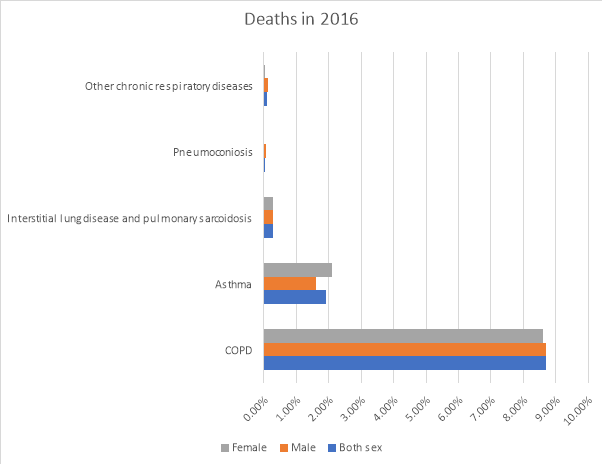
Our academic experts are ready and waiting to assist with any writing project you may have. From simple essay plans, through to full dissertations, you can guarantee we have a service perfectly matched to your needs.

- Rizwan S, Nongkynrih B, Gupta SK. “Air pollution in Delhi: Its Magnitude and Effects on Health”. Indian J Community Med. 2013;38: 4–8. doi:10.4103/0970-0218.106617
- Shah ASV, Langrish JP, Nair H, McAllister DA, Hunter AL, Donaldson K, et al. Global association of air pollution and heart failure: a systematic review and meta-analysis. Lancet. 2013;382: 1039–1048. doi:10.1016/S0140-6736(13)60898-3
- Diaz-Sanchez D. Pollution and the immune response: atopic diseases - are we too dirty or too clean? Immunology. 2000;101: 11–18. doi:10.1046/j.1365-2567.2000.00108.x
- Kjellstrom T, Lodh M, McMichael T, Ranmuthugala G, Shrestha R, Kingsland S. Air and water pollution: burden and strategies for control. In: Jamison DT, Breman JG, Measham AR, Alleyne G, Claeson M, Evans DB, et al., editors. Disease control priorities in developing countries. 2nd ed. Washington (DC): World Bank; 2006.
- Maji S, Ghosh S, Ahmed S. Association of air quality with respiratory and cardiovascular morbidity rate in Delhi, India. Int J Environ Health Res. 2018;28: 471–490. doi:10.1080/09603123.2018.1487045
- India State-Level Disease Burden Initiative CRD Collaborators. The burden of chronic respiratory diseases and their heterogeneity across the states of India: the Global Burden of Disease Study 1990-2016. Lancet Glob Health. 2018; doi:10.1016/S2214-109X(18)30409-1
- Jeran HOA, Khan AR. The Effect of Air Pollution on Ozone Layer Thickness in Troposphere over the State of Kuwait. Am J Environ Sci. 2009;5: 230–237. doi:10.3844/ajessp.2009.230.237
- Singh DP, Gadi R, Mandal TK, Dixit CK, Singh K, Saud T, et al. Study of temporal variation in ambient air quality during Diwali festival in India. Environ Monit Assess. 2010;169: 1–13. doi:10.1007/s10661-009-1145-9
- Mandal P, Prakash M, Bassin JK. Impact of Diwali celebrations on urban air and noise quality in Delhi City, India. Environ Monit Assess. 2012;184: 209–215. doi:10.1007/s10661-011-1960-7
- Delhi’s pollution nearly 30 times higher than WHO’s safety benchmark | Environment News [Internet]. [cited 10 Nov 2018]. Available: http://zeenews.india.com/news/eco-news/delhis-air-quality-hits-new-low-pollution-exceeds-permissible-limit_1819668.html
- National Air Quality Index [Internet]. [cited 10 Nov 2018]. Available: https://app.cpcbccr.com/AQI_India/
- Singh S, Sharma BB, Sharma SK, Sabir M, Singh V, ISAAC collaborating investigators. Prevalence and severity of asthma among Indian school children aged between 6 and 14 years: associations with parental smoking and traffic pollution. Journal of Asthma. 2016;53: 238–244. doi:10.3109/02770903.2015.1087558
- Global Burden of Disease Collaborative Network.Global Burden of Disease Study 2016 (GBD 2016) Results.Seattle, United States: Institute for Health Metrics and Evaluation (IHME), 2017.Available from http://ghdx.healthdata.org/gbd-results-tool .
- Air Pollution in Bangalore, India: A Six-Year Trend and Health Implication Analysis Conference Paper · November 2014
- Kumar, P., Gulia, S., Harrison, R. M. and Khare, M. (2017). The influence of odd-even car trial on fine and coarse particles in Delhi. Environmental Pollution 225 20–30.
Cite This Work
To export a reference to this article please select a referencing stye below:
Related Services

Essay Writing Service

- Dissertation Writing Service

- Assignment Writing Service

DMCA / Removal Request
If you are the original writer of this essay and no longer wish to have your work published on UKEssays.com then please:
Our academic writing and marking services can help you!
- Find out more about our Essay Writing Service
- Undergraduate 2:2
- 7 day delivery
- Marking Service
- Samples of our Service
- Full Service Portfolio

Humanity University
Dedicated to your worth and value as a human being!
Related Lectures
Study for free with our range of university lectures!
- All Available Lectures

Freelance Writing Jobs
Looking for a flexible role? Do you have a 2:1 degree or higher?
Study Resources
Free resources to assist you with your university studies!
- Dissertation Resources at UKDiss.com
- How to Write an Essay
- Essay Buyers Guide
- Referencing Tools
- Essay Writing Guides
- Masters Writing Guides
Change Region / Country
Here you can choose which regional hub you wish to view, providing you with the most relevant information we have for your specific region. If your specific country is not listed, please select the UK version of the site, as this is best suited to international visitors.
United Kingdom
United States
United Arab Emirates
Saudi Arabia
Haryana Air Quality Index (AQI)
Real-time PM2.5, PM10 air pollution in India
Last Updated: 27 Jul 2024, 02:05pm

Air Quality Map
Haryana, india, comparative exposure with haryana.
24 hrs avg AQI
Current Air Quality in Haryana
The current PM2.5 concentration in Haryana is 2.8 times above the recommended limit given by the WHO 24 hrs air quality guidelines value.
Haryana - Cities Air Pollution Level
| Status | AQI | AQI-US | AQI-IN | PM2.5 | PM10 | Temp | Humid | |
|---|---|---|---|---|---|---|---|---|
| MODERATE | 54 | 54 | 40 | 14 | 38 | 40 | 38 | |
| POOR | 128 | 128 | 86 | 48 | 70 | 38 | 41 | |
| POOR | 110 | 110 | 91 | 43 | 86 | 39 | 42 | |
| MODERATE | 84 | 84 | 50 | 28 | 28 | 38 | 42 | |
| POOR | 107 | 107 | 77 | 37 | 75 | 39 | 40 | |
| MODERATE | 89 | 89 | 48 | 30 | 35 | 39 | 40 | |
| MODERATE | 91 | 91 | 52 | 31 | 46 | 39 | 42 | |
| MODERATE | 77 | 77 | 41 | 24 | 38 | 39 | 40 | |
| POOR | 124 | 124 | 96 | 47 | 87 | 40 | 38 | |
| MODERATE | 90 | 90 | 56 | 30 | 56 | 38 | 42 |
Weather Conditions in Haryana
Health Advice For Haryana
Stay Indoor
Use Purifier
Haryana Air Quality Forecast
India - Metro Cities AQI
Historic air quality graph haryana.
Oct 1, 2020
Explore an insightful air pollution data for last 24 hrs, 7 days & 1 month
Pocket CO 2 Monitor
Check if there is fresh air.
Pocket PM2.5 Monitor
Check real-time air quality.
FAQs of Haryana's Air Quality Index
(frequently asked questions).
Quick answers to some commonly asked questions about the air pollution of Haryana.
The real-time air quality in Haryana is 80 (POOR) AQI now. This was last updated 35 minutes ago .
The current concentration of PM2.5 in Haryana is 42 (µg/m³). The World Health Organisation (WHO) recommends 15 µg/m³ as the threshold concentration of PM2.5 for 24 hrs mean. Currently, the concentration is 1.68 times the recommended limit.
Generally, the air quality at Haryana starts deteriorating in late October. The winters are the worst-hit season in terms of air pollution.
You should wear a good N95 mask when you go outdoor in Haryana until the AQI is improving upto moderate range.
Office going people should avoid personal vehicles and use public transportations or carpooling.
(i) The primary causes of outdoor air pollution are solid, liquid particles called aerosols & gase from vehicles emissions, construction activities, factories, burning stubble & fossil fuels and wildfire, etc.
(ii) Main causes of indoor air pollution are harmful gases from cooking fuels (such as wood, crop wastes, charcoal, coal and dung), damp, mould smoke, chemicals from cleaning materials, etc.
Indoor air pollution in Haryana is as dangerous as outdoor pollution, because the air pollutants come inside the houses or buildings through doors, windows and ventilation.
In Haryana, you must use an air purifier or fresh air machine at home or office indoor and close all the doors, windows and ventilations when the outdoor air quality index (aqi) in Haryana is very high. Proper ventilation is highly recommended only when outdoor air quality is improving and moderate AQI range.
World's Most Polluted Cities & Countries AQI Ranking
Real-time top most polluted cities, and monthly & annual historic aqi ranking of cities & countries, most polluted cities, live 100 ranking, world's most polluted, cities ranking, countries ranking, air quality solutions for haryana.
Find out Prana Air's air quality monitors & solutions to fight air pollution in your city.
Air Quality Monitor
Know what the quality your are breathing with Prana Air monitors (low-cost & accurate).
Air Quality Sensor
Analyze the quality of air anywhere with accurate & compact gas & pm sensors.
Air Purifier
Purify your indoor air & make it free from air pollution and toxins with our air purifier.
Car Cabin Filter
Make sure you breathe fresh inside your car with a highly efficient car cabin filter.
N95 Pollution Mask
Breathe pure air with Prana Air motorized masks of multi-layer hepa filter purification.
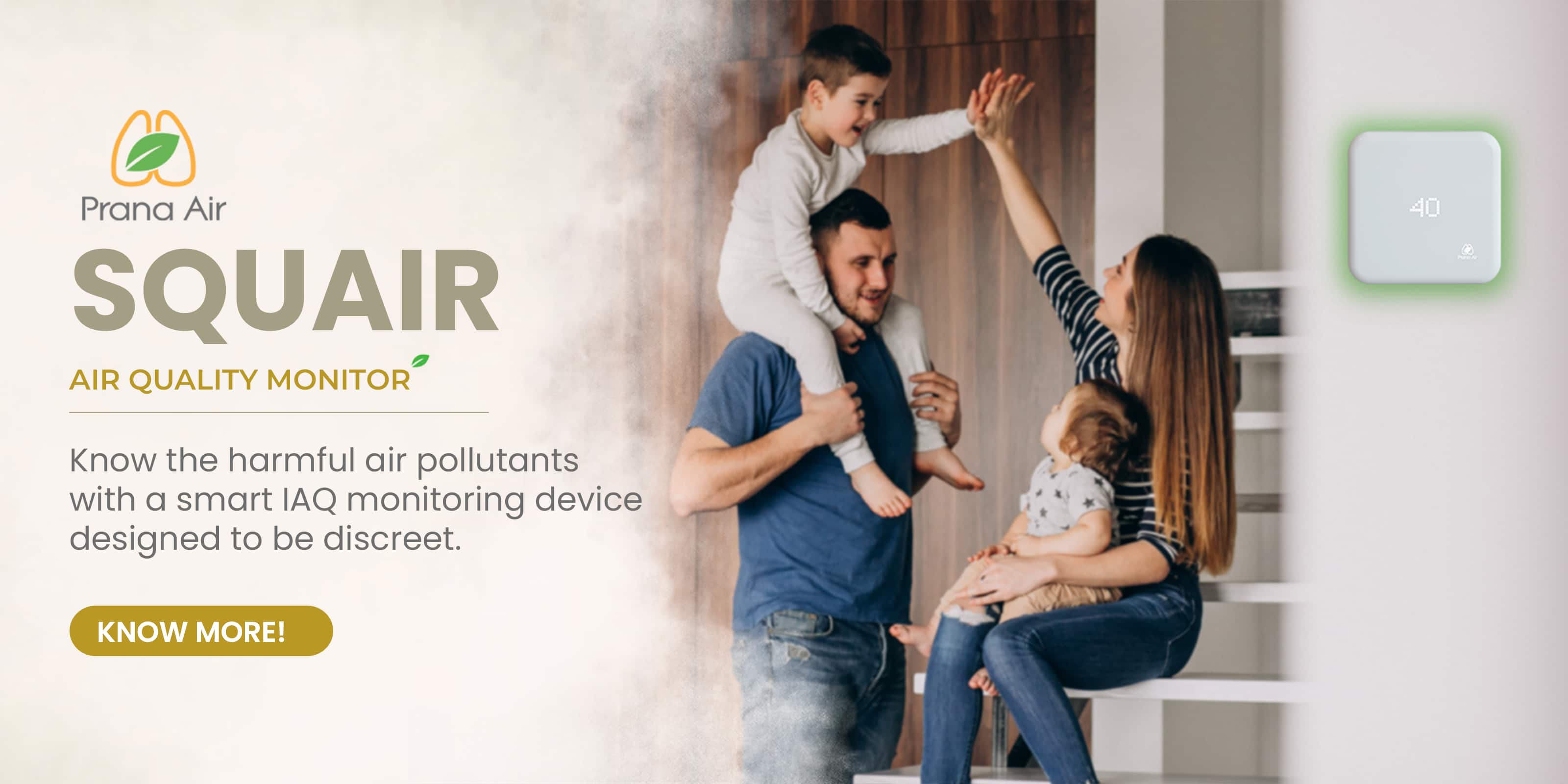
Keep a track of Haryana Air Pollution Level On “ AQI Air Quality App ”
Know what you breathe and the quality of air in your city and nearby locations. Real-time AQI, map, weather & fire data, health advice with insightful & analytical dashboards.
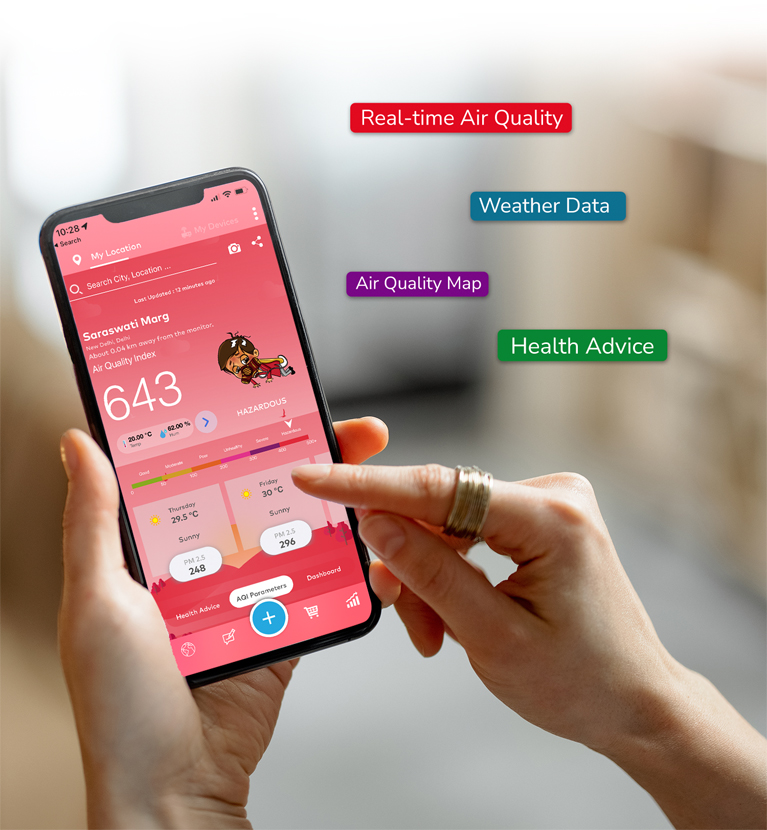
Thank you for visiting nature.com. You are using a browser version with limited support for CSS. To obtain the best experience, we recommend you use a more up to date browser (or turn off compatibility mode in Internet Explorer). In the meantime, to ensure continued support, we are displaying the site without styles and JavaScript.
- View all journals
- Explore content
- About the journal
- Publish with us
- Sign up for alerts
- Open access
- Published: 14 November 2022
Air quality impacts of crop residue burning in India and mitigation alternatives
- Ruoyu Lan 1 , 2 ,
- Sebastian D. Eastham ORCID: orcid.org/0000-0002-2476-4801 1 , 3 ,
- Tianjia Liu ORCID: orcid.org/0000-0003-3129-0154 4 ,
- Leslie K. Norford 2 &
- Steven R. H. Barrett ORCID: orcid.org/0000-0002-4642-9545 1 , 3
Nature Communications volume 13 , Article number: 6537 ( 2022 ) Cite this article
17k Accesses
35 Citations
86 Altmetric
Metrics details
- Agriculture
- Environmental impact
- Sustainability
Crop residue burning contributes to poor air quality and imposes a health burden on India. Despite government bans and other interventions, this practice remains widespread. Here we estimate the impact of changes in agricultural emissions on air quality across India and quantify the potential benefit of district-level actions using an adjoint modeling approach. From 2003 to 2019, we find that agricultural residue burning caused 44,000–98,000 particulate matter exposure-related premature deaths annually, of which Punjab, Haryana, and Uttar Pradesh contribute 67–90%. Due to a combination of relatively high downwind population density, agricultural output, and cultivation of residue-intensive crops, six districts in Punjab alone contribute to 40% of India-wide annual air quality impacts from residue burning. Burning two hours earlier in Punjab alone could avert premature deaths up to 9600 (95% CI: 8000–11,000) each year, valued at 3.2 (95% CI: 0.49–7.3) billion US dollars. Our findings support the use of targeted and potentially low-cost interventions to mitigate crop residue burning in India, pending further research regarding cost-effectiveness and feasibility.
Similar content being viewed by others
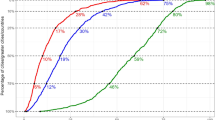
Reducing biomass burning is key to decrease PM2.5 exposure in European cities
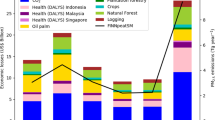
Assessing costs of Indonesian fires and the benefits of restoring peatland

Health and environmental consequences of crop residue burning correlated with increasing crop yields midst India’s Green Revolution
Introduction.
Long-term exposure to ambient fine particulate matter (PM 2.5 ) is associated with elevated health risks such as respiratory and cardiovascular diseases, resulting in more than four million premature deaths globally each year 1 , 2 , 3 . Of these, 10–25% are estimated to occur in India 3 , 4 , 5 , 6 . One source of direct PM 2.5 emissions responsible for Indian public health impacts is crop residue burning 2 , 3 , 4 . As the second largest worldwide crop producer (Food and Agricultural Organization of the United Nations), India generates ~500 million metric tonnes (MT) of crop residue annually, of which 100 MT is burned (Fig. 1a ). The practice of residue burning primarily occurs following the wheat harvest in April-May (pre-monsoon) and the rice harvest in October–November (post-monsoon), and mostly in northwestern India 7 , 8 . Densely populated areas located downwind of agricultural fires in the Indo-Gangetic Plain (IGP), such as New Delhi, typically experience an annual mean of ambient PM 2.5 concentration of 50–200 \({{{{{\rm{\mu }}}}}}\) g m −3 and episodic spikes reaching 200–1200 \({{{{{\rm{\mu }}}}}}\) g m −3 during burning seasons, exceeding the World Health Organization (WHO) PM 2.5 guidelines by an order of magnitude (5 \({{{{{\rm{\mu }}}}}}\) g m −3 annual mean; 15 \({{{{{\rm{\mu }}}}}}\) g m −3 24-hour mean) 9 (Supplementary Fig. 14 ). Ambient PM 2.5 exposure due to crop residue burning is specifically associated with a three-fold greater risk of acute respiratory infection in the general Indian population 10 . Recent studies at local, urban and regional scales have shown that PM 2.5 emitted from crop residue burning affects air quality not only in India but also across South Asia, including Pakistan, Nepal and Bangladesh, due to the transport by the predominantly northwesterly winds 7 , 9 , 11 .
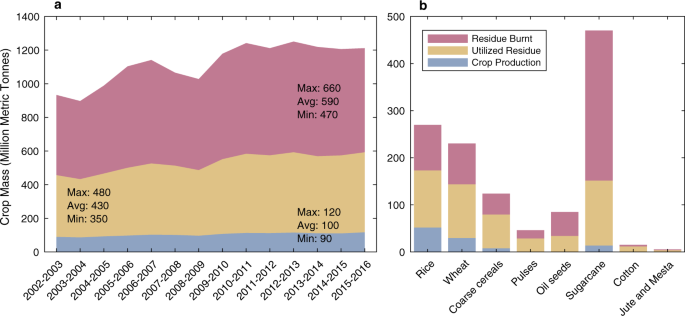
a Annual total crop production (blue), utilized residue (yellow), and residue burned (red) in million metric tonnes in India from 2003 to 2016; ( b ) Annual crop production (blue) including crop for food and fiber, utilized residue (yellow) and residue burned (red) by crop type in India, averaged from 2003 to 2016 in million metric tonnes.
Current regulations by the Indian government intended to reduce agricultural fires, including crop residue management, burning bans, and fines, have had limited efficacy 12 , 13 . Unlike other crop residue, the low protein content (e.g. N, P, K) and poor digestibility (e.g. high silicone and ash) of rice and wheat residue have limited their potential for use in biofuel, animal fodder, fertilizer and paper production (Fig. 1b , Supplementary Data 1 ). In addition, the tight schedule of the harvest-to-sowing transition under the predominant rice-wheat rotation cropping system in northwestern India have limited the rate of adoption of alternatives 12 , 13 . Crop residue burning allows cheap and fast disposal of crop residue and therefore remains a recurring issue, as revealed by a ~60% increase in the number of agricultural fires detected by NASA’s Aqua satellite from 2002 to 2016 9 , 14 .
Studies which can attribute air quality impacts to specific burning instances therefore help to inform targeted mitigation strategies and optimize resources for effective action on burning with minimal disruption to farmers 15 . Substantial work has been done on air pollution from fire emissions in individual, heavily polluted locations such as Delhi 7 , 9 , 11 , 14 , 16 . However, no work to date has related burning in each individual district to the eventual premature mortality risk and associated cost across India, where a large population experiences increased levels of pollution from fires. In addition, efforts to identify alternatives to burning have typically been qualitative or focused on national or regional measures such as adopting mechanized approaches and alternative crops 12 , 17 , 18 . This neglects the possibility that targeted changes in the timing and location of residue burning may be able to yield significant improvements, and that there might be large differences in the downwind health impacts resulting from the same amount of residue burning from specific locations. Such information is needed to support decision-making which can place public benefits such as health costs alongside the potential private costs to farmers 13 .
Here we aim to inform efforts to mitigate the adverse impacts of crop residue burning by quantifying how small-scale and targeted changes could affect the air pollution and health risks of the entire Indian population. We use the Global Fire Emissions Database v4.1s (GFEDv4.1s) to provide an estimate of emissions from open burning of crop residue, combined with district-level crop production data for India, to obtain a comprehensive map of the time and location of crop production and residue burning. We then use a regional atmospheric chemistry and transport model (GEOS-Chem adjoint) to perform inverse (receptor-oriented) simulations, computing the sensitivity of a given population’s exposure to PM 2.5 with respect to emissions in any location at any time, and date. In combination with an Integrated Exposure Response (IER) function 3 and an India-specific Value of Statistical Life (VSL) 19 , we use this data to estimate which burning events, in what locations, and at what times are responsible for the greatest increases in population exposure, premature mortality, and monetary societal cost during the period 2003–2019.
Results and discussion
We use an adjoint modeling approach (GEOS-Chem adjoint) as our primary tool for air quality impact attribution. We first perform three sets of adjoint runs from which we obtain sensitivities that quantify the effect of emissions on population exposure for the whole Indian population (cost function \(J\) ). Each set of runs represents one typical rainfall condition for a year (i.e. “flood” (2007), “drought” (2009), or “normal” (2012) year), but all three use the same population distribution. We combine this sensitivity data with fire emissions for each year from 2003 to 2019 to estimate the impact of agricultural residue burning on India-wide population exposure. Modifying the emissions dataset allows us to quantify the benefit of different targeted mitigation strategies, while using each of the three sensitivity datasets allows us to quantify the role of meteorological variability. For each year from 2003 to 2019, one of the three sensitivity datasets is chosen based on monsoon rainfall record in India (see Methods).
Two additional sets of adjoint simulations are performed for the “normal” meteorological year, in which the cost function \(J\) is modified to include only either urban or highly populated areas. Comparison of results using these datasets to those using the full India-wide population allows us to evaluate the distribution of impacts between urban and rural areas.
For additional context, we perform 23 pairs of forward simulations with the conventional GEOS-Chem Classic model. Each pair simulates the post-monsoon burning season with and without India agricultural emissions, and the 23 pairs collectively cover the period from 1997 to 2019. This allows us to evaluate the impacts of Indian residue burning on surrounding countries, and to gain a more complete understanding of the interaction between population growth, meteorological variability, and historical changes in fire emissions. See Methods for a detailed description.
Air quality impacts resulting from agricultural burning
We define air quality impacts due to crop residue burning in terms of the premature deaths attributable to PM 2.5 exposure and the associated monetized cost. Figure 2 shows how crop residue burning on each day contributed to the national mean PM 2.5 exposure. From 2003 to 2019 we estimate that the annual mean population-weighted PM 2.5 exposure due to burning activities in India averaged 6.7 \({{{{{\rm{\mu }}}}}}\) g m −3 . Pre-monsoon and post-monsoon residue burning contribute 28% and 64% of this total, respectively. Geographically, more than 90% of the India-wide fire-related exposure increase is due to agricultural fire emissions from the northwest states, with 64% from Punjab, 11% from Haryana, and 5.7% from Uttar Pradesh. It is consistent throughout 17 years that the pre-monsoon and post-monsoon fire seasons are responsible for 90% of PM 2.5 exposure from residue burning, and that Punjab, Haryana, and Uttar Pradesh together contribute over two thirds of the nation-wide exposure burden (see Supplementary Data 2 and 3 for a breakdown by state and season). Demographically, urban and densely populated areas, defined by regions with a population density above 400 and 1,000 people per km 2 , respectively, are exposed to 2.0 \({{{{{\rm{\mu }}}}}}\) g m −3 (31%) and 4.8 \({{{{{\rm{\mu }}}}}}\) g m −3 (73%) greater annual PM 2.5 concentrations than the national average due to residue burning (Supplementary Figs. 1, 31). This is supported by observations of elevated PM 2.5 levels during burning seasons in large cities downwind of agricultural fires 12 , 14 , 16 , 17 , 20 , 21 , 22 .

Contributions are broken out for Uttar Pradesh (yellow bars), Haryana (red bars), Punjab (blue bars) and the rest of India (grey bars) by date, averaged over 2003–2019. The shaded area (light rose) in April-May and October–November denotes the dominant contribution from pre-monsoon fire season (wheat residue burning) and post-monsoon fire season (rice residue burning), respectively.
By applying the IER and India-specific population distribution, we estimate 69,000 (95% CI: 57,000–80,000) total premature mortalities on average across India resulting from ambient PM 2.5 exposure due to crop residue burning (Supplementary Data 4 ). Our estimate for 2015 (60,000, 95% CI: 50,000–70,000) is consistent with Global Burden of Disease (GBD) 2018 India Special Report’s estimate of premature mortality (66,000, 95 CI%: 57,000–79,000) attributable to agricultural fires in India for the same year 23 . Our estimate for the same period is 4.7–14% of premature mortality attributable to total ambient PM 2.5 presented by earlier studies covering 2010-2019 4 , 5 , 6 , 15 , 23 , 24 , 25 , 26 , 27 , 28 . This fraction is consistent with findings from GBD 2018, where 6.1% of premature deaths in India due to ambient PM 2.5 are attributed to agricultural fires 23 . The central estimates of early deaths as well as confidence intervals (CI) depend on the choice of relative risk function 29 . While the IER the has been applied worldwide, including India, to quantify attributable deaths due to biomass burning episodes 3 , 23 , 24 , 25 , 26 , 27 , 28 , 29 , 30 , 31 , we compare the IER-based results to those using other methods in the Methods and Supplemental Information.
Using a VSL adjusted for India, we estimate the annual, monetized cost of premature mortality due to crop residue burning as 23 (95% CI: 3.5–53) billion USD. This is equivalent to 38% of the total health expenditure, or 7.8% of the gross value added from agricultural activity on average (Supplementary Data 4 ). These two ratios have increased from 29% to 40%, and from 6.1% to 9.2%, respectively between 2003 and 2019 (Supplementary Data 4 ). We find that for any year in this period, the three largest contributors to these impacts are consistently Punjab (48–75%), Haryana (7.8–14%), and Uttar Pradesh (3.7–9.5%) (Supplementary Data 2 - 4 ).
Contributions by district
Figure 3 shows the premature deaths per unit of emissions from burning (vertical axis) against the emissions per unit of crop production (horizontal axis) for each district in Punjab and Haryana. The contribution to premature mortalities per crop produced for these two states is larger than for the rest of India combined (Supplementary Figs. 2, 3). Variations between these districts are due not only to different crop production quantities but also different meteorology, population distributions, and agricultural practices. For the 43 districts in the two states, we use the two dimensions (emissions per unit production and mortalities per unit emission) shown in Fig. 3 to define four categories (C1–C4). Punjab and Haryana, under the rice-wheat rotation system, are collectively responsible for 60% of all rice and 30% of all wheat entering the central grain pool in India 12 . This results in a large amount of residue being burned per unit of crop production, as these two crops produce relatively high quantities of residue per unit of product compared to crops such as oilseed and sugarcane (Fig. 1b ).
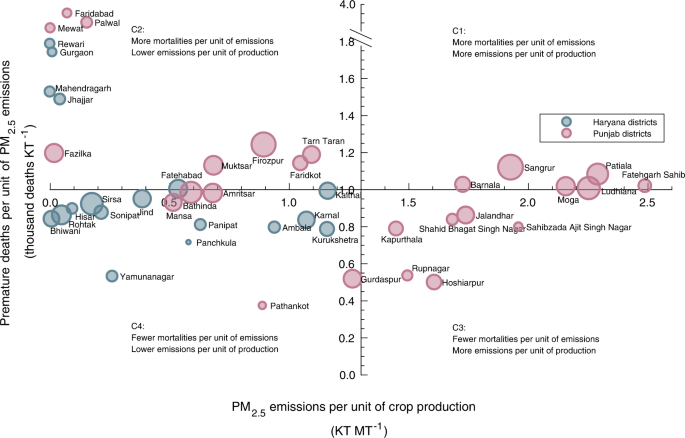
Districts are categorized by agricultural PM 2.5 emissions per unit of crop production (kilo tonnes per million metric ton, or KT MT −1 ) on the x-axis, and premature deaths per unit of agricultural PM 2.5 emissions (thousands KT −1 ) in y-axis, averaged over 2003–2019. The size (radius) of the dots indicates the gross crop production in MT of each district. The contribution to India-wide premature deaths from residue burning in each district is the product of emissions per unit of crop production ( x axis value), mortalities per unit of emissions (y-axis value) and crop production (size of the dot) (Supplementary Figs. 2, 3).
The contribution of crop residue burning in each district to total premature mortality in India is a product of three factors: first, premature deaths per unit of agricultural burning emissions (meteorology and population); second, agricultural burning emissions per unit of crop production (choice of crops/varieties); and third, the total crop production (Fig. 3 ). Districts in C1 rank high in the first two factors, partly because they grow coarse varieties of rice that generate more residue to be burned for the same amount of crop production 32 and are mostly upwind of densely populated regions. As a result, they are on average responsible for 40% (27,000 deaths, valued at 9.0 billion USD) of the total air quality impacts in India due to burning, with Patiala and Sangrur alone contributing 20%. Compared to C1, districts in C2 and C3 have lower emissions per unit of crop production (<1.3 KT MT −1 ) and fewer premature deaths per unit of emissions (<1000 premature deaths KT −1 ), respectively. The contribution to the total air quality impact of residue burning is therefore 11% and 14% for districts in C2 and C3, respectively. The remaining districts (C4) are minor contributors to the total impacts, among which Kaithal has the largest contribution (2.4%) due to its cultivation of coarse rice (lower emissions per unit of production), lower sensitivity (fewer premature deaths per unit of emissions) and lower overall crop production (Supplementary Fig. 3 ). All Haryana districts fall in C2 and C4, whereas districts in C1 and C3 are all from Punjab, distinguished by the first factor (x-axis). Although both states are large rice producers, Haryana mainly grows basmati rice, the residue of which is used as animal feed. Punjab instead mainly grows non-basmati rice, the residue of which is not fed to livestock because of its high silica content and which is thus more often burned in-field 18 , 32 .
Sensitivity of air quality impacts to spatial and temporal changes in emissions
Figure 4 shows the percentage change in annual air quality impacts due to burning achieved by a 1% reduction in emissions from burning (hereafter the efficacy of reducing burning) in each state or district during two burning seasons averaged over 2003–2019. Specifically, during post-monsoon season, the efficacy of reducing burning is greatest in Punjab and Haryana, with a 0.57% and 0.065% reduction respectively in total India-wide impacts from crop residue burning per 1% reduction in burning emissions. This means 380 (95% CI: 320–450) and 45 (95% CI: 37–52) averted premature deaths, valued at 130 (95% CI: 20−300) and 15 (95% CI: 2.3−34) million USD, respectively, averaged across 17 years. Considering only burning emissions from Punjab, two thirds of the achievable benefit comes from reductions in burning in Sangrur, Patiala, and Ludhiana, where a 1% reduction in emissions from post-monsoon residue burning would result in a 0.18%, 0.05%, and 0.068% reduction, respectively, in India-wide burning-related air quality impacts.
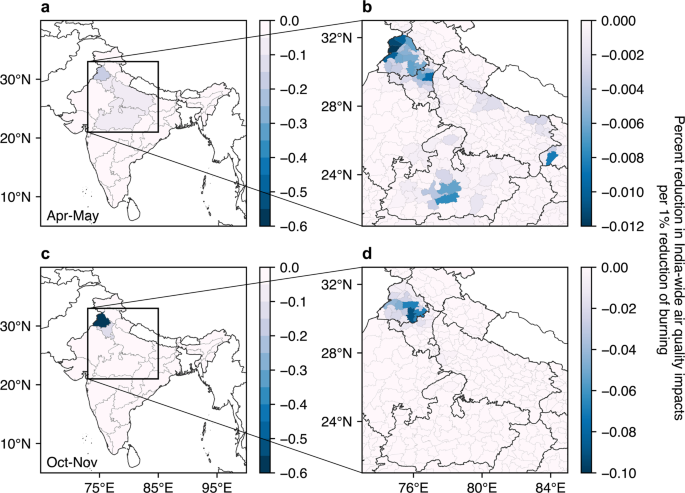
a Percent reduction in contribution to air quality impacts per 1% reduction in agricultural burning emissions in wheat residue burning season (April-May) in different states. b Zoom-in of a, i.e. districts in northwestern India. c , d are same as a and b but for rice residue burning season (October–November), hence the greater color bar limits as shown in d compared to b. India administrative maps are obtained from the Database of Global Administrative Areas, Version 4.1 50 . Coast outlines are plotted based on data in Python Matplotlib Basemap Toolkit, Version 1.2.1.
One reason that farmers choose to burn agricultural residue rather than adopting (e.g.) mechanized alternatives is that there is a limited window of time, around two to three weeks, to manage crop residue between harvesting and sowing 9 , 13 , 16 . A water table preservation policy instituted in Punjab and Haryana in 2009 to align rice irrigation with the summer monsoon further shortened this window, which may have further intensified burning activities as farmers seek to ensure timely sowing for the next planting season 17 , 22 . This suggests that promoting burning earlier or later in the season may be unattractive or unachievable 10 , 13 , 17 .
It may instead be possible to burn earlier or later within a given day without incurring the same difficulties for farmers, but no study to date has quantified the potential benefits of such a change. We therefore quantify the air quality impacts of shifting burning within the day by applying different local time (LT) diurnal cycles of emissions (Supplementary Fig. 4 ). Figure 5 shows the changes in attributable air quality impacts resulting from shifts ranging from six hours earlier to one hour later.

Solid bars show the percentage change in contribution to annual residue burning-related air quality impacts in India achieved by shifting the burning peak from one hour earlier to six hours earlier, as well as one hour later, in different months, averaged over 2003–2019. The error bars depict the maximum and minimum percentage change for any single year in the period 2003–2019. The original peak of burning is set at 14:30 local time (LT) for both wheat and rice residue burning seasons. Diurnal cycles of emissions are based on MODIS satellite fire counts in the morning and afternoon (Supplementary Fig. 4 ).
Averaged over the period 2003–2019, burning earlier by one to four hours could reduce the total air quality impacts of crop residue burning by 0.5–19%, while burning too early or burning later could instead increase the impacts by 2−30%. For any individual year in that period, burning two to three hours earlier in November reduces the total, annual, residue burning-related contribution to India-wide air quality impacts by 15–23% (Fig. 5 ). If the target region is restricted to Punjab only, burning earlier by two hours in November yields an average (over 17 years) 14% reduction in air quality impacts resulting from that region’s residue burning (Supplementary Fig. 5 ). This means 9600 (95% CI: 8000–11,000) averted early deaths annually, valued at 3.2 (95% CI: 0.49–7.3) billion USD. This is greater than the sum from all other states if the same timing shift were applied. Although these improvements could be subject to the specific diurnal cycles we use, our assumptions of diurnal fire activity agree with previous findings that fires are typically set during early to mid-day (07:00–11:00 LT) and burn out by the evening (17:00–20:00 LT), lasting 13–15 hours 20 , 21 , 22 , 33 , and that fire activity generally peaks in the afternoon 22 , 32 . Liu et al. 2020 collected survey data from households in India, finding that despite regional variations, 97% of burning activities happen between 10:00 and 23:00 LT, nearly 30% of which happen in late evening (18:00–23:00 LT) 22 . While we do not have district-level information about hourly diurnal cycles of fire activities due to a lack of comprehensive in-field studies, our broad conclusion is that there may be significant benefits yielded by encouraging fires to be set earlier (10:00–13:00 LT) in the day rather than later (14:00–17:00 LT).
One contributing factor to these changes could be natural, diurnal changes in the depth of the planetary boundary layer (PBL). The PBL height (PBLH) typically peaks at 13:00–14:00 LT and decreases rapidly afterwards (Supplementary Fig. 6 ). It is a key meteorological parameter in pollutant dispersion 34 , 35 , 36 because a higher PBLH favors dispersion and reduces aerosol accumulation 34 , 36 (see Supplementary Information for a detailed discussion). However, the PBLH is also directly affected by aerosol loading meaning that the concentration of pollution can itself affect dispersion 35 . The PBLH decreases with increasing aerosol concentration, which enhances atmospheric stability and in turn favors even higher pollutant concentrations––a positive feedback loop 35 . However, the diurnal variations of PBLH do not change significantly on heavily polluted days compared to clean days 34 , 37 . Supplementary Fig. 6 also shows similar diurnal cycles of PBLH in polluted and less polluted areas. Therefore, despite local aerosol-PBL interactions, a shifted burning cycle on an hourly basis is not likely to significantly affect the broad patterns of PBLH and the timing effects of emissions. However, further investigation will be needed to evaluate how a shift in the diurnal pattern of burning (i.e. aerosol emissions) might in turn modify the diurnal pattern of PBLH––and therefore pollution dispersion––compared to the effects observed to date for existing emission patterns.
Other meteorological parameters including relative humidity (RH), temperature, and wind speed also vary diurnally and may affect the benefits of burning earlier 34 , 38 . Studies in India found higher pollutant concentrations with higher RH due to incomplete combustion, causing more secondary aerosol formation 38 . Supplementary Fig. 6 shows that, on average, RH is roughly constant from 11:30 to 15:30 local time. Our proposed shift moves the peak burning time from 14:30 to 13:30, suggesting that the RH effect is not significant. In addition, lower temperature and lower wind speed could trap more aerosols within the PBL 34 , 38 . This is consistent with our finding of decreased air quality benefits when the burning peak is too early or late (Fig. 5 ). Changes in wind speed due to high aerosol loading should also be considered in future online studies of specific interventions.
These findings suggest that aerosol-meteorology interactions are unlikely to eliminate the benefit of a shift in the diurnal pattern of burning. We recognize however that further studies involving sensitivity experiments will be needed to evaluate the degree to which these feedbacks suppress or enhance the benefit. In general, for any intervention our approach is a first-order tool, and more modeling, experiments and observations would be warranted before advancing any policy recommendation. However, our broad explanation is that the aerosols emitted when meteorology favors dispersion are more diluted and less harmful as they travel downwind (Supplementary Figs. 6, 30).
This work focuses on how India-wide air quality impacts are affected by any conceivable change in fire emissions using an “adjoint” modeling approach. Rather than tracking the transport of pollution and the distribution of air quality impacts for a single scenario, the adjoint model tracks the sensitivity of exposure over a disperse population with respect to changes in emissions sources. This is essential for efficiently evaluating different cost-effective pollution-abatement policies. We therefore do not calculate the local effects of shifting the timing of burning, e.g. the evolution of air pollution to downwind areas such as New Delhi.
Inter-annual variations in the air quality impacts of residue burning
To provide context to the sensitivity-based results above, we use forward modeling to simulate the post-monsoon residue burning season over a 23-year period (Supplementary Figs. 8, 9). We first quantify population exposure to BC and OC (carbonaceous PM 2.5 ) from all sources. For these simulations we include changes in residue burning emissions, population (total), and meteorology (see Methods). We find that, while the daily-mean population exposure varies, the geographical distribution of exposure and meteorological context (wind fields) remain similar. From 1997 to 2019, the national average population-weighted PM 2.5 exposure has increased from 54 \({{{{{\rm{\mu }}}}}}\) g m −3 to 75 \({{{{{\rm{\mu }}}}}}\) g m −3 , possibly due to increasing crop production (Supplementary Figs. 7, 8). Northwest India (Punjab, Haryana, Uttar Pradesh, Delhi) is the most polluted region during post-monsoon burning season, and the daily-mean population-weighted PM 2.5 exposure in these areas is consistently higher than the national average. For every year from 1997 to 2019, we estimate that Delhi’s air consistently had levels of (carbonaceous) PM 2.5 exceeding 120 \({{{{{\rm{\mu }}}}}}\) g m −3 when averaged over the two-month post-monsoon burning period.
We also perform 23 counterfactual simulations, covering the same period, in which emissions from residue burning in India are not included. While our sensitivity simulations show that our broad conclusions (e.g. contribution by state, season) are consistent throughout 17 years of differing fire emissions and three different meteorological conditions (Supplementary Data), our extended set of forward simulations show that the average air quality impacts attributable to agricultural fires is 2.4% lower in drought years (e.g. 2009, 2015) and 4.8% higher in flood years (e.g. 2007, 2019). For years with normal rainfall (e.g. 2012, 2018), close (−0.8%) to the 17-year average, we estimate the annual fire-related premature deaths at 68,000 (95% CI: 57,000–79,000), valued at 22 (95% CI: 3.2–50) billion USD. Specifically, crop residue burning in 2016 contributes to the largest enhancement of nationwide PM 2.5 exposure (9.6 \({{{{{\rm{\mu }}}}}}\) g m −3 ), resulting in the most premature deaths 98,000 (95% CI: 82,000-110,000). This is consistent with the large number of agricultural fires observed by the Moderate Resolution Imaging Spectroradiometer (MODIS) instrument in that year, and the unprecedented enhancement in PM 2.5 levels observed in Delhi (648 \({{{{{\rm{\mu }}}}}}\) g m -3 ) 16 , 38 .
These results only include the post-monsoon burning season, and rely on monthly emissions data. Using our sensitivity data with daily emissions data and assigning each year from 2003 to 2019 an appropriate meteorological condition (flood year, drought year, normal year), we can quantify the impacts of each full year’s residue burning. From 2003 to 2019, along with an increase of food grain production from 210 MT to 300 MT (Supplementary Fig. 7 ), the monetized cost associated with burning increases from 7.2 (95% CI:1.1–17) to 44 (95% CI:6.7–100) billion USD (Supplementary Data 4 ).
A point of interest is the impacts in 2018 and 2019. In 2018, a subsidy was introduced to encourage mechanization as an alternative to burning 13 . Despite this policy change, we find air quality impacts attributable to crop residue burning to be similar between 2018 and 2019 at 86,000 premature deaths each year. To understand this, we re-derived impacts for 2015-2019 using fixed meteorological data. Under these conditions, mortalities in 2018 and 2019 are 4.2% and 11% lower than the previous three-year average, but 15% and 6.9% greater than for 2017, respectively (Supplementary Data 9 ). For just Punjab, Haryana, and Uttar Pradesh, the average exposure resulting from burning (assuming fixed meteorology) in 2018 and 2019 was 16% lower than the 2015–2017 average, but still 18% greater than the 2017 value alone (Supplementary Data 9 ).
This does not necessarily imply that the initiative was unsuccessful. Prior work has suggested that overall post-monsoon residue burning was decreased, showing a 18% reduction in fire counts observed by the MODIS satellite in northwest India in 2019 compared to the previous year (Supplementary Data 10 ). The GFEDv4.1s dataset suggests that the total dry matter burned in Punjab, Haryana, and Uttar Pradesh in 2018 and 2019 was only 9 and 3% less than the 2015–2017 average (Supplementary Data 11 ), respectively––but this masks two compensating changes. Focusing on the post-monsoon period only, the total dry matter burned in the three states in 2018 and 2019 was 36% below the 2015–2017 average, and only 1% greater than the 2017 value. Dry matter burned during the pre-monsoon period, however, was 52% and 130% greater in 2018 and 2019 respectively than the 2015–2017 average (Supplementary Data 11 ). With fixed meteorology, pre-monsoon residue burning contributed 38% of the total premature mortality resulting from fire emissions in these three states in 2019, compared to 9% in 2015 (Supplementary Data 9 ).
Although more data are needed to determine the significance of this trend, our results suggest that health benefits due to a reduction in emissions during the post-monsoon period in 2017-2019 have been offset by an increase in emissions during the pre-monsoon period and that the effectiveness of interventions should be considered across both seasons.
Impacts of Indian agricultural residue burning on neighboring countries
The IGP is home to millions of people residing in not only northern India but also Nepal, Bangladesh and Pakistan. Agricultural fires in India are not subject to political borders and may have air quality impacts on neighboring countries as well. Using data from 23 years of forward simulations we find that PM 2.5 exposure in Bangladesh, Nepal and Pakistan resulting from Indian crop residue burning is 0.24–12% of that in India (Supplementary Figs. 9, 10). Of these countries, impacts are lower in Bangladesh and Nepal (1.3–2.2%), whereas Pakistan’s PM 2.5 enhancement averages 6.9% of that in India. We show that over 23 years, annual mean total increase in population exposure due to Indian crop residue burning is 4.5 \(\times {10}^{9}\) people \(\bullet {{{{{\rm{\mu }}}}}}\) g m −3 in India, 2.6 \(\times {10}^{8}\) people \(\bullet {{{{{\rm{\mu }}}}}}\) g m −3 in Pakistan, 7.8 \(\times {10}^{7}\) people \(\bullet {{{{{\rm{\mu }}}}}}\) g m −3 in Bangladesh and 4.2 \(\times {10}^{7}\) people \(\bullet {{{{{\rm{\mu }}}}}}\) g m −3 in Nepal. Therefore, the majority (88–95%) of burning-related population exposure is experienced by the Indian population. This is partly due to large-scale meteorological winds that carry pollution into, rather than away from, India (as shown in Supplementary Figs. 8, 9) as well as the high population density in this region.
Implications of targeted interventions
In India, the total amount of crop residue (dry matter) generation has increased from 80 MT in 1950–1951 to 520 MT in 2017-2018 (Economic Survey of India, 2020). In recent years, crop residue burning has contributed to levels of PM 2.5 concentrations that are 15–45 times higher than the WHO safety guidelines in northern India 9 , 16 , 21 . Our results suggest that this burning has a monetized annual cost of 23 billion USD averaged from 2003 to 2019, which has grown by a factor of six over the same period. Existing governmental efforts, including the National Policy for Management of Crop Residues, the National Green Tribunal Act, and the Straw Management System, are in place to reduce the practice of burning 12 . However, in-field burning remains prevalent, especially in the states of Punjab and Haryana 12 , 13 , 14 , 17 . The results of our work have several implications on mitigation strategies.
First, we find that under similar meteorology and rice-wheat cropping system, the attributable air quality impacts from Punjab are six times as much as those from Haryana, partly because Haryana districts mainly grow basmati rice, which is more utilizable than non-basmati rice cultivated in Punjab (Fig. 3 ) 18 . Therefore, in addition to diversifying rice with crops that produce less residue such as pulses and oilseeds (Fig. 1b ), adopting rice varieties that are less burning-intensive could also reduce the amount of burned residue and eventual attributable fire-related impacts. Second, current regulations, including bans and fines, are mainly implemented at national or state levels, which may overlook the possibilities that local-scale actions can bring significant benefit. Our study shows that a small number of administrative areas may be prioritized for interventions to effectively reduce the attributable impacts from fires (Fig. 4 ), with burning in six districts in Punjab responsible for 40% of India-wide exposure to fire related PM 2.5 . Such information is helpful for spatially targeted decision-making. Third, we also find that burning earlier by a few hours within a day could avert up to 14% of the air quality impacts resulting from residue burning, over 90% of which is borne by Indians. Such temporally targeted interventions may therefore allow effective and potentially low-cost reductions in harm while local effects on pollution distribution can be further investigated. In addition, a combination of targeted decision-making and more permanent solutions, such as mechanization, may help to optimize resources and minimize disruption to farmers.
While this study implies that significant societal benefits can potentially be achieved by small-scale actions, a comprehensive cost-benefit analysis and consideration of extra incentives for farmers is needed for actionable planning and wide adoption of alternatives. Our hope is that work such as ours can provide quantitative data for near-term measures to effectively reduce the harms of agricultural residue burning while more holistic solutions can be pursued.
Comparison with other approaches and studies
In the case of crop residue burning, most existing work focuses on air pollution at local and urban scales, highlighting the influence of agricultural fires on regional air quality 7 , 9 , 10 , 11 , 14 , 16 , 20 , 21 . However, impacts of fire emissions are likely to extend over a much larger area due to dispersion and transport 1 , 4 , 11 , 16 . Epidemiological studies show that any additional exposure to PM 2.5 causes an increased mortality risk even when baseline exposure is very low 3 , 39 . This means that small exposure increases over large regions should be considered equally with focused increases over smaller regions 39 . Our study equitably evaluates the impacts on everyone who is subject to fire-related air pollution in India, not just those in a typical pollution hot-spot.
In addition, while severe air pollution has been observed in cities such as Delhi 7 , 9 , 16 , 22 , we acknowledge that crop residue burning is one of several factors in urban air pollution, rather than necessarily the dominant factor. For example, although agricultural emissions can contribute up to 50% of PM 2.5 in Delhi during post-monsoon fire season, the dominant (70%) emission sources of year-round PM 2.5 are vehicle, industrial and energy emissions 5 , 23 . For population in suburbs or rural areas, crop residue burning is a greater year-round contributor in absolute or relative terms. By using an adjoint modeling approach, our study relates the eventual impacts across the country back to burning in each hour and individual district, and shows that crop residue burning can be controlled independently to achieve the greatest reduction of aggregate exposure at the lowest cost.
The main contribution of this work is the quantification and disaggregation of air quality impacts across India due to agricultural emissions, and the identification of a potential new form of impact mitigation. However, our baseline estimates of attributable premature deaths in India also compare well with existing health impact assessment studies. GBD MAPS Working Group attributed 66,200 (6.1%) ambient PM 2.5 -related premature deaths to open burning of agricultural residue in 2015 23 , which is similar to our calculations for 2015 (60,000, 95% CI: 50,000–70,000). The total premature deaths attributable to ambient PM 2.5 exposure in India range from 570,000 to 1,450,000 in previous studies covering years from 2010 and 2019 1 , 2 , 4 , 5 , 6 , 15 , 23 , 24 , 25 , 26 , 27 , 28 , with which our estimate is consistent (assuming a ~6% contribution from agriculture fires).
Sources of uncertainty
Although we include an uncertainty analysis in the Supplementary Discussion (e.g. inventory uncertainty), our study is subject to several other sources of uncertainty that we do not quantify. First, we focus on premature mortality risk changes resulting from changes in exposure to primary PM 2.5 released from residue burning and do not quantify exposure to other species such as ozone 29 . Second, the IER function used in this study assumes equal toxicity for all PM 2.5 species and ignores differences in composition, which still requires further investigation 3 . We also recognize that the IERs, as with other commonly used concentration response functions, were not developed specifically for India. However, without comprehensive epidemiological studies and available established models for India, the IER function is still a practical solution to represent our best at-present understanding of relative risks attributable to PM 2.5 exposure (see Methods). As Indian epidemiological evidence grows and concentration response function models are being developed and improved, future work may benefit from the adoption of a new method. Third, we assume a single diurnal cycle for burning emissions based on satellite information due to limited data of hourly burning activities from local sources (Supplementary Discussion, Supplementary Figs. 4, 28, 29). Lastly, since this study focuses on the broader air quality impacts over a large dispersion population, we do not specifically look at individual pollution hot-spots such as Delhi. We do however provide additional assessments for densely populated (urban) areas, where Delhi is a main recipient of pollution from agricultural fires (Supplementary Fig. 1 ).
Future research
Our approach allows any proposed emissions change to be related to the eventual air quality impacts for the Indian population and sets the stage for future research into crop residue burning. Since we have focused most of our analysis on a single intervention, it would be a natural next step to examine the effects of such interventions in downwind locations (e.g. the spread of pollutants in New Delhi) using conventional forward modeling techniques. Online modeling considering aerosol-meteorology interactions (e.g. aerosol effects on PBL variations) is also needed to better understand whether these feedbacks would suppress or enhance reductions in exposure. Furthermore, since our assumed diurnal pattern of burning may not reflect true fire activities, focused observational work on burning practices is needed to verify that these benefits are realizable. In addition, a deep assessment (e.g. cost-benefit analysis) of any single alternative is needed to determine how plausible such an intervention would be in practice.
Our study estimates the total annual premature deaths and the value of mortality risk reduction attributable to PM 2.5 exposure from crop residue burning in India over 2003–2019. We also estimate the efficacy of marginal changes to reduce these impacts at the district level, finding that a small number of administrative regions could be prioritized to provide the maximum air quality improvement. We find that six districts in Punjab are responsible for 40% of the nationwide air quality impacts as a result of meteorological factors, the size of the downwind population, and the use of residue-intensive crops. Our work provides additional insights into potentially low-cost interventions that may significantly reduce the air quality impacts, such as shifting to burning in the morning rather than afternoon and promoting less residue-intensive crops (e.g. basmati rice instead of non-basmati rice). These findings provide a quantitative basis for the design and optimization of mitigation strategies for crop residue burning on a broad scale, as well as providing new opportunities for future regional and local studies on agricultural fires in India.
Agricultural residue burning emissions
Consistent with GBD 2018 India Special Report, we calculate emissions from agricultural residue burning using the Global Fire Emissions Database v4.1s (GFEDv4.1s) from 2003 to 2019 (daily emissions for adjoint simulations) and from 1997 to 2019 (monthly emissions for forward simulations) 24 , 39 . GFEDv4.1s is a hybrid emissions inventory that incorporates satellite and ground-based measurements to estimate fire emissions of various types (including open burning of agricultural residue). In particular, it includes a small fire boost based on active fire detections outside the burned area extent, which improves estimation of emissions from frequent and/or short-lived burning events (e.g. agricultural fires) 40 , 41 . A comparison using alternative fire emissions inventories is provided in the Supplemental Information. Similar to Koplitz et al. 2016, we define burning-attributable PM 2.5 as the sum of black carbon (BC) and organic carbon (OC), the primary components of fire smoke-related PM 2.5 31 .
The diurnal pattern of fire activity in the standard GFEDv4.1s product is estimated using an emissions redistribution approach. The diurnal cycles of burning are estimated based on observational data from geostationary satellites over the Americas, which are then applied to other parts of the world by matching three broad fuel types (crop/grass, shrub/savanna, and forest) 40 , 42 . While appropriate for many applications over North and South America, this method is not likely to accurately reflect agricultural residue burning in India because the crops grown, crop cycles, field size, and crop practices are different 40 . We therefore apply an alternative diurnal cycle for agricultural residue burning in India based on satellite information from prior literature. The fire activity in sub-tropical areas is typically more intense in the early- to late-afternoon 33 , 42 . Over India, the fire counts from MODIS Aqua (13:30 LT) are three to four times greater than those from Terra (10:30 LT) during periods of crop residue burning 14 , 17 , 22 , 42 . Based on this information, and in the absence of more reliable and/or accurate observational data specific to agricultural burning, we assume that agricultural burning emissions have a triangular profile (Supplementary Fig. 4 ), where 95% of emissions occur between 06:30 LT and 19:30 LT, with a peak at 14:30 LT. Sensitivity to this assumption is explored in Supplementary Discussion.
Air quality modeling with the adjoint model
We use the adjoint (version 35) of the GEOS-Chem atmospheric chemistry and transport model to quantify the sensitivity of annual mean population exposure to PM 2.5 in India with respect to emissions sources in the extended Asia domain (70 °E – 150 °E, 15 °S-55 °N) 43 . Adjoint simulations are performed at a resolution of 0.5° × 0.667° (latitude × longitude), with 47 uneven vertical layers from the surface up to 80 km altitude. Boundary conditions are saved from global runs at a resolution of 2° × 2.5°. The adjoint model quantifies the effect of changes in any emissions species (e.g. BC) at any time and any grid cell in India on a scalar quantity (cost function) \(J\) . In our case, the cost function is the India-wide population-weighted exposure to PM 2.5 . The adjoint approach has been widely applied in inverse (receptor-oriented) problems such as air quality impact attribution, which suits the need of this study 29 , 43 . We use GEOS-5 meteorological fields from the Goddard Earth Observing System of the NASA Global Modeling Assimilation Office and non-fire anthropogenic emissions from the Emissions Database for Global Atmospheric Research v4.3.2 44 . Each adjoint simulation first requires a conventional, forward simulation to be performed; the data from these forward simulations is compared against observational data in our model validation (below).
Two sets of simulations are run with the GEOS-Chem adjoint model. First, we perform three sets of simulations for three full years (2007, 2009, 2012) which respectively represent a typical rainfall condition for a “flood”, “drought” and “normal” year, based on 20-year monsoon rainfall data in India (Supplementary Fig. 7 ). Each set includes an adjoint run and a forward run (necessary for adjoint simulations). For each year we calculate the sensitivity of annual population-weighted exposure to PM 2.5 across all of India (cost function \(J\) ) with respect to emissions from December 1 st the previous year to January 31 st the year after. The first and the last month are discarded due to model spin-up and down, such that data for the whole year are used in the analysis. We then classify 2003–2019, where daily fire emissions are available, into three categories by meteorology type (Supplementary Fig. 7 ). By applying adjoint sensitivities with gridded agricultural fire emissions corresponding to their rainfall (meteorology) condition, we estimate the total change in population-weighted exposure for the entire Indian population due to emissions from crop residue burning for each year.
Second, we perform two other full-year adjoint simulations, where the cost function is modified to annual population-weighted PM 2.5 exposure for population in urban areas and highly populated areas, for a typical “normal” year (Supplementary Fig. 1 ). We define urban and densely populated areas as locations in which the population density exceeds 400 and 1,000 people per km 2 , respectively. Besides estimating impacts on India as a whole, this allows us to separately quantify the impact of residue burning on different population groups, as people living in densely populated areas (e.g. IGP) may be exposed to different exposure levels than those living in rural areas (e.g. southern India).
Air quality modeling with the forward model
To inform estimates of long-term trends in exposure and the spatial distribution of impacts, we use the “forward” model GEOS-Chem Classic (version 13.0.2) and perform 23 sets of conventional, forward-running simulations for September 1 st to December 31 st for each year between 1997 and 2019, where monthly fire emissions are available. September is discarded due to model spin-up, and only October to November are considered for the “post-monsoon season”. Each simulation is performed over the extended Asia domain (60° E-150 °E, 15 °S-55 °N) at a resolution of 0.5° × 0.625° (latitude × longitude), with 73 uneven vertical layers from the surface up to 80 km altitude. Similar to adjoint simulations, boundary conditions are saved from global runs at a resolution of 2° × 2.5°. Each set includes two simulations with and without Indian agricultural residue burning emissions, which provides information on the long-term impact of Indian post-monsoon crop residue burning on population living in neighboring countries including Bangladesh, Nepal and Pakistan. We use meteorological data from the Modern-Era Retrospective analysis for Research and Applications, Version 2 (MERRA-2) and monthly (rather than daily) agricultural residue burning emissions data from GFEDv4.1s. This data is also used in our model validation.
Calculation of population exposure and source contribution
The adjoint sensitivities are partial derivatives of a cost function (PM 2.5 exposure) with respect to various control parameters (emissions). Here the cost function for the adjoint simulation, \(J\) , is the annual mean population-weighted exposure to PM 2.5 within India, including 29 states and seven union territories which are further divided into 666 administrative districts. The cost function j is defined as
where \(i\) and \(j\) are indices for the longitude and latitude, respectively; \({N}_{{{{{{\rm{lon}}}}}}}\) and \({N}_{{{{{{\rm{lat}}}}}}}\) are the number of grid cells in the longitudinal and latitudinal directions; \(t\) is the time step; \(T\) is the number of time steps in the simulation; \({\chi }_{{ijt}}\) is the surface-level PM 2.5 in \({{{{{\rm{\mu }}}}}}\) g m -3 at time step \(t\) in grid cell ( \(i,j\) ); and \({\rho }_{{ij}}\) is the number of people in grid cell ( \(i,j\) ). Gridded population data are taken from the Global Rural Urban Mapping Project Gridded Population of the World v4 for 2020, available at https://sedac.ciesin.columbia.edu/data/set/gpw-v4-population-count-rev11 . We do not vary the population distribution between years as this would not be a relevant control variable for emissions impact reduction, such that the estimate of exposure depends only on variations in the emissions inventory and in the meteorology data (i.e. the sensitivity data).
The three-dimensional sensitivity matrices we obtain from the adjoint at every time step \(t\) are of the form
where \(J\) is the previously defined cost function, and \({E}_{{ijt}}\) is the emission (in kg per time step) of a species in the three-dimensional grid at time step \(t\) . S ijt is therefore the change in annual-average population exposure to PM 2.5 that results from a single additional kilogram of the given species at location (I,j) at time t .
We calculate the impact of crop residue burning on the change of annual population PM 2.5 exposure in India as the summation
where the operator “ \(\circ\) ” is the inner product sign. \(\Delta {P}_{{ijt}}\) is the change in annual-average PM 2.5 exposure across all of India (units of person · \({{{{{\rm{\mu }}}}}}\) g m −3 ) due to agricultural burning emissions \({E}_{{ijt}}\) (in kg) at location ( \(i,j\) ) and time \(t\) .
The adjoint method quantifies a linearized relationship between emissions and PM 2.5 exposure. This makes it well suited for computing the impact of marginal emissions changes of a particular type at a particular location or time. Although there may be non-linearities that are not captured by this approach, the atmospheric processes relevant to PM 2.5 (BC + OC)––wet deposition and advection––are accurately represented as linear operations in the GEOS-Chem model. As such, the error due to atmospheric non-linearities is expected to be small 29 .
Atmospheric chemistry-transport models depend on emissions inventories to compute air quality impacts, and our estimate and attribution of population exposure is subject to the specific choice of emissions inventory. While various global fire emissions inventories have been developed, differences across inventories such as satellite image interpretation and adjustment for small fires can result in large regional differences in emissions estimates 40 . We select six global emissions inventories, including five commonly used (e.g. Fire Inventory from the National Center for Atmospheric Research, Quick Fire Emissions Dataset) and one newly-developed for Indian agricultural residue burning, and make an inter-comparison by calculating PM 2.5 exposure due to post-monsoon crop residue burning using each of the emissions inventories (Supplementary Discussion). We find that exposure estimates vary by up to a factor of seven due to uncertainty in emissions inventories (Supplementary Figs. 15–18). However, we find that this does not significantly affect our conclusions, which are focused on the relative reduction in harm which could be achieved through targeted interventions. Detailed comparison and discussion can be found in Supplementary Discussion.
Model validation
To validate the model’s performance in simulating the impacts of residue burning, we compare estimated PM 2.5 concentrations and aerosol optical depth (AOD) from the model output generated in the course of against satellite-and ground-based measurements in India. For surface PM 2.5 we compare to annual estimates from the NASA Socioeconomic Data and Applications Center 45 , 46 . For AOD, we compare to estimates based on MODIS instruments on NASA’s Terra and Aqua satellites ( https://ladsweb.modaps.eosdis.nasa.gov/archive/allData/61/ ), respectively. We also compare model-simulated AOD with observations from three available Aerosol Robotic Network (AERONET) sites in India ( https://aeronet.gsfc.nasa.gov/cgi-bin/draw_map_display_aod_v3 ). In addition, we compare model outputs from the extended 23-year set of GEOS-Chem forward simulations against ground observations from India Central Pollution Control Board ( https://app.cpcbccr.com/ccr/#/caaqm-dashboard-all/caaqm-landing/caaqm-data-availability ) and US Embassy Air quality Monitors in India ( https://www.airnow.gov/international/us-embassies-and-consulates/#India$New_Delhi ) for recent years, where complete record of PM 2.5 observations are available.
Figure 6 and Supplementary Fig. 11 show the comparison between simulated and satellite-derived annual mean ground-level PM 2.5 concentrations over India. The GEOS-Chem forward model captures the broad spatial pattern and magnitude of annual mean ground-level PM 2.5 across India. We find a positive bias of 4.3 \({{{{{\rm{\mu }}}}}}\) g m −3 for flood, 1.8 \({{{{{\rm{\mu }}}}}}\) g m −3 for drought, 2.0 \({{{{{\rm{\mu }}}}}}\) g m −3 for normal years when averaged over all India, respectively. The model also captures high values (80-120 \({{{{{\rm{\mu }}}}}}\) g m −3 ) over IGP from New Delhi eastward, with a mean bias from −0.53 to 2.6 \({{{{{\rm{\mu }}}}}}\) g m −3 compared to satellite data. The model performs best in the normal year ( R = 0.97) as compared to flood ( R = 0.90) drought ( R = 0.91) years. Disagreement is greatest in northeastern and eastern states (Supplementary Data 5 ). Compared to satellite-derived data, the model underestimates PM 2.5 by 4.0–10 \({{{{{\rm{\mu }}}}}}\) g m −3 in northwestern Uttar Pradesh, Sikkim, and Tripura, overestimates by 5.0–16.7 \({{{{{\rm{\mu }}}}}}\) g m −3 in West Bengal, Bihar and Jharkhand, and overestimates by 4.6–9.7 \({{{{{\rm{\mu }}}}}}\) g m _3 in Odisha and Chhattisgarh. The bias between simulated and satellite estimate is smaller in relative terms in southwestern and southern states (e.g. Maharashtra, Karnataka, Tami Nadu), with a mean overestimation at 1.7–4.6 \({{{{{\rm{\mu }}}}}}\) g m −3 . Further discussion about the causes of these discrepancies is included in Supplementary Discussion.

a Comparison between ground-level PM 2.5 from GEOS-Chem forward simulation which informed the adjoint runs and NASA MODIS satellite-derived observations for a drought year. b , c are same as a. but for flood and normal rainfall years, respectively. The black lines depict y = x, the yellow lines are linear regression using a least-squares fit between all available model and satellite PM 2.5 values. Coefficients of linear fitting and root mean squared error (RMSE) are depicted at top-left of each sub-figure.
We also compare the model output to satellite AOD averaged between Level 3 MODIS/Aqua (13:30 LT) and MODIS/Terra (10:30 LT) on a monthly basis (Supplementary Fig. 12 ), since agricultural residue burning mostly occurs over the April-May and October–November periods. Prior to averaging, GEOS-Chem’s data is sampled at the same times as the valid observations from MODIS to ensure a consistent comparison. The simulated AOD shows overall seasonal variations consistent with MODIS over most regions in India when satellite data are available (January–June, October–December). In central and southern India (Maharashtra, Odisha, and Andhra Pradesh), GEOS-Chem has a positive bias of ~0.04–0.2 compared to MODIS estimates (~0.4–0.6). In northern India, the model has a negative bias of ~0.05–0.1 compared to MODIS (~0.7–0.9), especially in winter months (December, January and February). These biases are smaller (~±0.1) in March–April and October–November, showing a better model performance when agricultural burning occurs.
Simulated daily AOD is also compared with three AERONET sites located in New Delhi, Kanpur and Gandhi College (Supplementary Fig. 13 ). Accounting for available data points, model AOD correlates well with ground-based measurement (0.76 \(\le\) R \(\le\) 0.82, 0.20 \(\le\) RMSE \(\le\) 0.30), with a mean difference ranging from −0.21 to −0.07. During wheat residue and rice residue burning seasons, the difference between model and AERONET is smaller by 0.02. Model performance in New Delhi (northwest India) shows a larger mean bias of -0.21, relative to a mean observed value of 0.81. Potential reasons for these differences are discussed in Supplementary Information.
The Central Control Pollution Board in India provides hourly ground observations of PM 2.5 at 197 stations throughout India, including 37 stations in Delhi. We compare results from our extended set of forward simulations to ground observations from Central Control Pollution Board for 2018 and 2019 after performing data quality control procedures as detailed in Supplementary Discussion). Compared to ground-observations, our simulations capture the temporal variations and magnitude of local PM 2.5 in Delhi in the post-monsoon season for both years, but have a mean negative bias of 6.9 \({{{{{\rm{\mu }}}}}}\) g m −3 . Our simulation also underestimates daily PM 2.5 by as much as half on peak days (e.g. Nov 8 th 2018 and Nov 12 th 2019) during the post-monsoon residue burning period (Supplementary Fig. 14 ). However, our simulation considered only primary, carbonaceous PM 2.5 (BC and OC). The peaks during this period are likely to include other/secondary PM 2.5 components (e.g. sulfate aerosol) from non-fire sources which are not captured by our simulation. We make model-observation comparison and provide statistical metrics to evaluate city-level model performance where observed PM 2.5 data are available (Supplementary Fig. 15 ), finding a reasonable correlation ( R ~0.4–0.8) at 82% locations, including Delhi, Patiala and Chandigarh (Punjab), Kaithal and Faridabad (Haryana) (Supplementary Fig. 15 , Supplementary Data 6 ). Despite the discrepancies at a few cities (e.g. R ~0.3 in Panchkula, Punjab), we focus on the average increased air quality impacts across India due to burning. Therefore, local biases are unlikely to significantly impact our estimates for population exposure and subsequent health impacts.
Finally, we verify that the forward and adjoint simulations are consistent by using both models to estimate population-weighted PM 2.5 exposure under different burning scenarios (Supplementary Fig. 16 , Supplementary Data 7 ). Details are provided in Supplementary Notes , but overall the inconsistency between forward and adjoint modeling in estimated exposure is less than 10% for all tests (Supplementary Data 7 ).
Overall, the GEOS-Chem model performs reasonably well in capturing the broad distribution, magnitude and variability of PM 2.5 and AOD in India comparing with observations from various sources (shown and quantified in Fig. 6 , Supplementary Figs. 11 − 15 , 20 , and Supplementary Data 6 ). This provides a reasonable and quantitative evaluation of the model’s accuracy and the robustness of our findings
Estimation of premature mortality
Consistent with GBD 2018 India Special Report 23 , we use the Integrated Exposure Response (IER) function to quantify mortality risk changes due to annual mean PM 2.5 exposure attributable to agricultural residue burning 3 , 22 (Supplementary Fig. 16 ). The IER was developed to estimate the relative risk of premature mortality (early deaths) from each cause of death over the entire global range of long-term exposure to PM 2.5 29 . This study considers five causes of mortality, including chronic obstructive pulmonary disease, ischemic heart disease, lower respiratory infections, lung cancer, and cerebrovascular disease. The IER function is expressed as
where \({{{{{{\rm{RR}}}}}}}_{h}\) is the relative risk for disease \(h\) given some exposure change between the observed baseline PM 2.5 level \({\chi }_{{{{{{\rm{base}}}}}}}\) and the theoretical minimum-risk PM 2.5 concentration \({\chi }_{o}\) (range: 2.4–5.9 \({{{{{\rm{\mu }}}}}}\) g m −3 ) at grid cell ( \(i,j\) ) and time \({t}\) . We adopt values of four IER parameters \({\alpha }_{h}\) , \(\,{\beta }_{h}\) , \(\,{\delta }_{h}\) , \({\chi }_{o}\) for each disease from GBD 2017 and conduct 1000 sets of Monte Carlo simulations to determine the mean and 95% uncertainty intervals of premature mortality. We also use India-specific population age distribution and baseline mortality rates data from GBD 2019 and the United Nations, Department of Economic and Social Affairs, Population Division to calculate attributable premature mortality with the consideration of varying relative risk of a disease, such as ischemic heart disease and cerebrovascular disease on different age groups (Supplementary Figs. 17 − 19 ). A detailed description for applying the IER to adjoint sensitivities is given in the Supplementary Notes .
As with cohort studies on air quality impacts assessment and attribution, our estimates of premature mortality depend on the choice of concentration-exposure function. If instead of the IER we assume a log-linear relationship between PM 2.5 exposure and premature mortality, and apply a log-linear function for short-term exposure 47 , our estimated annual premature deaths are reduced by approximately 56%. Using the Global Exposure Mortality Model 3 or meta-regression-Bayesian, regularized, trimmed splines 1 for long-term exposure risks would increase the estimated mortality by up to 45% (Supplementary Figs. 25–26, Supplementary Discussion). This reflects uncertainty about the true size of attributable mortality.
Burnett and Cohen, 2020 evaluated different concentration-exposure functions and suggested that the IER remains a useful and preferred method 30 . For example, the log-linear model and the Global Exposure Mortality Model are sensitive to high levels of PM 2.5 , which is the case for India 3 , 30 . The IER has been continuously updated and improved since its introduction over a decade ago, and applied by both GBD investigators and WHO at different scales 1 , 2 , 3 , 30 . Although not specifically developed for India, the applicability of the IER in the Indian context has been supported by the Steering Committee on Air Pollution and Health Related Issues of the Indian Ministry of Health and Family Welfare 23 . We thus believe the IER represents our best at-present understanding of exposure-attributable mortality risks.
The estimate of premature mortality is also subject to how we apply the concentration-exposure function. When calculating changes in attributable deaths due to burning, we use a uniform country-level baseline mortality rate (BMR) specified by disease, age group and year for India adopted from GBD 2019 1 . Chowdury and Dey, 2016 suggested using a state-specific BMR, adjusted as a function of gross domestic product (GDP) in India 24 . Using a GDP-based proxy of BMR, we find a 10–12% increase in calculated early deaths (Supplementary Fig. 27 , Supplementary Information). While we would ideally use a BMR that accounts for the socioeconomic heterogeneity in a country like India, the accuracy of a GDP-based proxy is not clear and risks introducing additional error. We therefore do not use this adjustment in our central analysis.
Quantification of monetized cost
Finally, we multiply the number of estimated burning-related premature deaths with the VSL to monetize the impacts of air pollution. The VSL is widely used in the US and European countries to assess the benefits of prevented premature deaths 29 , 30 . As original country-scale studies on VSL in India are limited, we use a benefit transfer method to adjust VSL from the US to India 33 . We estimate the India-specific VSL for each year between 2003 and 2019 as:
where \({{{V}}}_{{{{{{{\rm{IN}}}}}}}_{{{{{{\rm{y}}}}}}}}\) is the VSL for India in year \({{{{{\rm{y}}}}}}\) ; \({{{V}}}_{{{{{{{\rm{US}}}}}}}_{1990}}\) is the VSL for the US in 1990, which is translated into VSL for the US in a target year \(y\) (in square brackets); \({{{G}}}_{{{{{{\rm{U}}}}}}{{{{{{\rm{S}}}}}}}_{y}}\) is the real GDP per capita in the US for year \(y\) ; \({\varepsilon}_{1}\) is the income elasticity for the US between different years; \({\varepsilon }_{2}\) is the income elasticity between the US and India; \({D}_{{{{{{\rm{y}}}}}}}\) is the GDP implicit price deflator for year \(y\) ; and R y is the income ratio of GDP per capita in purchasing power parity between India and the US in year \(y\) .
The US Environmental Protection Agency (EPA) provides an estimate for the VSL in the US in 1990 that follows a Weibull distribution (US EPA 2014). We use this as our base estimate of \({{{V}}}_{{{{{{{\rm{US}}}}}}}_{1990}}\) , propagating the estimated uncertainty (in 95% CI) through all subsequent calculations using a Monte Carlo approach. The GDP per capita and GDP deflator in each year for the US is obtained from the Federal Reserve Bank of St Louis ( https://fred.stlouisfed.org/series/A939RX0Q048SBEA#0 ). For the US-specific income elasticity \({\varepsilon }_{1}\) we assume a value of 0.7, based on estimates from the US EPA guideline. We also assume a value of 1.5 for the US-India income elasticity \({\varepsilon }_{2}\) , based on previous research into countries with mean incomes substantially lower than the US 20 , 48 , 49 . R is calculated as the ratio of GDP per capita in purchasing power parity between India and the US, which we obtain from World Bank ( https://data.worldbank.org/indicator/NY.GDP.PCAP.PP.KD ).
Using this approach, we estimate a mean VSL of 0.16–0.51 million USD for India over 2003–2019. Specifically, the World Bank Group and the Institute for Health Metrics and Evaluation estimated a VSL of 0.6 million USD in 2013, which falls within the uncertainty range of our estimation for the same year (0.052–0.76 million USD). The VSL is an aggregation of individuals’ willingness to pay for a small reduction of their own mortality risk (e.g. 1 in 10,000 decreases in the chance of dying prematurely) 48 , therefore the monetary value of mortality risk reduction becomes the VSL value multiplied by the number of early deaths. The monetized cost of premature mortalities \(\triangle {{{M}}}\) due to PM 2.5 exposure from agricultural burning emissions in grid cell ( \({i},\ {j}\) ) at time \(t\) is
Uncertainty quantification
We use Monte–Carlo simulations to account for multiple sources of uncertainty. We perform 1,000 simulations, and in each simulation perform one random draw for each random variable. For the health response, we choose randomly from the 1,000 precalculated shapes of each IER function with ranges of four parameters. This means one draw and one function for each cause of premature death, as described previously. In each simulation, we also draw randomly from the Weibull distribution described by the EPA for the 1990 US VSL, which we assume to be the dominant uncertainty in calculation of the transferred VSL for India (Supplementary Data 4 ). Other sources of uncertainty, such as uncertainty in the satellite observations and agricultural fire emissions inventory, are not quantified in the central calculation but are investigated using inter-comparison and sensitivity analyses (Supplementary Figs. 21–24, Supplementary Discussion).
Data availability
The fire emissions data from GFEDv4.1s is available at the Global Fire Emissions Database ( https://www.globalfiredata.org/data.html ). India-specific IER curves by age group are available at http://ghdx.healthdata.org/record/ihme-data/gbd-2017-burden-risk-1990-2017 . Gridded India population data is available at the Socioeconomic Data and Applications Center ( https://sedac.ciesin.columbia.edu/data/set/gpw-v4-population-count-rev11 ). India-specific population distribution by age group is available at United Nations, Department of Economic and Social Affairs, Population Division ( https://population.un.org/wpp/Download/Standard/Population/ ). India-specific baseline mortality rates are available at http://ghdx.healthdata.org/gbd-results-tool . Satellite-derived PM 2.5 data is available at the Socioeconomic Data and Applications Center ( https://sedac.ciesin.columbia.edu/data/set/sdei-global-annual-gwr-pm2-5-modis-misr-seawifs-aod-v4-gl-03 ). Observed PM 2.5 at Indian ground stations is available at the Central Pollution Control Board of India ( https://app.cpcbccr.com/ccr/#/caaqm-dashboard-all/caaqm-landing/caaqm-data-availability ). Observed PM 2.5 by US Embassy monitors in India is available at https://www.airnow.gov/international/us-embassies-and-consulates/#India$New_Delhi . The data for MODIS AOD is available at https://ladsweb.modaps.eosdis.nasa.gov/archive/allData/61/ . The data for AERONET AOD in India is available at https://aeronet.gsfc.nasa.gov/cgi-bin/draw_map_display_aod_v3 . India yearly, crop-wise and district-level crop production data and rainfall data are available at the Ministry of Statistics and Program Implementation, Ministry of Agriculture and Farmers Welfare ( https://agricoop.nic.in/en ), Indiastat ( https://www.indiastat.com/data/agriculture ) and Open Government Data Platform India ( http://data.gov.in ). The data for the US and India historical GDP is available at https://data.worldbank.org/indicator/NY.GDP.PCAP.PP.KD . All other processed data produced for analysis in this work can be found in Supplementary Discussion and Supplementary Data, or is available upon reasonable request to the first author (RL).
Code availability
The code for the adjoint of GEOS-Chem atmospheric chemistry and transport model is available at http://adjoint.colorado.edu:8080/ (registration for Gitlab needed). The code for the GEOS-Chem forward model is available at https://doi.org/10.5281/zenodo.4681204 .
Murray, C. J. et al. Global burden of 87 risk factors in 204 countries and territories, 1990–2019: a systematic analysis for the Global Burden of Disease Study 2019. Lancet 396 , 1223–1249 (2020).
Article Google Scholar
Cohen, A. J. et al. Estimates and 25-year trends of the global burden of disease attributable to ambient air pollution: an analysis of data from the Global Burden of Diseases Study 2015. Lancet 389 , 1907–1918 (2017).
Article PubMed PubMed Central Google Scholar
Burnett, R. et al. Global estimates of mortality associated with long-term exposure to outdoor fine particulate matter. Proc. Natl Acad. Sci. U. S. A. 115 , 9592–9597 (2018).
Article ADS PubMed PubMed Central CAS Google Scholar
Pandey, A. et al. Health and economic impact of air pollution in the states of India: the Global Burden of Disease Study 2019. Lancet Planet. Health 5 , e25–e38 (2021).
Conibear, L., Butt, E. W., Knote, C., Arnold, S. R. & Spracklen, D. V. Residential energy use emissions dominate health impacts from exposure to ambient particulate matter in India. Nat. Commun. 9 , 1–9 (2018).
Article CAS Google Scholar
Lelieveld, J., Evans, J. S., Fnais, M., Giannadaki, D. & Pozzer, A. The contribution of outdoor air pollution sources to premature mortality on a global scale. Nature 525 , 367–371 (2015).
Article ADS PubMed CAS Google Scholar
Bikkina, S. et al. Air quality in megacity Delhi affected by countryside biomass burning. Nat. Sustain. 2 , 200–205 (2019).
Gustafsson, O. et al. Brown clouds over South Asia: biomass or fossil fuel combustion? Science 323 , 495–498 (2009).
Torres, H. et al. Connecting crop productivity, residue fires, and air quality over northern India. Sci. Rep. 9 , 1–11 (2019).
MathSciNet Google Scholar
Chakrabarti, S., Khan, M. T., Kishore, A., Roy, D. & Scott, S. P. Risk of acute respiratory infection from crop burning in India: estimating disease burden and economic welfare from satellite and national health survey data for 250 000 persons. Int. J. Epidemiol. 48 , 1113–1124 (2019).
Sarkar, S., Ramesh, P. Singh & Chauhan, A. Crop residue burning in northern India: Increasing threat to Greater India. J. Geophys. Res. Atmos. 123 , 6920–6934 (2018).
Article ADS Google Scholar
Bhuvaneshwari, S., Hettiarachchi, H. & Meegoda, J. N. Crop residue burning in India: policy challenges and potential solutions. Int. J. Environ. Res. Public Health 16 , 832 (2019).
Article PubMed Central CAS Google Scholar
Shyamsundar, P. et al. Fields on fire: alternatives to crop residue burning in India. Science 365 , 536–538 (2019).
Jethva, H. T. et al. Agricultural burning and air quality over northern India: a synergistic analysis using NASA’s A-train satellite data and ground measurements. Aerosol Air Qual. Res 18 , 125481 (2018).
McDuffie, E. E. et al. Source sector and fuel contributions to ambient PM 2.5 and attributable mortality across multiple spatial scales. Nat. Commun. 12 , 1–12 (2021).
Cusworth, D. H. et al. Quantifying the influence of agricultural fires in northwest India on urban air pollution in Delhi, India. Environ. Res. Lett. 13 , 044018 (2018).
McDonald, A. J., Srivastava, A. K. & Gerard, B. Tradeoffs between groundwater conservation and air pollution from agricultural fires in northwest India. Nat. Sustain 2 , 580–583 (2019).
Lohan, S. K. et al. Burning issues of paddy residue management in north-west states of India. Renew. Sust. Energ. Rev. 81 , 693–706 (2018).
Kniesner, T. J. and Viscusi, W. K. The value of a statistical life. Forthcoming, Oxford Research Encyclopedia of Economics and Finance , Vanderbilt Law Research Paper. 19-15 (2019).
Vadrevu, K. P., Ellicott, E., Badarinath, K. V. S. & Vermote, E. MODIS derived fire characteristics and aerosol optical depth variations during the agricultural residue burning season, north India. Environ. Pollut. 159 , 1560–1569 (2011).
Article PubMed CAS Google Scholar
Liu, T. et al. Seasonal impact of regional outdoor biomass burning on air pollution in three Indian cities: Delhi, Bengaluru, and Pune. Atmos. Environ. 172 , 83–92 (2018).
Liu, T. et al. Crop residue burning practices across north India inferred from household survey data: bridging gaps in satellite observations. Atmos. Environ.: X. 8 , 100091 (2020).
CAS Google Scholar
Chowdhury, S. & Dey, S. Cause-specific premature death from ambient PM 2.5 exposure in India: Estimate adjusted for baseline mortality. Environ. Int . 91 , 283–290 (2016).
GBD MAPS Working Group. Burden of disease attributable to major air pollution sources in India. Special Report 21., Health Effects Institute. https://www.healtheffects.org/publication/gbd-air-pollution-india (2018)
Giannadaki, D., Lelieveld, J. & Pozzer, A. Implementing the US air quality standard for PM 2.5 worldwide can prevent millions of premature deaths per year. Environ. Health 15 , 1–11 (2016).
David, L. M. et al. Premature mortality due to PM 2.5 over India: Effect of atmospheric transport and anthropogenic emissions. GeoHealth 3 , 2–10 (2019).
Ghude, S. D. et al. Premature mortality in India due to PM 2.5 and ozone exposure. Geophys. Res. Lett. 43 , 4650–4658 (2016).
Article ADS CAS Google Scholar
Chowdhury, S., Dey, S. & Smith, K. R. Ambient PM 2.5 exposure and expected premature mortality to 2100 in India under climate change scenarios. Nat. Commun. 9 , 1–10 (2018).
Dedoussi, I. C., Eastham, S. D., Monier, E. & Barrett, S. R. Premature mortality related to United States cross-state air pollution. Nature 578 , 261–265 (2020).
Burnett, R. & Cohen, A. Relative risk functions for estimating excess mortality attributable to outdoor PM 2.5 air pollution: evolution and state-of-the-art. Atosmosphere 11 , 589 (2020).
Koplitz, S. N. et al. Public health impacts of the severe haze in Equatorial Asia in September–October 2015: demonstration of a new framework for informing fire management strategies to reduce downwind smoke exposure. Environ. Res. Lett. 11 , 094023 (2016).
Gupta, R. Causes of emissions from agricultural residue burning in north-west India: evaluation of a technology policy response. SANDEE (2012).
Giglio, Louis Characterization of the tropical diurnal fire cycle using VIRS and MODIS observations. Remote Sens. Environ. 108 , 407–421 (2007).
Tiwari, S. et al. Diurnal and seasonal variations of black carbon and PM 2.5 over New Delhi, India: Influence of meteorology. Atmos. Res 125 , 50–62 (2013).
Li, Z. et al. Aerosol and boundary-layer interactions and impact on air quality. Natl Sci. Rev. 4 , 810–833 (2017).
Nair, V. S., et al. Wintertime aerosol characteristics over the Indo‐Gangetic Plain (IGP): Impacts of local boundary layer processes and long‐range transport. J. Geophys. Res. Atmos . 112, (2007).
Zou, J. et al. Observation-based estimation of aerosol-induced reduction of planetary boundary layer height. Adv. Atmos. Sci. 34 , 1057–1068 (2017).
Sawlani, R. et al. The severe Delhi SMOG of 2016: A case of delayed crop residue burning, coincident firecracker emissions, and atypical meteorology. Atmos. Pollut. Res 10 , 868–879 (2019).
Di, Q. et al. Air pollution and mortality in the Medicare population. N. Engl. J. Med 376 , 2513–2522 (2017).
Article PubMed PubMed Central CAS Google Scholar
Van Der Werf, G. R. et al. Global fire emissions estimates during 1997–2016. Earth Sys. Sci. Data 9 , 697–720 (2017).
Liu, T. et al. Diagnosing spatial biases and uncertainties in global fire emissions inventories: Indonesia as regional case study. Remote Sens. Environ. 237 , 111557 (2020).
Mu, M., et al. Daily and 3‐hourly variability in global fire emissions and consequences for atmospheric model predictions of carbon monoxide. J. Geophys. Res. Atmos . 116, (2011).
Henze, D. K., Hakami, A. & Seinfeld, J. H. Development of the adjoint of GEOS-Chem. Atmos. Chem. Phys. 7 , 2413–2433 (2007).
Janssens-Maenhout, G. et al. EDGAR v4. 3.2 Global Atlas of the three major greenhouse gas emissions for the period 1970–2012. Earth Sys. Sci. Data 11 , 959–1002 (2019).
Hammer, M. S. et al. Global Annual PM 2.5 Grids from MODIS, MISR and SeaWiFS Aerosol Optical Depth (AOD), 1998-2019, V4.GL.03. Palisades, New York: NASA Socioeconomic Data and Applications Center (SEDAC). https://doi.org/10.7927/fx80-4n39 (2022).
Hammer, M. S. et al. Global estimates and long-term trends of fine particulate matter concentrations (1998-2018). Environ. Sci. Technol. 54 , 7879–7890 (2020).
Atkinson, R. W., Kang, S., Anderson, H. R., Mills, I. C. & Walton, H. A. Epidemiological time series studies of PM 2.5 and daily mortality and hospital admissions: a systematic review and meta-analysis. Thorax 69 , 660–665 (2014).
Robinson, L. A. et al. Reference case guidelines for benefit-cost analysis in global health and development. (2019).
Robinson, L. A. Estimating the values of mortality risk reductions in low-and middle-income countries. J. Benefit-Cost. Anal. 8 , 205–214 (2017).
Hijmans. R. J. Database of Global Administrative Areas version 4.1. https://gadm.org/data.html (2022).
Download references
Acknowledgements
This work is funded partly by the MIT Tata Center for Technology and Design, and partly by Tata Trusts. The authors would like to thank Dr. Florian Allroggen at the MIT Laboratory for Aviation and the Environment, Dr. Loretta J. Mickley at Harvard University, Dr. Angeliki Diane Rigos at the MIT Tata Center, and Dr. Poushali Maji at the MIT Institute for Data, Systems and Society for their insights and discussion. The authors also thank the Global Modeling and Assimilation Office at NASA Goddard Space Flight Center for providing the GEOS-5.2.0 and MERRA-2 data used in this study.
Author information
Authors and affiliations.
Laboratory for Aviation and the Environment, Massachusetts Institute of Technology, Cambridge, MA, 02139, USA
Ruoyu Lan, Sebastian D. Eastham & Steven R. H. Barrett
School of Architecture and Planning, Massachusetts Institute of Technology, Cambridge, MA, 02139, USA
Ruoyu Lan & Leslie K. Norford
MIT Joint Program on the Science and Policy of Global Change, Massachusetts Institute of Technology, Cambridge, MA, 02139, USA
Sebastian D. Eastham & Steven R. H. Barrett
Department of Earth and Planetary Sciences, Harvard University, Cambridge, MA, 02138, USA
Tianjia Liu
You can also search for this author in PubMed Google Scholar
Contributions
All authors contributed to the paper. S.D.E. and L.K.N. designed the study. R.L. modified the code of the GEOS-Chem and its adjoint model, performed simulations, and led the analysis. T.L. pre-processed data from the fire emissions inventories. R.L. wrote the manuscript with advice from S.D.E., L.K.N., S.R.H.B., and T.L. All authors revised the manuscript draft.
Corresponding author
Correspondence to Sebastian D. Eastham .
Ethics declarations
Competing interests.
All authors declare no competing interests.
Peer review
Peer review information.
Nature Communications thanks Priya Shyamsundar, Torben Sigsgaard and the other, anonymous, reviewer(s) for their contribution to the peer review of this work.
Additional information
Publisher’s note Springer Nature remains neutral with regard to jurisdictional claims in published maps and institutional affiliations.
Supplementary information
Supplementary information, description of additional supplementary files, supplementary data 1, supplementary data 2, supplementary data 3, supplementary data 4, supplementary data 5, supplementary data 6, supplementary data 7, supplementary data 8, supplementary data 9, supplementary data 10, supplementary data 11, rights and permissions.
Open Access This article is licensed under a Creative Commons Attribution 4.0 International License, which permits use, sharing, adaptation, distribution and reproduction in any medium or format, as long as you give appropriate credit to the original author(s) and the source, provide a link to the Creative Commons license, and indicate if changes were made. The images or other third party material in this article are included in the article’s Creative Commons license, unless indicated otherwise in a credit line to the material. If material is not included in the article’s Creative Commons license and your intended use is not permitted by statutory regulation or exceeds the permitted use, you will need to obtain permission directly from the copyright holder. To view a copy of this license, visit http://creativecommons.org/licenses/by/4.0/ .
Reprints and permissions
About this article
Cite this article.
Lan, R., Eastham, S.D., Liu, T. et al. Air quality impacts of crop residue burning in India and mitigation alternatives. Nat Commun 13 , 6537 (2022). https://doi.org/10.1038/s41467-022-34093-z
Download citation
Received : 09 January 2021
Accepted : 13 October 2022
Published : 14 November 2022
DOI : https://doi.org/10.1038/s41467-022-34093-z
Share this article
Anyone you share the following link with will be able to read this content:
Sorry, a shareable link is not currently available for this article.
Provided by the Springer Nature SharedIt content-sharing initiative
This article is cited by
Indian interstate trade exacerbates nutrient pollution in food production hubs.
- Shekhar Sharan Goyal
- Raviraj Dave
- Udit Bhatia
Communications Earth & Environment (2024)
Utilization of rice crop residue to fortify biogas production with mitigation of aerosols for sustainable environment: mechanism, potential strategies, and opportunities
- Richa Kothari
- Har Mohan Singh
Biomass Conversion and Biorefinery (2024)
Greenhouse gas emissions in the Indian agriculture sector and mitigation by best management practices and smart farming technologies—a review
- Katina Chachei
Environmental Science and Pollution Research (2024)
Spatiotemporal distribution of air pollutants during a heat wave–induced forest fire event in Uttarakhand
- Abhinav Sharma
- Shuchita Srivastava
- Raghavendra Pratap Singh
Environmental Science and Pollution Research (2023)
Very high particulate pollution over northwest India captured by a high-density in situ sensor network
- Tanbir Singh
- Yutaka Matsumi
Scientific Reports (2023)
By submitting a comment you agree to abide by our Terms and Community Guidelines . If you find something abusive or that does not comply with our terms or guidelines please flag it as inappropriate.
Quick links
- Explore articles by subject
- Guide to authors
- Editorial policies
Sign up for the Nature Briefing: Anthropocene newsletter — what matters in anthropocene research, free to your inbox weekly.
State of air pollutants and related health risk over Haryana India as viewed from satellite platform in COVID-19 lockdown scenario
- Published: 21 July 2021
- Volume 30 , pages 47–62, ( 2022 )
Cite this article

- Dharmendra Singh ORCID: orcid.org/0000-0001-8528-8637 1 ,
- Chintan Nanda 1 &
- Meenakshi Dahiya 1
3078 Accesses
7 Citations
Explore all metrics
COVID-19 driven lockdown has affected air quality worldwide. Changes in air pollutants concentration, Air Quality Index (AQI), and associated Excess Health Risk (ER%) were assessed using satellite data of before (2019), and during (2020) COVID-19 periods in the industrially, agriculturally developed and highly populated area of Haryana in the northern region of Indo-Gangetic Plains. Parameters such as Aerosol Optical Depth (AOD), Particulate matters (PM), Sulphur Di-Oxide (SO 2 ), Nitrogen Di-Oxide (NO 2 ), Carbon Mono-oxide (CO), and Methane (CH 4 ) were derived using satellite data and validated using ground-based observations (n = 23). The coefficient of correlation (r) 0.91, 0.90, 0.95, 0.73, 0.81 and 0.80 were established with AOD, PM 2.5 , PM 10 , SO 2 , NO 2 and CO, respectively. Significant reduction ( p < 0.005) in the concentration of air pollutants, viz. 38% in AOD, 55% in PM 2.5 , 61% in PM 10 , 31% in SO 2 , 10% in NO 2 , 5% in CO and 1% in CH 4 were observed during lockdown. Significant ( p < 0.00) improvement in air quality was observed due to a 44% reduction in pollution level, which led to the reduction in ER% by 71%, which is quite significant. AQI and ER% from satellite and ground showed a high r 2 i.e. 0.88 and 0.99 respectively, suggesting the potential application of satellite data for periodic AQI and ER% assessment.
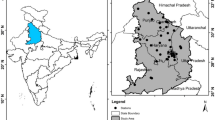
Geospatial View of Air Pollution and Health Risk Over North Indian Region in COVID-19 Scenario
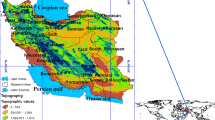
Monitoring, analysis and spatial and temporal zoning of air pollution (carbon monoxide) using Sentinel-5 satellite data for health management in Iran, located in the Middle East
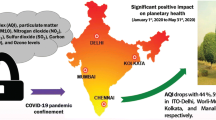
Air quality assessment among populous sites of major metropolitan cities in India during COVID-19 pandemic confinement
Avoid common mistakes on your manuscript.
1 Introduction
Air pollution is a result of intense anthropogenic activities on earth such as transport, industrialization, biomass burning, along with natural causes such as volcanoes and forest fire [ 1 ]. It is reported that the anthropogenic activities contributes approximately 80% increase in the pollution [ 2 ]. Thus reduced human activities would have resulted in a reduced level of air pollutants as observed at the global and regional level during the COVID-19 driven lockdown in 2020 [ 3 , 4 , 5 , 6 , 7 , 8 , 9 , 10 ]. COVID-19 has significantly impacted the socio-economic and environmental conditions of planet earth [ 3 , 4 , 5 , 6 , 7 , 8 , 9 , 10 , 11 , 12 , 13 , 14 , 15 , 16 , 17 , 18 , 19 , 20 , 21 , 22 , 23 ]. COVID-19 is a respiratory disorder of viral origin caused by novel coronavirus or SARS CoV-2 with symptoms of fever, dry cough, and breathing difficulty. The first case of COVID-19 was reported from Wuhan city, China in December 2019 and rapidly spread all across the globe. It has been declared as a global pandemic by the World Health Organisation (WHO) [ 24 ] on 11 March 2020, looking at its contagious nature and death severity (> 3,037,398 deaths worldwide till 22 April 2021). This was further taken as a serious note by the Government of India after the detection of the first case on 30 January 2020 from Kerala, India, which resulted in the three-phase lockdown viz. (1) March 24 to April 14, 2020, (2) April 15 to May 3, 2020, and (3) May 4 to May 17, 2020, over the whole country. The first two phases were strict, while the last one was a relaxed lockdown.
The lockdown has significantly reduces the pollutants concentrations and improved Air Quality by reducing the transport, industrial activities, and other anthropogenic activities all across the globe [ 4 , 6 , 11 , 12 , 13 , 14 , 15 , 25 , 26 ]. Wang et al. [ 15 ] observed a reduction of 36–53% in the concentration of Nitrogen Dioxide (NO 2 ) over six megacities of China. Fang et al. [ 16 ] observed a reduction of 18–45%, 17–53%, 47–64%, 9–34%, and 16–52%, respectively for particulate matters 2.5 (PM 2.5 ), particulate matters 10 (PM 10 ), NO 2 , Sulfur Dioxide (SO 2 ) and Carbon Monoxide (CO), over urban agglomerations in China, during lockdown period relative to pre-lockdown period. Mendez-Espinosa et al. [ 17 ] reported a reduction of 60%, 44%, and 40% respectively in the concentration of NO 2 , PM 10 , and PM 2.5 over South America during the strict lockdown amid COVID-19. Siddiqui et al. [ 6 ] reported a total of 46% reduction in average NO 2 values and 27% improvement in (Air Quality Index) AQI values over the eight cities of India due to COVID-19 driven lockdown. However, a complete study on the effect of COVID-19 driven lockdown on air pollutants, AQI, and ER% is lacking particularly for Haryana, India, though required on an urgent basis looking at the lethality of disease (a total of 6% of global deaths in India till 22 April 2021, and Haryana is among the most affected states) possibly due to the consistent high pollution level [ 1 , 6 , 27 , 28 , 29 ]. Aerosol Optical Depth (AOD) which is a key parameter of air quality (which indicates column integrated particulate matters) gets reduced in response to COVID-driven lockdown [ 26 ]. Similarly AQI is a range of index values that indicates the air quality (Good = 0–50, Satisfactory = 51–100, Moderate = 101–200, Poor = 201–300, Very Poor = 301–400, and Severe = 401–500) of a location or region significantly get reduces during lockdown [ 30 ]. ER% which is the excess health risk associated with the pollutants level excess than the standard concentration [ 5 , 28 ] also gets reduces in response to lockdown. Since the values of air pollutants, AQI, and ER% have been identified as one of the serious threat to human health (9 out of 10 people breathe air containing high levels of pollutants, 7 million deaths annually, and 12.5% of the total deaths worldwide), and environment at global and local scale [ 24 , 31 , 32 , 33 , 34 , 35 ] their reduction may reduce the health risk and improve the environmental quality. It is also reported that the areas with high air pollution levels were found to be affected more with COVID-19 and its severity [ 6 , 29 ]. Thus, it is the need to identify the hotspot of air pollution and take necessary actions to combat it on an urgent basis, so that the risk of COVID-19 like diseases may be reduced in the future [ 17 , 18 , 19 , 36 ].
Ground-based monitoring stations provide data for the assessment of pollution level and its hotspot. Setting up ground-based stations with the capability to measure these criteria pollutants require huge maintenance, operating manpower, and a huge amount of money which is not realistic at least in Indian conditions [ 1 ]. Thus, it is required to use low-cost technologies and surrogate variables like AOD from satellite that can provide relevant information about air pollution and pollutant level for further AQI and ER% assessment. Satellite-based assessment of air quality parameters (such as AOD, PM 2.5 , PM 10 , SO 2 , NO 2 , CO, and CH 4 ) is found to be a potential way of regular and cost-effective monitoring of these pollutants at a spatial scale [ 1 , 4 , 6 , 37 , 38 , 39 ].
The goal of reducing pollutant levels by 20 to 30% till 2024 (as decided in National Clean Air Programme, NCAP) from its base year 2017 was observed to be a tough task, looking into the requirement of economic growth and industrialization. However, COVID-19 driven lockdown has shown glimpses of reduced air pollution in 2020 worldwide, including India [ 4 , 6 , 11 , 12 , 13 , 14 , 15 , 25 , 26 ]. Though, the assessment of effect of COVID-19 driven lockdown on air quality both at global [ 11 ] and regional [ 4 , 6 , 11 , 12 , 13 , 14 , 15 , 25 , 26 ] scale taking ground [ 5 , 15 ] and satellite-based [ 4 , 6 , 12 ] observations are available, no study reported the satellite-based AQI and ER% assessment over any region of the globe and over the Indian region (Haryana) in particular. Furthermore, there is no reported study for the validations of Sentinel-5P satellite-based pollutant products concerning ground observations which gives novelty to the current work. We compared the satellite-based concentrations of various air pollutants/indicators including AOD, PM 2.5 , PM 10 , SO 2 , NO 2 , CO, and CH 4 in the month of April 2019 (no lockdown) and 2020 (completely falling within the strict lockdown period in India) to understand the effect of lockdown on the concentrations of these pollutants/indicators. The study is taken up with the following key objects: (1) Validation of satellite-derived air pollutants using ground-based observations, (2) Assessment of the state of air pollutants using these validated satellite-based measurements, (3) Utilisation of these measurements for the assessment of AQI and ER%.
2.1 Study area
The study area (Haryana state) is situated in the northern part of India and bounded within the latitude of 27.64258158 to 30.90568992 and longitude of 74.46724953 to 77.53797611 (Fig. 1 ). The geographical area of the state is 44,212 km 2 with a total population of 25,350,000. Haryana has two major physiographic regions: (a) the flat alluvial plain covering most of the state and (b) a strip of the highly dissected Shiwalik range in the North-East (including the narrow foothill zone). The Haryana state falls in the Indo-Gangetic region which is always high in air pollutant concentration level [ 6 , 31 , 40 , 41 , 42 , 43 ].
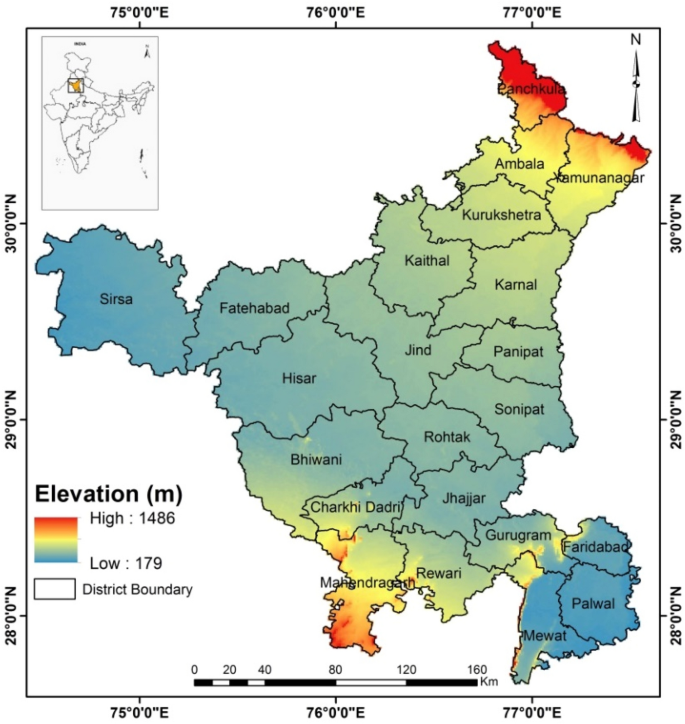
Study Area representing the state of Haryana
2.2 Method in brief
For this study, the two phase methodology was adopted. PM estimation is being done (through a regression analysis using Ground-based PM and Satellite-based AOD) in the first phase, and AQI and ER% were generated (over Haryana through the validated Sentinel-5P pollution products including NO 2 , SO 2 , CO, and CH 4 and estimated PM) in the second phase. Two times data (Table 1 ) were selected based on COVID-19 driven strict lockdown i.e. during (April 2020) and prior to this (April 2019).
The satellite-based pollutant concentrations were validated with respect to ground-based pollutant concentrations at 23 stations. After confirmation of the accuracy of satellite-derived pollutant parameters, the impact of COVID-19 driven lockdown were assessed taking the % difference into the consideration. Further, AQI were estimated, using these pollutants parameters (PM 2.5 , PM 10 , SO 2 , NO 2 and CO) and a model suggested by CPCB for each cell of 3 × 3 km spatial resolution in ArcGIS 10.6 desktop software. The ER% was also estimated in the same fashion by using existing models [ 5 ]. The impacts of COVID-19 driven lockdown were assessed both for AQI and ER% at the final stage taking % difference into the consideration. Final maps were prepared in ArcGIS 10.6 desktop software. The step-wise method is summarised in Fig. 2 .
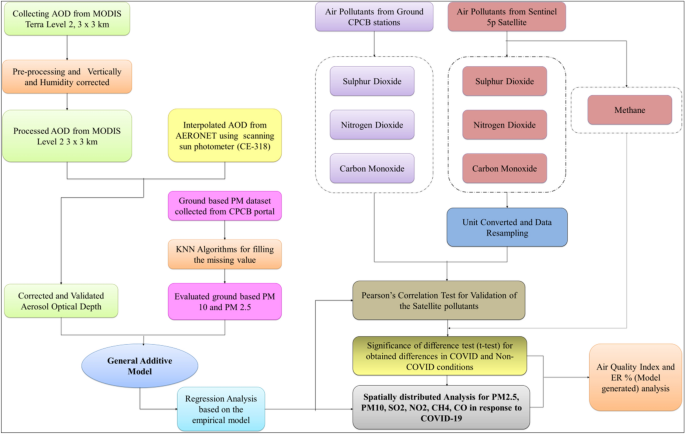
Flowchart of the methodology adopted in this study
2.2.1 Satellite data processing and validation
2.2.1.1 processing.
MODIS AOD product was downloaded from National Aeronautic Space Administration (NASA) Earth explorer web site and pre-processed using MODIS MT tool kit. The pre-processed data were used for statistical analysis and comparison before (April, 2019) and during (April, 2020) lockdown period. Differences obtained in AOD due to COVID-19 driven lockdown was tested with t-test (both one and two tailed at p = 0.05). The validated products of MODIS were used for the prediction of Particulate Matter (PM) concentration.
Sentinel 5P data from TROPOMI were processed using SNAP tool. Data spanning from 1 to 30 April were downloaded for two years i.e. 2019 and 2020 on a daily basis. An average were then made for whole month and compared. Values of satellite-based pollutants (SO 2 , NO 2 and CO) were extracted for each of the ground stations and compared with average values of the ground-based pollutants. Ground data for CH 4 was missing and thus no validation was done for CH 4 .
2.2.1.2 Satellite data validation
Satellite observations from Sentinel-5P represent an aggregated concentration of pollutants in the tropospheric column [ 44 ]. The major problem in the validation of these pollution parameters is their measurement unit which is in mol/m 2 , whereas ground-based observations are provided in µg/m 3 . Similar units are essentially required for the validation of the satellite-based products from ground-based observations. So unit conversion of the satellite data from mol/m 2 to µg/m 3 is done initially. Firstly, we converted mol/m 2 into the part per billion (ppb), so to get an order of magnitude estimate for the ppb value and further divided the values by the height of the troposphere i.e. 10 km (0.1 mol/m 2 /10 km = > 0.00001 mol/m 3 ). Then we use a gas concentration converter to convert the unit from mol/m 2 to mol/m 3 . The whole concept may be summarised following the arithmetic expressions (Eqs. 1 – 4 ) as suggested by [ 45 , 46 ]:
For tropospheric column we have
From Eqs. ( 1 ) and ( 2 ), we have
Now, further the methods for converting ppb into µg/m 3 [ 45 ]:
where M = molecular mass (SO 2 = 64, NO 2 = 46, CO = 28 and CH 4 = 16), T = Surface Temperature (which is taken on average of April month as 32 °C), So putting above value in Eq. 4 , we have,
The data was further normalised using KNN method as suggested by [ 47 ].
For the ground data, the heterogeneity is quite high for validation purposes. So to regularize the data, first, we have to fill in the missing values, so as to have continuous data. For that KNN method was used with a weighted average of the nearest neighbour values. The Eq. ( 5 ) used for that is mentioned below [ 47 ]:
where \(\hat{y}\) = predicted value for the missing values, \({y}_{i}\) = real valued target as training data for ith observation, \(k\) = KNN scale factor.
After the filling of the missing value, the data was ready for validation. This has also been suggested that a process called scaling may provide more reliable results for validation. Thus, the Scaling was performed using the method suggested by Patro and Sahu [ 48 ] however, the final results were presented with normalized data only to maintain the consistency of the units of the pollution parameters. For the validation we have used correlation method in R software (R 4.0.5 for Windows). Correlation is a bivariate analysis that measures the strength of association between two variables and the direction of the relationship. Ground data from 23 ground stations and relative point value depicted from satellites are taken as input data.
2.2.2 Assessment of impact of COVID-19 on air pollutants
Satellite-based pollutant concentration for PM 2.5 , PM 10 , SO 2 , NO 2 , CO and CH 4 were obtained for the April month for the year 2019 and 2020 at each ground station. Further, the significance of differences obtained in the pollutant concentration at each station were tested using t-significance test in microsoft excel for conforming our null hypothesis. Average of all the locations were then estimated for concluding the over all reduction in the pollutant concentration over the study area due to COVID-19 driven lockdown. District-wise statistics was also estimated for the assessment of impact of COVID-19 driven lockdown on average concentration of pollutants at district-level.
2.2.3 Calculation of air quality index (AQI)
Standard model suggested by CPCB [ 30 ] has been used for the calculation of AQI. The criteria pollutants from satellite based measurements including PM 2.5 , PM 10 , SO 2 , NO 2 and CO were used for AQI estimation. The average pollutant concentration at each location (23 representing districts of the Haryana) were collected from satellite data only and subjected to the criteria set by CPCB for Indian conditions. The AQI of the year 2019 for each station were then compared with the respective AQI of the year 2020 and differences were tested using t-test of significance. The formula used for AQI is presented as Eq. 7 [ 30 ]:
where I HI = AQI Value Corresponding of the B HI , B HI = Greater Breakdown Concentration, I LO = AQI Value Corresponding of the B LO , B LO = Smaller Breakdown Concentration, C p = Concentration of Pollutant, 1…n = Pollutants taken.
Similar criteria [i.e. 30 ] were used for the spatial mapping of AQI. The sentinel-5P data were resampled to a grid of 3 × 3 km spatial resolution from its original 7 × 7 km using the nearest neighbour method so that it can be processed with the MODIS-derived PM2.5 and PM10. Each grid of 3 × 3 km for all the criteria parameters (including PM 2.5 , PM 10 , SO 2 , NO 2 , and CO) was then used for the AQI calculation after their conversion to a point feature. The estimated AQI associated with point feature were then converted to a surface of 3 × 3 km spatial resolution using Kriging interpolation techniques as suggested by Saniei et al. [ 49 ].
2.2.4 Calculation of ER%
The ER% is an indicator of health risk and originates due to an increase in air pollution level or increase in the value of AQI. The estimation of ER% is a two-step process, where the first step includes the calculation of relative risk (RR%), and the second step involves the estimation of ER% [ 5 , 31 ] following Eqs. 7 , 8 , and 9 .
where RR i is the Relative Risk of pollutant i , β i is the exposure–response coefficient of additional health risk (Such as mortality) caused by per unit of pollutant i , when it exceeds a threshold concentration (0.038, 0.032, 0.13, 3.7, and 0.081 for PM 2.5 , PM 10 , NO 2 , CO, and SO2 respectively). C i is the concentration of the pollutant i and C i,0 is the threshold concentration ((35, 50, 40, 2, and 50 for PM 2.5 , PM 10 , NO 2 , CO, and SO 2 respectively) of pollutant (when threshold concentration of pollutant is less than the pollutant concentration then the relative risk is greater than 0). ER i is the excess risk for individual pollutants and ER total is the excess risk associated with all the pollutants. The spatial mapping of ER% was done with a similar process as adopted for the AQI in this study.
3 Results and discussion
Satellite-based air quality assessments in terms of pollutant concentrations, AQI, and ER%, were done using satellite measurements in COVID-19 (April 2020) and NON-COVID (April 2019) scenarios over Haryana, situated in the Northern part of India. The selection of period was done, with the assumption, that the COVID-19 driven lockdown would have resulted in the reduction of pollutant level in the study area as reported for other parts of the world [ 9 , 14 , 15 , 18 , 19 , 25 , 26 ]. Validation showed a high correlation between satellites measured concentration of air pollutants with that of ground-based pollutants (r 2 = > 0.5, p = 0.00). This indicates the potential of satellite-based products for regular air quality monitoring and ER% assessment. Our findings regarding the reduction in air pollution concentration due to COVID-19 driven lockdown were consistent with Ranja et al. [ 4 ], Sharma et al. [ 5 ], Siddiqui et al. [ 6 ], Sur et al. [ 12 ], and Singh and Nanda [ 27 ], among others. Objective-wise descriptions of results are described in forthcoming sections.
3.1 Validation of satellite derived pollutants
The validation results are presented in Fig. 3 a–f and Table 2 respectively, for AOD, PM 2.5 , PM 10 , SO 2 , NO 2 , and CO. Validation for CH 4 could not be done due to the lack of ground data related to CH 4 . Results showed consistently significant agreement between satellite-derived pollutants and ground-based pollutants.
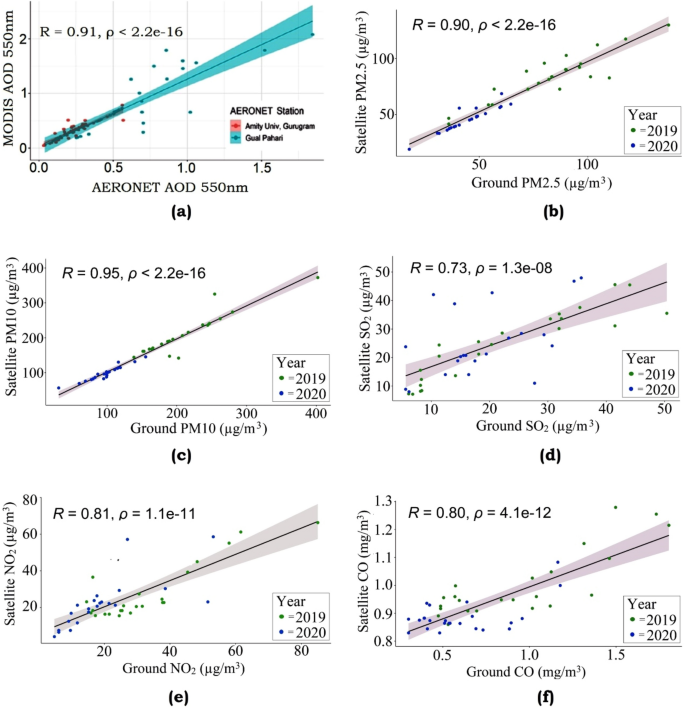
Scatter plots for the validation of satellite derived parameters with ground measurements during April 2019 and 2020: a AOD (2016–2019, Goswami et al., 2020, Red dots presents Amity University, Gurgram and Blue dots presentsGual Pahari, Gurgram Locations), b PM2.5, c PM10, d SO2, e NO2, f CO
3.2 Variation in satellite based air pollutants in response to lockdown
Variations in the concentration of air pollutants are presented in Fig. 4 a–g. State-level statistics for all the Pollutants for 2019 and 2020 are presented in Table 4 and a decrease/increase in the concentrations (as a result of COVID-19 driven lockdown) is presented in Table 5 . Pollutant-wise concentration variations are described in forthcoming sub-sections.
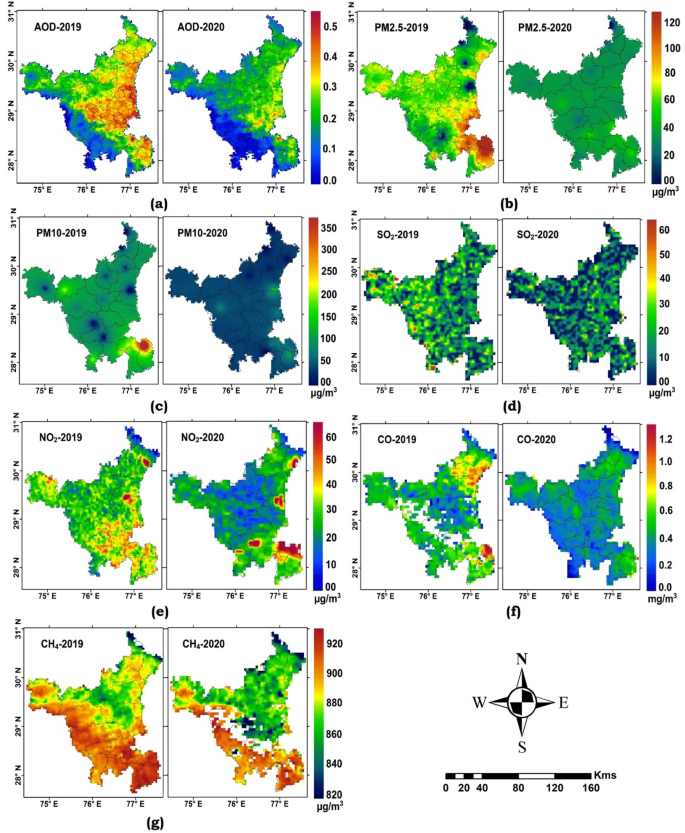
Spatial varition in average conectartion of pollutants during April 2019 (left), and 2020 (right): a AOD, b PM2.5, c PM10, d SO2, e NO2, f CO, g CH4
3.2.1 AOD variations
AOD is an indicator of air pollution. Industrial activities, transport, and biomass burning along with the natural dusty air current from the desert are the central sources of AOD over the study area. The AOD showed varying patterns over Haryana (Fig. 4 a). The AOD for April month were ranging from 0 to 1.35 for both 2019 to 2020. Relatively high AOD were obtained in the National Capital Region (NCR) districts of Haryana for both years [ 27 ]. However, in the year of lockdown, the AOD concentration was very less as compared to the AOD concentration in 2019 (Fig. 4 a).
The average AOD in the April month of the year 2019 was 0.626 ± 0.07 with a minimum of 0.073 (in Mahendragarh district) and a maximum of 0.947 (in Kaithal district). The average AOD in the same month of the year 2020 during lockdown was 0.386 ± 0.058 with a minimum − 0.05 (in Bhiwani district) and a maximum of 0.651 (in Sonipat district). Both the average and standard deviation (SD) were less during the lockdown period, and the average was significantly reduced ( p = 0.05), showing the reduced level of pollutant gasses in the atmosphere during the lockdown. A total of 38% decrease was observed in average AOD due to COVID-19 lockdown (Table 3 ).
High AOD concentration over Haryana is attributed to the contribution of agriculture practices, crop residue burning, vehicular pollution, and natural dusty wind, among others [ 4 , 27 , 28 ]. The range of previous year AOD and mean concentration of last four years (also reported in another study by Goswami and Singh [ 56 ]) were higher than the current year. However, in 2020, the AOD decreased by 38% as compared to the previous year. Similar results have been reported by Ranjan et al. over Indian region [ 4 ]. The low AOD values are attributed due to the COVID-19 driven lockdown. Reduced vehicle movement, reduced agriculture practices, and reduced burning of biomass have created the total decrease in AOD [ 4 , 27 ]. Our findings show consistency with Ranjan et al. [ 4 ], Sharma et al. [ 5 ], and Singh and Nanda [ 27 ].
3.2.2 PM 2.5 and PM 10 variation
The PM 2.5 was ranging from 17.34 to 129.6 µg/m 3 . PM 2.5 concentration was found to be higher during April 2019 as compared to April 2020 (Fig. 4 b). The average concentration of the PM 2.5 for the year 2019 (without lockdown) was 106 ± 4.527 µg/m 3 . At the same time, the PM 2.5 concentration for the year 2020 (during lockdown) was 47.5 ± 1.64 µg/m 3 . This showed a total of 55% reduction in the level of PM 2.5 due to lockdown (Table 4 ). Faridabad was found to be with high PM 2.5 concentration.
Satellite-based PM10 showed high agreement with ground-based data, similar to other studies of [ 1 , 29 ]. The PM 10 was ranging from 48.29 to 372.45 µg/m 3 . The PM 10 concentration was found to be higher during April 2019 as compared to the concentration of PM 10 in April 2020 (Fig. 4 c). The average concentration of the PM 10 for the April month of the year 2019 (without lockdown) was 283 ± 8.5 µg/m 3 . At the same time, the PM 10 concentration for the April month of the year 2020 (during lockdown) was 109.5 ± 3.6 µg/m 3 . This showed a total of 61% reduction in the level of PM 10 due to lockdown (Table 4 ). The PM 10 concentration was found to be very high over the Faridabad area in the year 2019.
PM 2.5 and PM 10 showed a 55% and 61% decrease in concentration due to lockdown. Similar reduction in the PM 2.5 and PM 10 were observed in Baghdad [ 9 ], Malaysia [ 19 ], South America [ 17 ], and China [ 26 ] among others. The major source of PM 2.5 and PM 10 in this region is the natural dusty wind, vehicle emissions, industrial emissions, and stubble burning [ 10 , 27 , 28 ]. The districts that fall in the NCR region (i.e. Faridabad, Gurugram, Jhajjar, and Sonipat) showed high PM 2.5 values even in the lockdown scenario [ 27 ]. This may be due to the limited movement of vehicles in these regions along with agriculture residue burning which is prevalent during this period in normal years.
3.2.3 SO 2 variation
SO 2 were found to be consistently higher and spatially variable in non-COVID scenario i.e. in the April month of the year 2019, as compared to April 2020 (Fig. 4 d). The effect of COVID-19 driven lockdown on SO 2 concentration was seen in the form of a reduction of 31%. The average SO 2 in the April month of the year 2019 was 23.7 ± 7.85 (µg/m 3 ) and for April 2020 it was 16.5 ± 7.03 (µg/m 3 ).
A significant reduction of 31% ( p = 0.00) was observed in SO 2 over the region, during COVID-19 scenario. The reduction is attributed to the lockdown as most of the industrial activities, vehicular movements, and Brick cline operations were stopped during COVID-19. Similar reductions (19.51%) in the SO 2 concentration were observed over South and South East Asian region due to lockdown amid COVID-19 [ 20 ].
3.2.4 NO 2 variation
NO 2 was also found to be higher in the non-COVID scenario (Fig. 4 e). The NO 2 values were ranging from 20.02 (µg/m 3 ) to 61.14 (µg/m 3 ) with an average 20.94 ± 3.75 (µg/m 3 ) for April 2019 which get reduced by 10% to reach an average of 18.77 ± 3.93 (µg/m 3 ) for April 2020. The difference in mean concentration was significant ( p = 0.05).
NO 2 also showed a decrease in concentration and results were following other studies from across the world such as Siddiqui et al. and Sur et al. [ 6 , 12 ] in India, Dantas et al. [ 13 ] in Brazil, Brimblecombe and Lai [ 21 ] in China, and Jephcote et al. [ 22 ] in United Kingdom (UK). Though the decrease in NO 2 concentration was significant ( p = 0.05), it decreased less as compared to other pollutants (except CO and CH 4 ). This may be attributed due to the vehicle movements in local areas [ 22 ] for the distribution of facilities to the migrants and low-income group peoples.
3.2.5 CO variation
CO mainly originates from the incomplete combustion of fossil fuel. The spatial distribution of CO concentration was found to be decreasing in the year 2020 (Fig. 4 f). Spatial statistics at the district level show a 5% decrease (Tables 4 and 5 ). Gurugram, Faridabad, and districts near Yamunanagar were having very high CO concentration in April 2019 which gets reduced in the COVID-19 scenario.
CO showed a decrease in concentration by 5% in the strict lockdown scenario. CO was found to be high in the Faridabad district during April month of the year 2019 which get significantly reduced in the April month of the year 2020 by 15%. A similar decrease was observed in the northern districts (Karnal, Kurukshetra, Ambala, and Yamunanagar) of the state. The industrial operations were closed during the COVID-19 lockdown and thus decrease in the pollution level was observed similar to the others [ 21 ]. The decrease in the CO was actual with high confidence at p < 0.00. Further, coal burning in the street restaurant and stubble burning in the open field has also reduced due to COVID-19 driven lockdown, which further reduces the CO concentration over these regions.
3.2.6 CH 4 variation
CH 4 concentration was consistent during the lockdown period at the district level statistics. However, spatial distribution showed higher CH 4 concentration in non-COVID scenario i.e. in the year 2019, especially in Gurugram, Faridabad, and Palwal region. Southern portions were found to be with high CH 4 concentration (Fig. 4 g). Only a 1% decrease was observed in CH 4 due to COVID-driven lockdown.
CH 4 concentration was consistent and a minor reduction (1%) was observed. The southern part of the state had shown high CH 4 in both years. The high concentration of CH 4 over southern-districts may be due to emission from higher livestock populations in the southern part of the Haryana, low-lying wet areas, and prevailing wind direction from North (Paddy belt) to South. Small differences in CH 4 during April lockdown may also be attributed to the missing data in the year 2020.
3.3 Impact of COVID-19 on AQI and ER%
Significant reduction in the AQI and ER% were observed (Figs. 5 , 6 ). Impact of COVID-19 on AQI (Fig. 5 a, b) was seen in the form of reduced values and improved air quality in the April month of the year 2020 (Fig. 5 b) as compared to April 2019 (Fig. 5 a). The average AQI was 176 in the April month of the year 2019 while 99 in April 2020. At the district level, the AQI was moderate to unhealthy (for sensitive groups) (Figs. 5 a, b, 7 a). However, the AQI was consistently higher (> 150) for all the districts in the non-COVID scenario (year, 2019) and at a low to moderate level, i.e. < 100 during the lockdown phase.
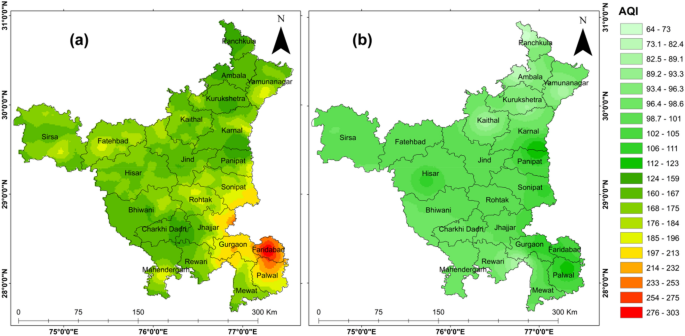
AQI for the month of April, a 2019, and b 2020
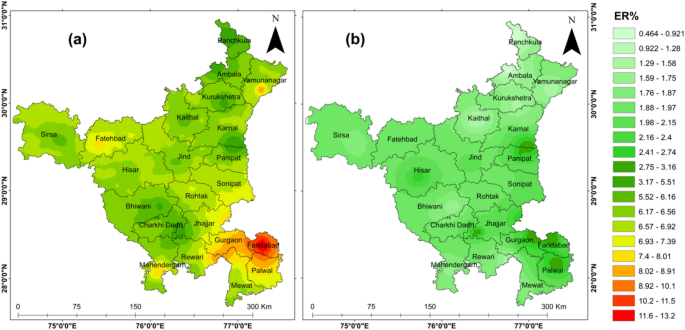
ER% for the month of April, a 2019, and b 2020
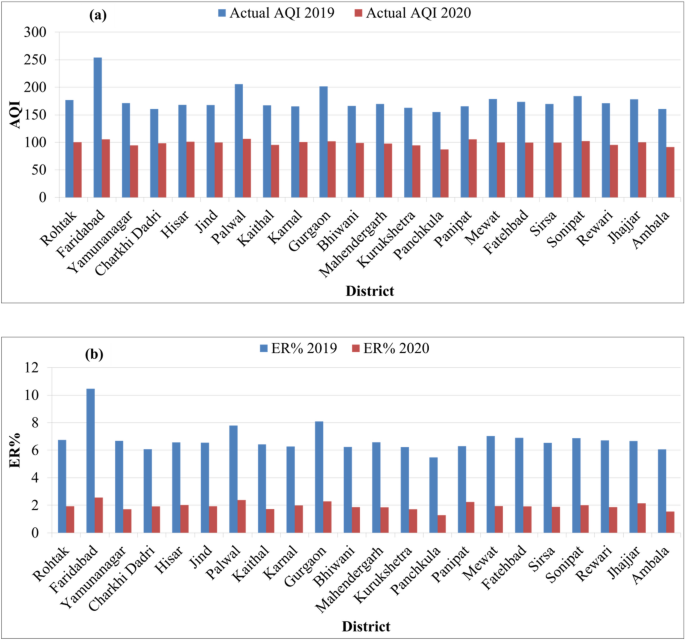
District-wise, a AQI, and b ER%, for entire Haryana, before (blue bars) and during (red bars) COVID-19 lockdown
All the districts have shown a considerable decrease in the ER% due to lockdown amid COVID-19 (Figs. 6 a, b, 7 b). Overall, ER% in the state get significantly reduced ( p = 0.00). We have also observed a hotspot over the Faridabad district, which is an industrial area. High ER% was also observed for Fatehabad, Mahendragarh, and Yamunanagar districts during April 2019. However, the same was not observed for April 2020.
Interestingly, the areas with industries have shown relatively high ER% during the year 2020. This showed that the industrial operations were not stopped during the lockdown period and these areas serve as a hotspot of pollution during lockdown which was otherwise not clear in the year 2019. The AQI, as well as ER%, have shown a gradual decrease i.e. 44% and 71% respectively during the lockdown phase. As we can see in Fig. 6 , the hotspot was shown in the parts of Faridabad during April 2019 and 2020.
This part has been further visualised in Google Earth and concluded that this area consists heavily of industry, causing a release of the high volume of particulate matter and other pollutants, due to which there is a hotspot of AQI and ER% (Fig. 8 ). But still, during the lockdown, these areas have shown a low scale of AQI and decreased considerably from unhealthy to moderate level.
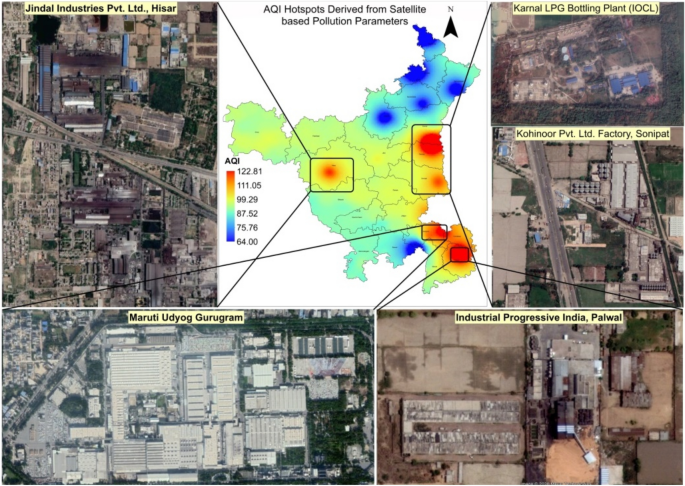
AQI hotspot visible during lockdown period associated with industries in these areas. The industries showed are only representative and the contribution of other sources/industries is combined
AQI completely based on satellite measured products along with the estimation of ER% is the novelty of the current work. A significant ( p = 0.00) reduction (44%) in the AQI values was observed due to the reduction in the concentration of criteria pollutants. Our findings were consistent with the [ 5 , 9 , 20 ]. Most of the region comes near to the satisfactory level of AQI as per the Government norms during the lockdown. Improvement in AQI and ER% was observed in all the districts due to reduced industrial operations, agriculture practices like residue burning, and transport activities as a result of COVID-19 driven lockdown enforcement [ 1 , 5 , 6 , 9 , 10 , 14 , 17 ].
This analysis showed the industrial pollution was prevailing during the lockdown and highlighted the places of industrial operations even in lockdown enforcement conditions. The method proposed in this work is having global importance and can be applied for the regular monitoring of satellite-based AQI and ER% as both the parameters are in high agreement with ground-based estimates.
3.4 Validation of AQI and ER%
We have also validated satellite-based AQI and ER% with ground-based AQI and ER%. A very high correlation was observed between satellite-based AQI and ground-based AQI. The validation results have shown a very good agreement with r 2 > 0.88 and 0.94 for AQI and ER%. The Root Mean Square Error (RMSE) for AQI was 23.05 and for ER% it was 1.12. The correlation plots are presented in Fig. 9 a, b.
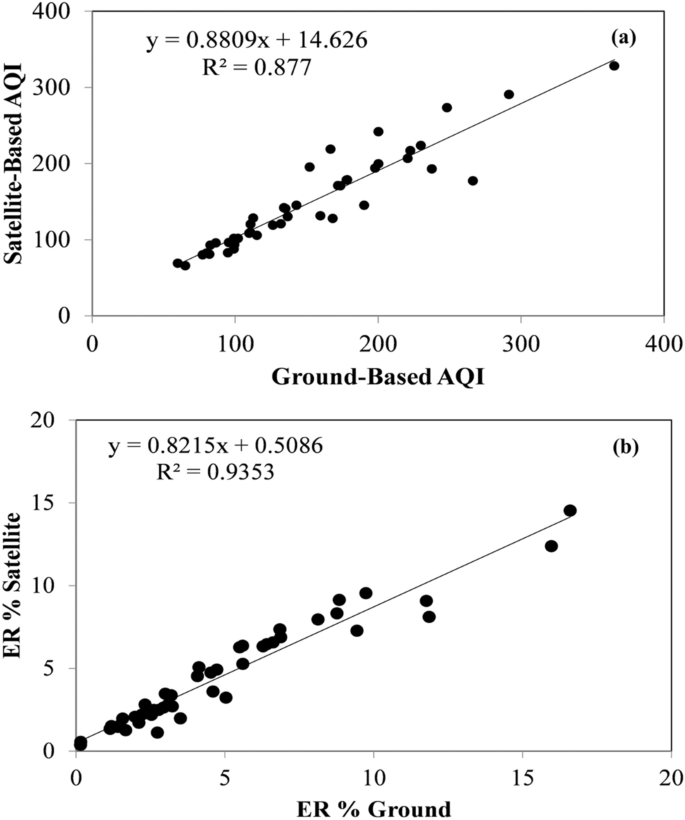
Scatter plot for satellite and ground-based AQI and ER% validation, a AQI and b ER%
4 Conclusions
Based on the analysis of satellite derived air pollutants, AQI, and ER% for April 2019 (non-COVID) and 2020 (with COVID), over Haryana state, India, some of the key conclusions are drown. Significant differences in the concentration of almost all the pollutants were observed due to COVID-19 driven lockdown measures. Highest decrease was observed in PM 10 followed by PM 2.5 , AOD, SO 2 , NO 2 , CO, and CH 4 . Improved air quality (AQI) and Health Risk (ER%) is also resulted from lockdown measures. Satellite data showed a good agreement with ground observations (r 2 > 0.5 for all the pollutants). We consider AQI and ER% assessment as an important aspect of our work, where we have used only satellite derived parameters. Satellite-based AQI showed high correlation and less error (r 2 = 0.88, and low RMSE of 23.05) with AQI estimated from ground-based data. Significant reduction (44%) in AQI values indicates the improvement of air quality of the study area due to the COVID-19 driven lockdown, which is far better than the decided limit (20–30%) of NCAP target. Simultaneously, the ER% derived from satellite-based data also showed decrease of 71% with respected to the previous year’s ER%. The currently identified ER% from satellite-measured parameters showed a very good agreement with ER% calculated from ground-based data with r 2 0.93 and RMSE 1.12. Satellite-based ER% assessed in this study is a novel work and maybe up-scaled to the global scale. It may be beneficial for the health management of the global population.
Singh, D., Dahiya, M., Kumar, R., & Nanda, C. (2021). Sensors and systems for air quality assessment monitoring and management: A review. Journal of Environmental Management, 289 , 112510. https://doi.org/10.1016/j.jenvman.2021.112510
IQAir. (2019). 2019 World air quality report regions and city ranking . Retrieved March 16, 2021 from https://www.iqair.com/blog/report-over-90-percent-of-global-population-breathes-dangerously-polluted-air .
Bao, R., & Zhang, A. (2020). Does lockdown reduce air pollution? Evidence from 44 cities in northern China. Science of the Total Environment, 731 , 139052. https://doi.org/10.1016/j.scitotenv.2020.139052
Ranjan, A. K., Patra, A. K., & Gorai, A. K. (2020). Effect of lockdown due to SARS COVID-19 on aerosol optical depth (AOD) over urban and mining regions in India. Science of the Total Environment, 745 , 141024. https://doi.org/10.1016/j.scitotenv.2020.141024
Sharma, S., Zhang, M., Gao, J., Zhang, H., & Kota, S. H. (2020). Effect of restricted emissions during COVID-19 on air quality in India. Science of the Total Environment, 728 , 138878. https://doi.org/10.1016/j.scitotenv.2020.138878
Siddiqui, A., Halder, S., Chauhan, P., & Kumar, P. (2020). COVID-19 Pandemic and city-level nitrogen dioxide (NO2) reduction for urban centres of India. Journal of the Indian Society of Remote Sensing, 48 (7), 999–1006. https://doi.org/10.1007/s12524-020-01130-7
Srivastava, S., Kumar, A., Bauddh, K., Gautam, A. S., & Kumar, S. (2020). 21-Day lockdown in India dramatically reduced air pollution indices in Lucknow and New Delhi, India. Bulletin of Environmental Contamination and Toxicology, 105 , 9–17. https://doi.org/10.1007/s00128-020-02895-w
Bera, B., Bhattacharjee, S., Shit, P. K., Sengupta, N., & Saha, S. (2020). Significant impacts of COVID-19 lockdown on urban air pollution in Kolkata (India) and amelioration of environmental health. Environment, Development and Sustainability . https://doi.org/10.1007/s10668-020-00898-5
Hashim, B. M., Al-Naseri, S. K., Al-Maliki, A., & Al-Ansari, N. (2021). Impact of COVID-19 lockdown on NO2, O3, PM2.5 and PM10 concentrations and assessing air quality changes in Baghdad, Iraq. Science of the Total Environment, 754 , 141978. https://doi.org/10.1016/j.scitotenv.2020.141978
Somani, M., Srivastava, A. N., Gummadivalli, S. K., & Sharma, A. (2020). Indirect implications of COVID-19 towards sustainable environment: An investigation in Indian context. Bioresource Technology Reports, 11 , 100491. https://doi.org/10.1016/j.biteb.2020.100491
Lal, P., Kumar, A., Kumar, S., Kumari, S., Saikia, P., Dayanandan, A., Adhikari, D., & Khan, M. L. (2020). The dark cloud with a silver lining: Assessing the impact of the SARS COVID-19 pandemic on the global environment. Science of the Total Environment, 732 , 139297. https://doi.org/10.1016/j.scitotenv.2020.139297
Sur, K., Verma, V. K., & Pateriya, B. (2021). Variation of tropospheric NO2 over Indo-Gangetic plain during COVID-19 outbreak in India. Spatial Information Research . https://doi.org/10.1007/s41324-021-00399-1
Dantas, G., Siciliano, B., França, B. B., da Silva, C. M., & Arbilla, G. (2020). The impact of COVID-19 partial lockdown on the air quality of the city of Rio de Janeiro, Brazil. Science of the Total Environment, 729 , 139085. https://doi.org/10.1016/j.scitotenv.2020.139085
Sathe, Y., Gupta, P., Bawase, M., Lamsal, L., Patadia, F., & Thipse, S. (2021). Surface and satellite observations of air pollution in India during COVID-19 lockdown: Implication to air quality. Sustainable Cities and Society, 66 , 102688. https://doi.org/10.1016/j.scs.2020.102688
Shakoor, A., Chen, X., Farooq, T. H., Shahzad, U., Ashraf, F., Rehman, A., e Sahar, N., & Yan, W. (2020). Four-month changes in air quality during and after the COVID-19 lockdown in six megacities in China. Environmental Science & Technology Letters, 7 (11), 802–808. https://doi.org/10.1021/acs.estlett.0c00605
Fan, L., Fu, S., Wang, X., Fu, Q., Jia, H., Xu, H., Qin, G., Hu, X., & Cheng, J. (2021). Spatiotemporal variations of ambient air pollutants and meteorological influences over typical urban agglomerations in China during the COVID-19 lockdown. Journal of Environmental Sciences, 106 , 26–38. https://doi.org/10.1016/j.jes.2021.01.006
Mendez-Espinosa, J. F., Rojas, N. Y., Vargas, J., Pachón, J. E., Belalcazar, L. C., & Ramírez, O. (2020). Air quality variations in South America during the COVID-19 lockdown. Science of the Total Environment, 749 , 141621. https://doi.org/10.1016/j.scitotenv.2020.141621
Tyagi, B., Choudhury, G., Vissa, N. K., Singh, J., & Tesche, M. (2021). Changing air pollution scenario during COVID-19: Redefining the hotspot regions over India. Environmental Pollution, 271 , 116354. https://doi.org/10.1016/j.envpol.2020.116354
Nadzir, M. S. M., Ooi, M. C. G., Alhasa, K. M., Bakar, M. A. A., Mohtar, A. A. A., Nor, M. F. F. M., Latif, M. T., Abd Hamid, H. H., Ali, S. H. M., Ariff, N. M., & Anuar, J. (2020). The impact of movement control order (MCO) during pandemic COVID-19 on local air quality in an urban area of Klang valley, Malaysia. Aerosol and Air Quality Research, 20 (6), 1237–1248. https://doi.org/10.4209/aaqr.2020.04.0163
Roy, S., Saha, M., Dhar, B., Pandit, S., & Nasrin, R. (2021). Geospatial analysis of COVID-19 lockdown effects on air quality in the South and Southeast Asian region. Science of the Total Environment, 756 , 144009. https://doi.org/10.1016/j.scitotenv.2020.144009
Brimblecombe, P., & Lai, Y. (2020). Effect of sub-urban scale lockdown on air pollution in Beijing. Urban Climate, 34 , 100725. https://doi.org/10.1016/j.uclim.2020.100725
Jephcote, C., Hansell, A. L., Adams, K., & Gulliver, J. (2021). Changes in air quality during COVID-19 “lockdown” in the United Kingdom. Environmental Pollution, 272 , 116011. https://doi.org/10.1016/j.envpol.2020.116011
Magazzino, C., Mele, M., & Schneider, N. (2020). The relationship between air pollution and COVID-19-related deaths: An application to three French cities. Applied Energy, 279 , 115835. https://doi.org/10.1016/j.apenergy.2020.115835
WHO. (2020). World health statistics 2020: Monitoring health for the SDGs, sustainable development goals . World Health Organization. Licence: CC BY-NC-SA 3.0 IGO. Retrieved March 16, 2021, from https://apps.who.int/iris/bitstream/handle/10665/332070/9789240005105-eng.pdf .
Environment Protection Agency (EPA). (2019). https://www.epa.gov/so2-pollution/sulfur-dioxide-basics .
Shakoor, A., Chen, X., Farooq, T. H., Shahzad, U., Ashraf, F., Rehman, A., & e Sahar, N., & Yan, W. . (2020). Fluctuations in environmental pollutants and air quality during the lockdown in the USA and China: Two sides of COVID-19 pandemic. Air Quality, Atmosphere & Health, 13 (11), 1335–1342.
Singh, D., & Nanda, C. (2020). Aerosol optical depth (AOD) variation over haryana due to lockdown amid Covid-19 as an indicator of air quality. In 2020 IEEE India geoscience and remote sensing symposium (InGARSS) (pp. 170–172). IEEE. https://doi.org/10.1109/InGARSS48198.2020.9358971 .
Singh, D., Kundu, N., & Ghosh, S. (2021). Mapping rice residues burning and generated pollutants using sentinel-2 data over northern part of India. Remote Sensing Applications: Society and Environment . https://doi.org/10.1016/j.rsase.2021.100486
Malyan, S. K., Kumar, O., Ranjan, R., & Kumar, J. (2018). Understanding units of measurement in agricultural and environmental sciences: A threat to sustainable management of water. ESSENCE International Journal for Environmental Rehabilitation and Conservation, IX (1), 45–51. https://doi.org/10.31786/09756272.18.9.2.207
CPCB. (2015). National Air Quality Index . Retrieved April 20, 2021, from https://app.cpcbccr.com/ccr_docs/FINAL-REPORT_AQI_.pdf .
Hu, X., Zhang, Y., Luo, J., Wang, T., Lian, H., & Ding, Z. (2011). Bioaccessibility and health risk of arsenic, mercury and other metals in urban street dusts from a mega-city, Nanjing, China. Environmental Pollution, 159 (5), 1215–1221. https://doi.org/10.1016/j.envpol.2011.01.037
American Lung Association. (2020). State of the Air 2020 . Retrieved March 16, 2020, from https://www.stateoftheair.org/assets/SOTA-2020.pdf .
WHO. (2018). Retrieved March 16, 2021, from https://www.who.int/news/item/02-05-2018-9-out-of-10-people-worldwide-breathe-polluted-air-but-more-countries-are-taking-action .
Regan, H. (2020). 21 of the World’s 30 cities with the worst air pollution are in India . CNN Health. Retrieved March 16, 2021, from https://edition.cnn.com/2020/02/25/health/most-polluted-cities-india-pakistan-intl-hnk/index.html .
De Vitre, Z. (2019). Air pollution: We aren’t doing enough . Idr Environment June 04, 2019. Retrieved March 16, 2021, from https://idronline.org/air-pollution-we-arent-doing-enough/ .
MoEFCC. (2019). Ministry of environment, forest and climate change—Annual report (Vol. 5). MoEFCC.
Fishman, J., Bowman, K. W., Burrows, J. P., Richter, A., Chance, K. V., Edwards, D. P., Martin, R. V., Morris, G. A., Pierce, R. B., Ziemke, J. R., & Al-Saadi, J. A. (2008). Remote sensing of tropospheric pollution from space. Bulletin of the American Meteorological Society, 89 (6), 805–822. https://doi.org/10.1175/2008BAMS2526.1
David, L. M., & Nair, P. R. (2013). Tropospheric column O3 and NO2 over the Indian region observed by ozone monitoring instrument (OMI): Seasonal changes and long-term trends. Atmospheric Environment, 65 (2), 25–39. https://doi.org/10.1016/j.atmosenv.2012.09.033
Sellitto, P., Bojkov, B. R., Liu, X., Chance, K., & Frate, F. D. (2011). Tropospheric ozone column retrieval at northern mid-latitudes from the Ozone Monitoring Instrument by means of a neural network algorithm. Atmospheric Measurement Techniques, 4 (11), 2375–2388. https://doi.org/10.5194/amt-4-2375-2011
Acharya, P., & Sreekesh, S. (2013). Seasonal variability in aerosol optical depth over India: A spatio-temporal analysis using the MODIS aerosol product. International journal of remote sensing, 34 (13), 4832–4849. https://doi.org/10.1080/01431161.2013.782114
Kaushik, A., Sharma, H. R., Jain, S., Dawra, J., & Kaushik, C. P. (2010). Pesticide pollution of river Ghaggar in Haryana, India. Environmental Monitoring and Assessment, 160 (1), 61–69. https://doi.org/10.1007/s10661-008-0657-z
Prasad, H., Ryan, D. A., Celzo, M. F., & Stapleton, D. (2012). Metabolic syndrome: Definition and therapeutic implications. Postgraduate Medicine, 124 (1), 21–30. https://doi.org/10.3810/pgm.2012.01.2514
Shastri, H., Barik, B., Ghosh, S., Venkataraman, C., & Sadavarte, P. (2017). Flip flop of day-night and summer–winter surface urban heat island intensity in India. Scientific Reports, 7 (1), 1–8. https://doi.org/10.1038/srep40178
European Space Agency (ESA). (2020). Copernicus open access hub . Retrieved August 20, 2020, from https://scihub.copernicus.eu .
SMARTe.org. (2008). Understanding units of measurement (pp. 1–3). Retrieved March 16, 2021, from https://studylib.net/doc/8125002/understanding-units-of-measurement .
Nanda, C., Kant, Y., Gupta, A., & Mitra, D. (2018). Spatio-temporal distribution of pollutant trace gases during Diwali over India. ISPRS Annals of Photogrammetry, Remote Sensing & Spatial Information Sciences , 4 (5). Retrieved March 16, 2021, from https://pdfs.semanticscholar.org/567a/81d685a898317d757d425ee50d3395748d2a.pdf .
Yao, Z., & Ruzzo, W. L. (2006). A regression-based K nearest neighbor algorithm for gene function prediction from heterogeneous data. BMC Bioinformatics, 7 (1), 1–11. https://doi.org/10.1186/1471-2105-7-S1-S11
Patro, S., & Sahu, K. K. (2015). Normalization: A preprocessing stage . Retrieved March 16, 2021, from arXiv preprint arXiv150306462. https://arxiv.org/ftp/arxiv/papers/1503/1503.06462.pdf .
Saniei, R., Zangiabadi, A., Sharifikia, M., & Ghavidel, Y. (2016). Air quality classification and its temporal trend in Tehran, Iran, 2002–2012. Geospatial Health, 11 (2), 213–220. https://doi.org/10.4081/gh.2016.442
Levy, H., Horowitz, L. W., Schwarzkopf, M. D., Ming, Y., Golaz, J. C., Naik, V., & Ramaswamy, V. (2013). The roles of aerosol direct and indirect effects in past and future climate change. Journal of Geophysical Research: Atmospheres, 118 (10), 4521–4532. https://doi.org/10.1002/jgrd.50192
Kaufman, Y. J., Wald, A. E., Remer, L. A., Gao, B. C., Li, R. R., & Flynn, L. (1997). The MODIS 2.1-/spl mu/m channel-correlation with visible reflectance for use in remote sensing of aerosol. IEEE Transactions on Geoscience and Remote Sensing, 35 (5), 1286–1298. https://doi.org/10.1109/36.628795
Levy, R. C., Remer, L. A., Kleidman, R. G., Mattoo, S., Ichoku, C., Kahn, R., & Eck, T. F. (2010). Global evaluation of the collection 5 MODIS dark-target aerosol products over land. Atmospheric Chemistry and Physics, 10 (21), 10399–10420. https://doi.org/10.5194/acp-10-10399-2010
Liu, W., Cai, J., Fu, Q., Zou, Z., Sun, C., Zhang, J., & Huang, C. (2020). Associations of ambient air pollutants with airway and allergic symptoms in 13,335 preschoolers in Shanghai, China. Chemosphere, 252 , 126600. https://doi.org/10.1016/j.chemosphere.2020.126600
Loots, E., Rozemeijer, N. C., Kleipool, Q., & Ludewig, A. (2017, June 1). Algorithm theoretical basis document for the TROPOMI L01b data processor . Retrieved May 7, 2021, from https://sentinel.esa.int/documents/247904/2476257/Sentinel-5P-TROPOMI-Level-1B-ATBD .
Theys, N., Lerot, C., Roozendael, V. M., De Smedt, I., & Yu, H. (2020, June 15). Retrieved May 7, 2021, from https://sentinel.esa.int/documents/247904/2476257/Sentinel-5P-ATBD-SO2-TROPOMI .
Goswami, A., & Singh, D. (2020, unpublished). Characterisation and time-series modeling of AOD over Haryana State, India using satellite measurements (pp. 1–60). Masters thesis, submitted to Sangam University, Rajashthan, India.
CPCB. (2020). Central control room for air quality management—All India . Retrieved August 20, 2020, from https://app.cpcbccr.com/ccr/#/caaqm-dashboard-all/caaqm-landing .
Authors are thankful to ESA and NASA for satellite data. CPCB is also acknowledged for providing ground/stations data. Director, HARSAC is acknowledged for providing lab facilities. Environment and Climate Change Department, Haryana is acknowledged for funding the research (Programme Code: P-31-1-1-3435-03-800-95-51).
Haryana Space Applications Centre (HARSAC), Citizen Resource Information Department, CCS HAU Campus, Hiasr, Haryana, 125004, India
Dharmendra Singh, Chintan Nanda & Meenakshi Dahiya
Correspondence to Dharmendra Singh .
Conflict of interest.
On behalf of all authors, the corresponding author states that there is no conflict of interest.
Publisher's note.
Springer Nature remains neutral with regard to jurisdictional claims in published maps and institutional affiliations.
Rights and permissions
Singh, D., Nanda, C. & Dahiya, M. State of air pollutants and related health risk over Haryana India as viewed from satellite platform in COVID-19 lockdown scenario. Spat. Inf. Res. 30 , 47–62 (2022). https://doi.org/10.1007/s41324-021-00410-9
Received : 27 December 2020
Revised : 10 June 2021
Accepted : 27 June 2021
Published : 21 July 2021
Issue Date : February 2022
DOI : https://doi.org/10.1007/s41324-021-00410-9
- Sentinel-5P
- Health risk
- Find a journal
- Track your research
- Latest News
- Entertainment
- Real Estate
- Paris Olympics Day 1 Live
- Neet UG Result 2024 Live
- CUET UG 2024 Result Live
- India vs Sri Lanka
- Olympics 2024
- The Interview
- Web Stories
- Mumbai News
- Bengaluru News
- Daily Digest

Haryana govt prepares action plan to improve air quality
Stating that air pollution can only be reduced with the inclusive, economical and innovative approach, the chief secretary directed the officers to strictly follow the policy of caqm.
: The Haryana government has prepared an action plan under the policy formulated by the Commission for Air Quality Management (CAQM) for sustainable improvement in air quality in Delhi-NCR region and adjoining areas, chief secretary Sanjeev Kaushal said on Monday.

Stating that air pollution can only be reduced with the inclusive, economical and innovative approach, the chief secretary directed the officers to strictly follow the policy of CAQM and complete their work within the stipulated time period.
He said the objective of the state government is to bring down the level of air pollution by implementing the action plan effectively at the ground level.
Kaushal said that every necessary step is being taken to contain air pollution.
An official spokesperson said in order to reduce the incidents of stubble burning in the state, proper arrangements have been put in place by the agriculture department for crop residue management that includes ex- situ and in-situ management. ENDS
- Terms of use
- Privacy policy
- Weather Today
- HT Newsletters
- Subscription
- Print Ad Rates
- Code of Ethics
- Live Cricket Score
- Cricket Teams
- Cricket Players
- ICC Rankings
- Cricket Schedule
- Shreyas Iyer
- Harshit Rana
- Kusal Mendis
- Ravi Bishnoi
- Rinku Singh
- Riyan Parag
- Washington Sundar
- Avishka Fernando
- Charith Asalanka
- Dasun Shanaka
- Khaleel Ahmed
- Pathum Nissanka
- Other Cities
- Budget 2024 Live
- Income Tax LIVE Updates
- Income Tax Calculator
- Petrol Prices
- Diesel Prices
- Silver Rate
- Relationships
- Art and Culture
- Taylor Swift: A Primer
- Telugu Cinema
- Tamil Cinema
- Board Exams
- Exam Results
- Admission News
- Employment News
- Competitive Exams
- BBA Colleges
- Engineering Colleges
- Medical Colleges
- BCA Colleges
- Medical Exams
- Engineering Exams
- Love Horoscope
- Annual Horoscope
- Festival Calendar
- Compatibility Calculator
- Career Horoscope
- Manifestation
- The Economist Articles
- Lok Sabha States
- Lok Sabha Parties
- Lok Sabha Candidates
- Explainer Video
- On The Record
- Vikram Chandra Daily Wrap
- Entertainment Photos
- Lifestyle Photos
- News Photos
- Olympics Medal Tally
- Other Sports
- EPL 2023-24
- ISL 2023-24
- Asian Games 2023
- Public Health
- Economic Policy
- International Affairs
- Climate Change
- Gender Equality
- future tech
- Daily Sudoku
- Daily Crossword
- Daily Word Jumble
- HT Friday Finance
- Explore Hindustan Times
- Privacy Policy
- Terms of Use
- Subscription - Terms of Use
- Biology Article
- Essay On Air Pollution 200 Words 500 Words
Essay on Air Pollution
Essay on air pollution is a crucial topic for students from an academic perspective. Moreover, an essay is one of the most effective ways to educate students about the plight of nature and the repercussions of human activities. Creating awareness for future generations is important if we have to undo decades of ignorance and neglect.
Furthermore, air pollution essay helps students to realize the gravity of the scenario and enable them to take action. Some as simple as using public transport or even carpooling will help reduce a significant amount of air pollution. Read on to discover how to write an engaging essay on air pollution.
Essay on Air Pollution – Important Points to Note
Please consider adopting the following points when writing an essay on air pollution. These tips are also helpful for other essay topics as well:
- Always begin with an introductory paragraph about the topic, preferably detailing its origin.
- Unless the topic is technical, try to avoid jargons.
- Present content in bulleted points wherever possible
- Insert factual data, such as important dates, places or name wherever possible.
- Avoid writing the content in a large monotonous block of text. Remember to break up the content into digestible chunks
- Always conclude the essay with a closing paragraph.
Essay on Air Pollution – Sample 1 (200 Words)
Air pollution is a serious issue and a cause for major concern in today’s world. A report published in 2014 by the World Health Organisation states that 4.21 million individuals died prematurely in 2012 as a result of air pollution. Air pollution existed much before humans, in the form of volcanic eruptions and forest fires. However, it became much more prevalent after the Industrial Revolution.
Rapid industrial growth, unregulated emissions and a host of other issues significantly contributed to the rise in air pollution. In some cases, the severity of air pollution reached an extent where government intervention was necessary. The Great Smog of London, 1952, was an extreme case of air pollution where visibility was severely hampered. It also caused a host of illnesses and the consequent deaths of countless civilians. In November 2017, the levels of air pollution in Delhi were ten times above the safe limits. For reference, the healthy air quality index is between 0 to 50, but during that particular time period, the air quality index hit 500+. This event is now called the Great Smog of Delhi.
An air quality index of 500 and above indicates that the air is heavily polluted and will cause irreversible lung damage and a host of other illnesses to everyone who is exposed to it. Therefore, to avoid such situations in the future, relevant actions must be implemented.
Essay on Air Pollution – Sample 2 (500 Words)
Air pollution may seem like the result of anthropological activities, however, it has been around even before humans evolved. Places which are naturally arid and have minimal vegetation are prone to dust storms. When this particulate matter is added to the air, it can cause health issues in animals exposed to the dust storms.
Furthermore, active volcanoes pump extremely large amounts of toxic plumes and particulate matter into the atmosphere. Wildfires also pump large amounts of carbon monoxide into the atmosphere and hamper photosynthesis for plants. Even animals, especially ruminants such as cows contribute to global warming by producing large quantities of methane, a greenhouse gas.
However, air pollution was never a major concern until the industrial revolution. Industries grew rapidly, untreated emissions were pumped into the atmosphere, and the rise of automobiles significantly contributed to air pollution. Such activities continued without any restrictions until they started to cause a wide range of repercussions.
In humans, air polluted with contaminants can cause a wide array of illnesses ranging from asthma and bronchitis the various forms of cancer. Air pollution is not only present outdoors; interior air pollution is also a great concern. Recent research has actually found credible evidence that room fresheners have the many compounds within them, some of which are classified carcinogens. This means some of those compounds present in the aerosol has the potential to cause some forms of cancer. Other sources of air pollution can include gases such as carbon monoxide and radon.
Radon, in particular, is quite alarming. It is an odourless, colourless gas that occurs naturally. It is found in the soil as Uranium, which breaks down and eventually turns into radon gas. Radon has limited repercussions on health if exposed to low concentrations, however, when this gas gets trapped indoor, the higher levels of concentration can have wreak havoc or ultimately be lethal. Radon is also reported to be released from building materials such as granite. Exposure to radon causes no immediate health effects, but long term exposure has the potential to cause lung cancer.
Air pollution not only affects the lungs but the central nervous system too. It has been linked to a lot of diseases such as schizophrenia and autism. A study also implied that it can cause short-term memory losses or distortion of memory.
Historically, air pollution has caused many crises with the worst ever being the Bhopal Disaster in 1984. Fatalities were estimated at 3,800, with at least 600,000 injured. Next in severity was the Great Smog of 1952 which formed over London, killing an estimated 4,000 civilians over the course of four days.
Though measures have been taken to reduce the effects of air pollution, a lot of irreversible damage has been done. For instance, the effects of global warming have drastically increased; this is very apparent with the rise in sea levels and melting glaciers. If the ice caps continue to melt, then we will have to face drastic repercussions. Scientists have proposed a hypothetical scenario where the greenhouse effect becomes “uncontrolled.” Here, greenhouse gases build up and temperatures continue to rise steeply. Oceans will start to evaporate, adding more water vapour into the earth’s atmosphere. This intensifies the effect, reaching a point where temperatures are sufficiently high for rocks start sublimating. Though this scenario is hypothetical, some speculate that this phenomenon already occurred on Venus. The supporters of this theory back this up by claiming Venus has an atmosphere composed primarily of carbon dioxide. The theory also explains why Venus has an extremely high surface temperature of 462 degrees Celcius; which is in fact, the hottest planet in the solar system.
Hence, we need to reduce our impact on the planet and make a conscious effort to reduce air pollution. Explore more essay topics or other fascinating concepts by registering at BYJU’S
| BIOLOGY Related Links | |
Leave a Comment Cancel reply
Your Mobile number and Email id will not be published. Required fields are marked *
Request OTP on Voice Call
Post My Comment
It was helpful
Register with BYJU'S & Download Free PDFs
Register with byju's & watch live videos.

Air quality in Haryana
Air quality index (aqi) and pm2.5 air pollution in haryana.
Last update at (local time)
LIVE AQI CITY RANKING
Real-time haryana most polluted city ranking.


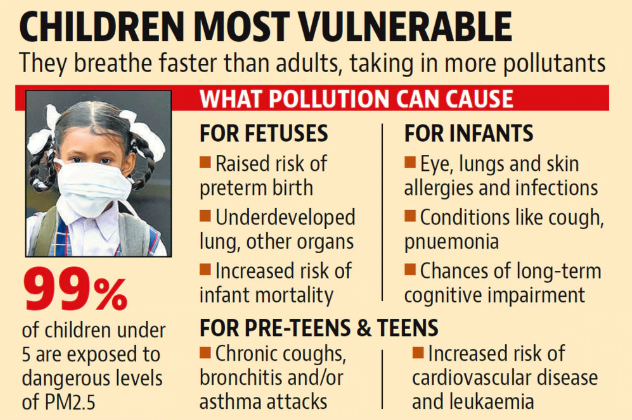


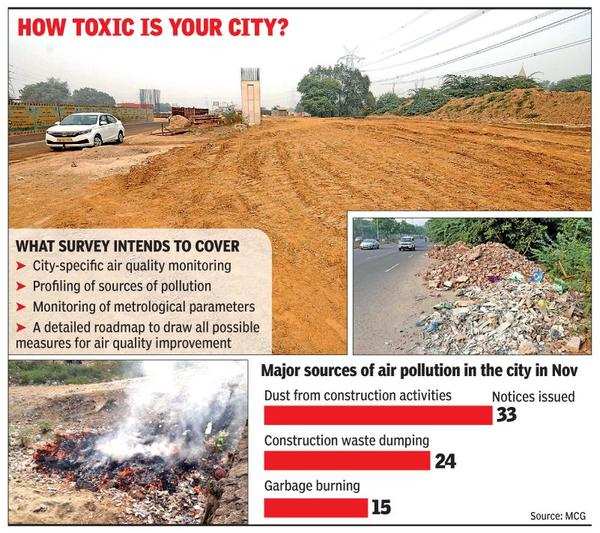
IMAGES
COMMENTS
SeaFair Miami - Miami's Most Luxury Mega Yacht Event Venue - Miami, Florida. SeaFair, offers the ultimate venue where sea and sky converge with the glamour of …
Eventbrite - Seafair presents Seafair is Miami's only 5-star 4th of July Megayacht Experience - Thursday, July 4, 2024 at Seafair Mega Yacht, Miami, FL. Find event and ticket information.
Eventbrite - Seafair presents Seafair is the ONLY 5-star Miami NYE Megayacht Experience - Tuesday, December 31, 2024 | Wednesday, January 1, 2025 at Seafair Mega Yacht, Miami, FL. Find event and ticket information.
Eventbrite - Seafair presents New Year's Eve Most Exclusive & Spectacular Celebration - Seafair Megayacht - Tuesday, December 31, 2024 | Wednesday, January 1, 2025 at Seafair Mega Yacht, Miami, FL. Find event and ticket information.
The 222-ft, $40M SeaFair Mega Yacht is the largest commercial operation ship in the Intercoastal waterway. This uber lux mega yacht offers the ultimate excursion experience; where sea and sky converge with iconic Miami's unique glamour. Designed by the internationally acclaimed yacht designer Luis De Basto, the SeaFair Yacht's multi faceted event spaces make it […]
At Seafair Mega Yachts, we offer more than just a voyage; we present to you The Seafair Experience, a symphony of elegance, opulence, and unforgettable moments. Our $40 million yacht stands as a ...
Come join us for a night of luxury and celebration aboard the Seafair Mega Yacht this 4th of July! Live music, an amazing Hora Loca carnival performance, Caribbean Steel band, DJ, on board Jazz Club, festive food and ever flowing libations.
100% Guaranteed Tickets For All Upcoming Events at SeaFair Mega Yacht Available at the Lowest Price on SeatGeek - Let's Go!
Seafair Megayacht Experience, Miami, Florida. 4,740 likes · 5,717 were here. Seafair offers the ultimate venue where sea and sky converge. With flexible event space, Seafair can be tailored just for...
After all, it's New Year's Eve; and you deserve only the best! Celebrate 2022 in style aboard the SeaFair Miami; a 222-foot, $40M uber lux mega yacht designed by the internationally acclaimed yacht designer Luis De Basto. Times are subject to change pending Miami Curfews. Please make sure Eventbrite is marked as safe sender, you'll only be ...
The Seafair The Only Bespoke Event Mega Yacht Venue in Miami Designed by internationally acclaimed designer Luiz de Basto, the $40M, first-of-its-kind event vessel is one of the largest private yachts in America at 222 feet long.
Get insider info on yacht parties, special event cruises and all you need to know before you come aboard the SeaFair Mega Yacht in Miami, FL.
The prices of event tickets at Seafair Mega Yacht can vary depending on the show, concert, or event happening. To find the event tickets you want and the price, use our search bar above. Where is Seafair Mega Yacht located? Seafair Mega Yacht is located within Miami, United States. The exact postal address is South Dock, 100 Chopin Plaza, Miami ...
8,447 Followers, 1,573 Following, 152 Posts - Seafair Megayacht Experience (@seafairyachts) on Instagram: "Seafair offers the ultimate venue where sea and sky converge. With flexible event space, Seafair can be tailored just for your event."
Based in downtown Miami, SeaFair is unique in the rarified world of "mega-yachts;" loosely defined as privately owned, luxurious vessels at least 200 feet in length. No mere pleasure craft for the ultra-well-to-do, SeaFair instead serves as a venue for corporate events, weddings, holiday parties and other posh gatherings of up to 600 people.
Eventbrite - Seafair presents Seafair is Miami's only 5-star 4th of July Miami Yacht Experience - Thursday, July 4, 2024 at Seafair Mega Yacht, Miami, FL. Find event and ticket information.
Seafair Mega Yacht | 100 Chopin Plz, Miami, FL 33131 Get directions. Seafair 5-Star General Admission Gourmet Presentation. Select Tickets. Hors D"oeuvres (Tray Passed) ... Don't miss out on this exclusive event - book your tickets now! Select Tickets. Limited capacity: Last minute tickets sold at the door will have an extra charge of $50. ...
See photos from Seafair Mega Yacht located in Miami, Florida. Browse photos of real events at Seafair Mega Yacht and contact to schedule a tour and/or get a quote.
Seafair 222′ Luis de Basto. Mega yacht venues. Description; Multiple decks with reception areas and event spaces. The Seafair is a $40M purpose built yacht which is the largest
Flotilla Radisson Royal: Cruises and excursions on Moscow River on river yachts and trams, official website. Cruises all year round, in summer and winter! > Purchase tickets online
The lucky Mega Millions numbers were 28, 30, 44, 66, 69 and Mega Ball 2. The Ohio Lottery says the winning Mega Millions numbers for the $535 million jackpot on Friday, August 23, 2024 were 28, 30 ...
Eventbrite - VIP Nightlife presents New Year's Eve 2024 Miami Fireworks Party Cruise - Seafair Mega Yacht - Sunday, December 31, 2023 | Monday, January 1, 2024 at SeaFair Mega Yacht, Miami , FL. Find event and ticket information.
Interested in this vendor? Pricing information. Located in Miami, Florida, SeaFair Miami is a boat venue that caters to weddings on the water. The 228-foot yacht offers luxe and p
I will be in Moscow on 16th and want to buy high speed Sapsan train ticket to St. Petersburg for 19th. From their website, I can see there are 2 kind of prices - 3413 rub and 5943 rub.